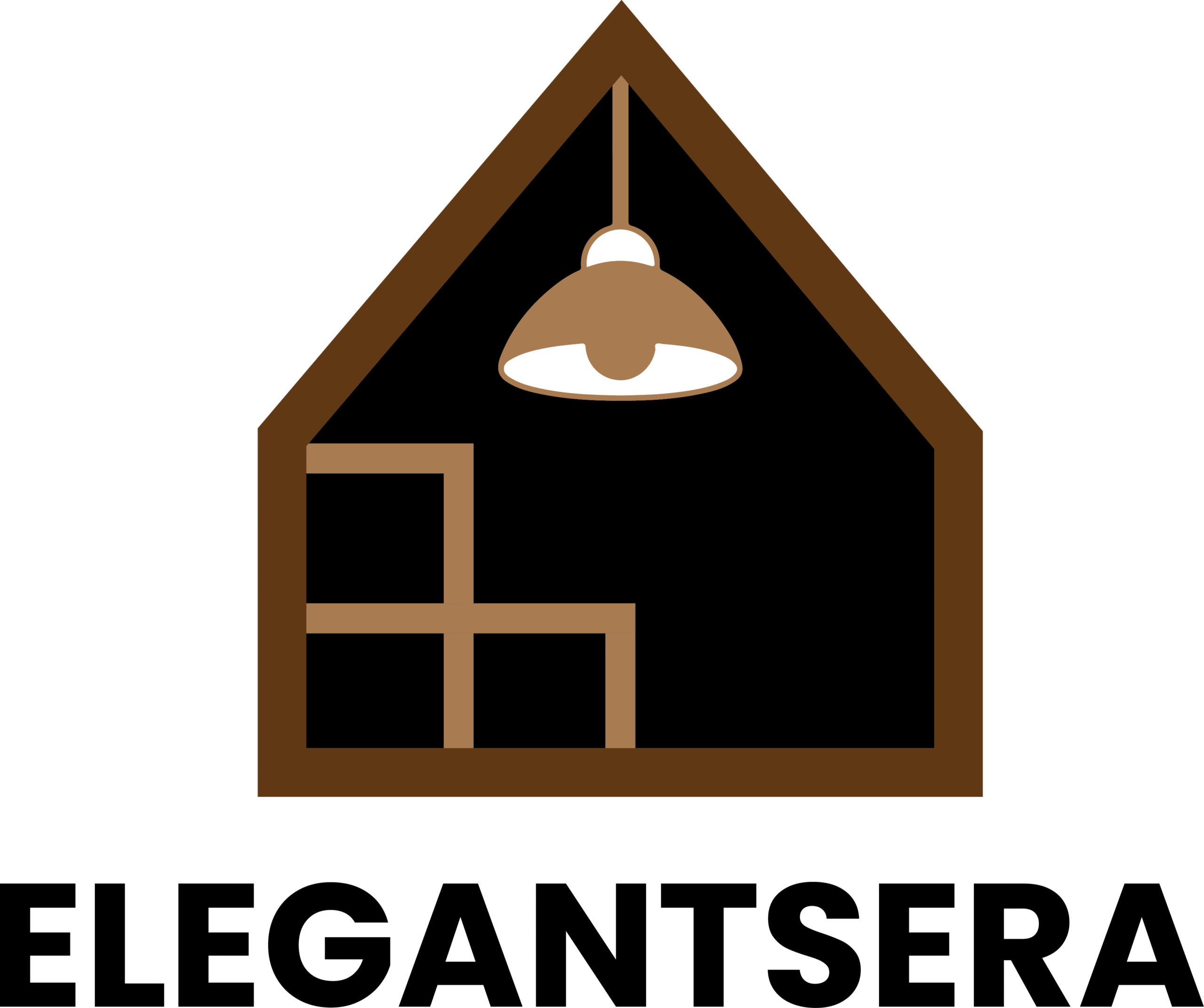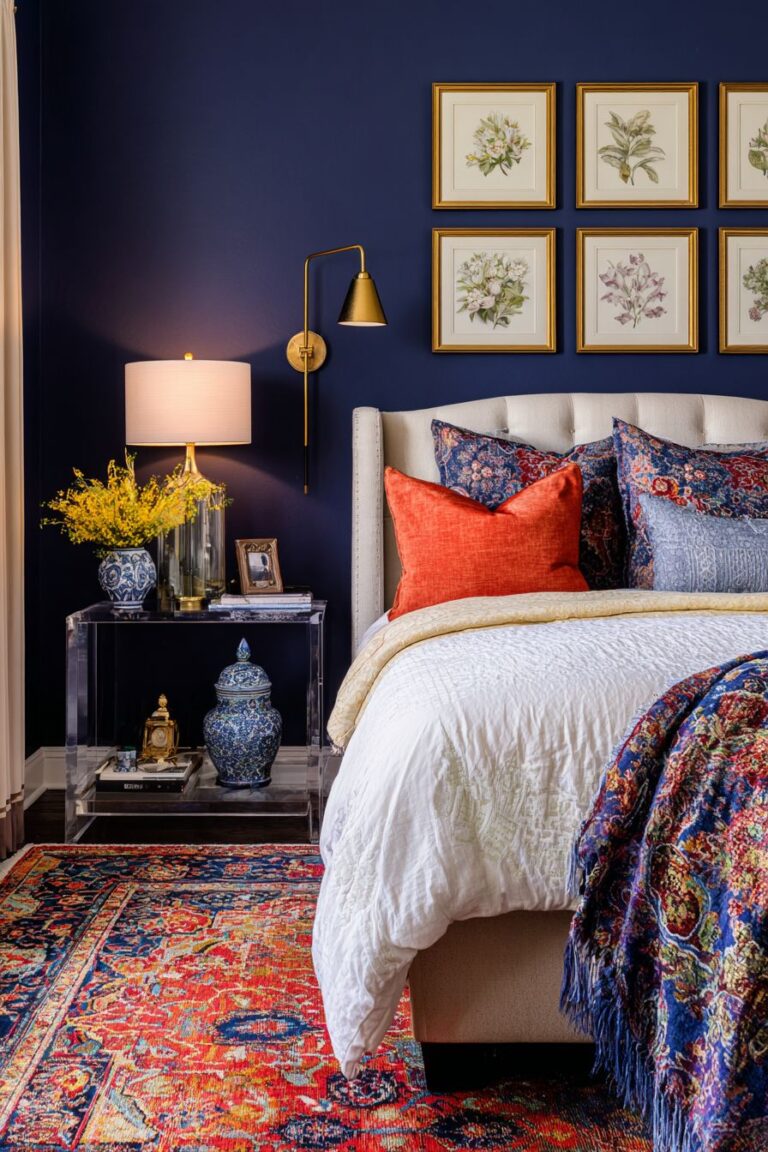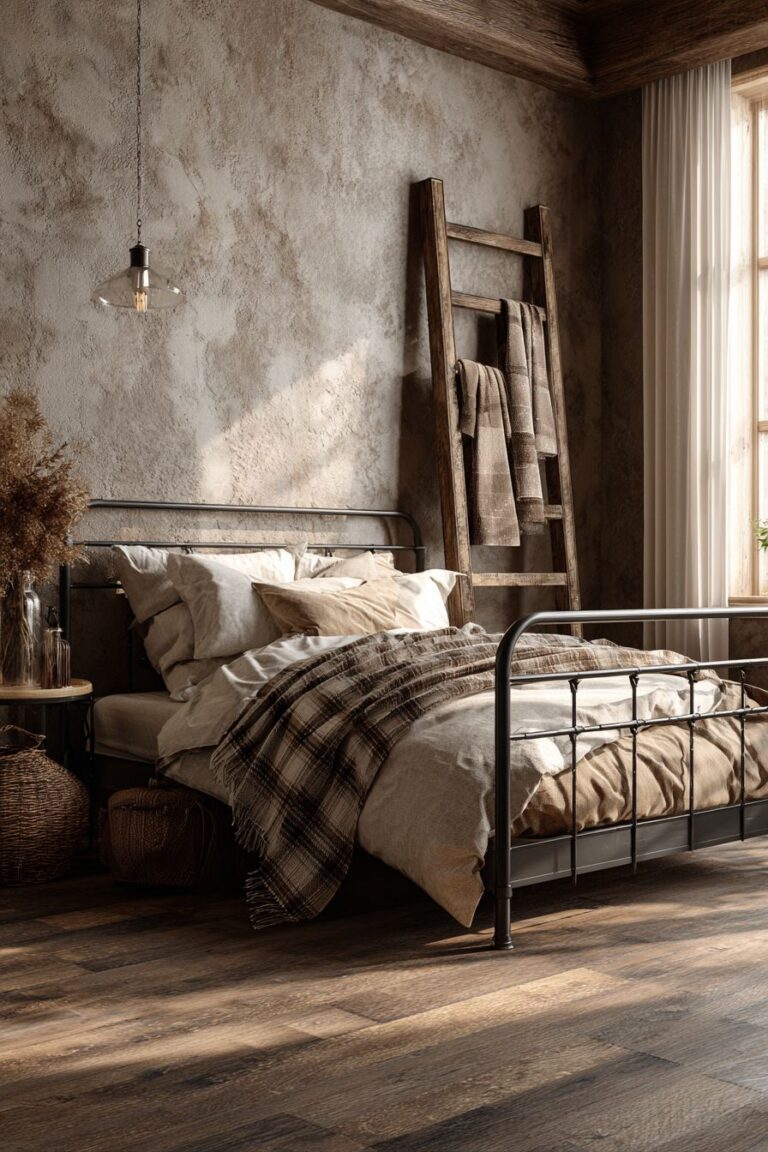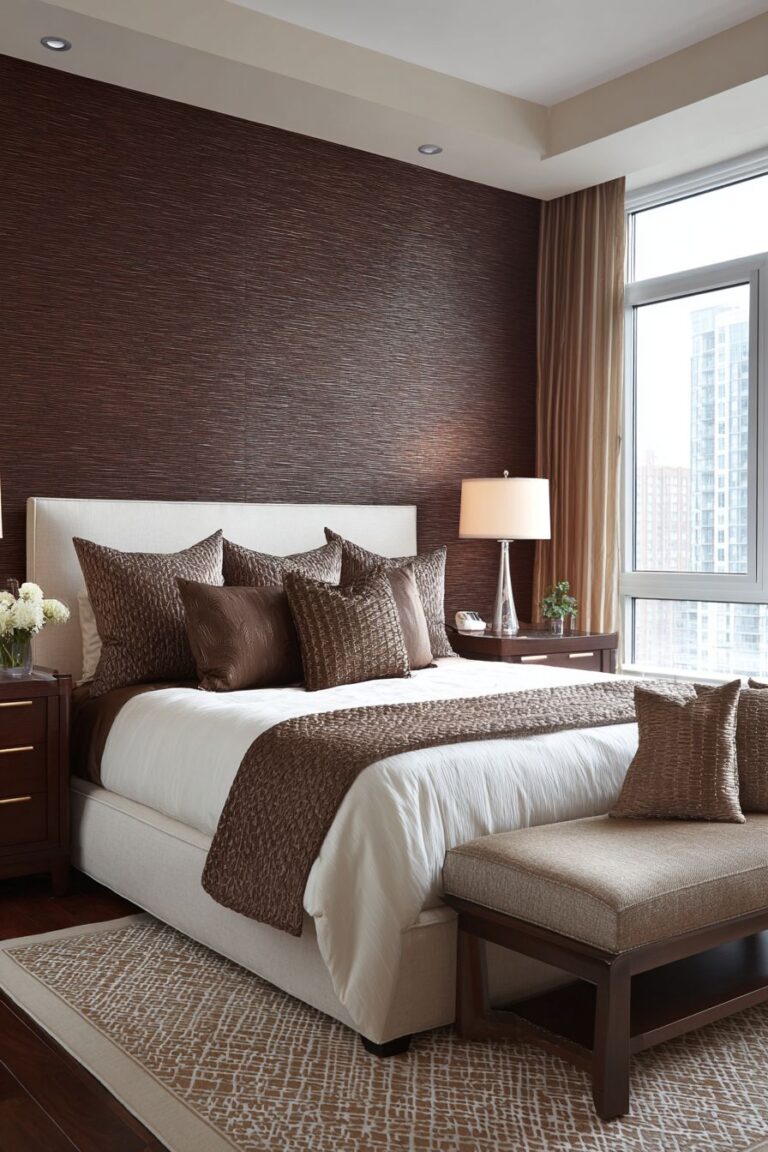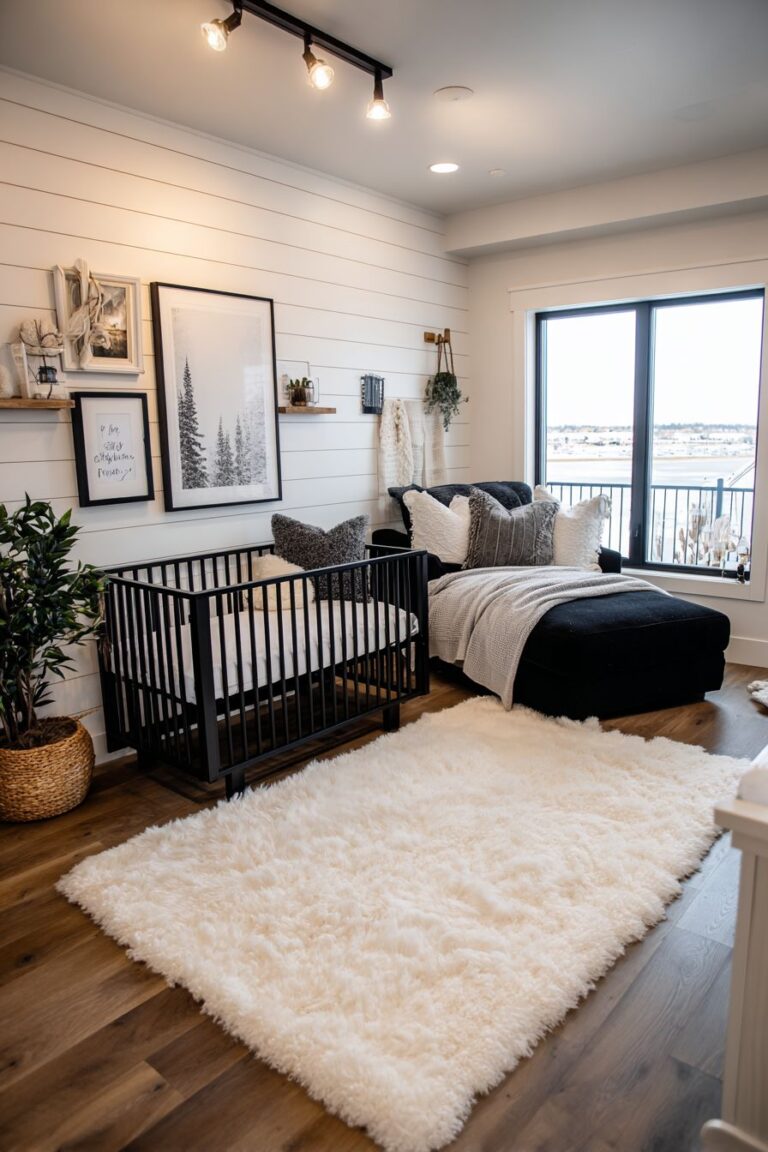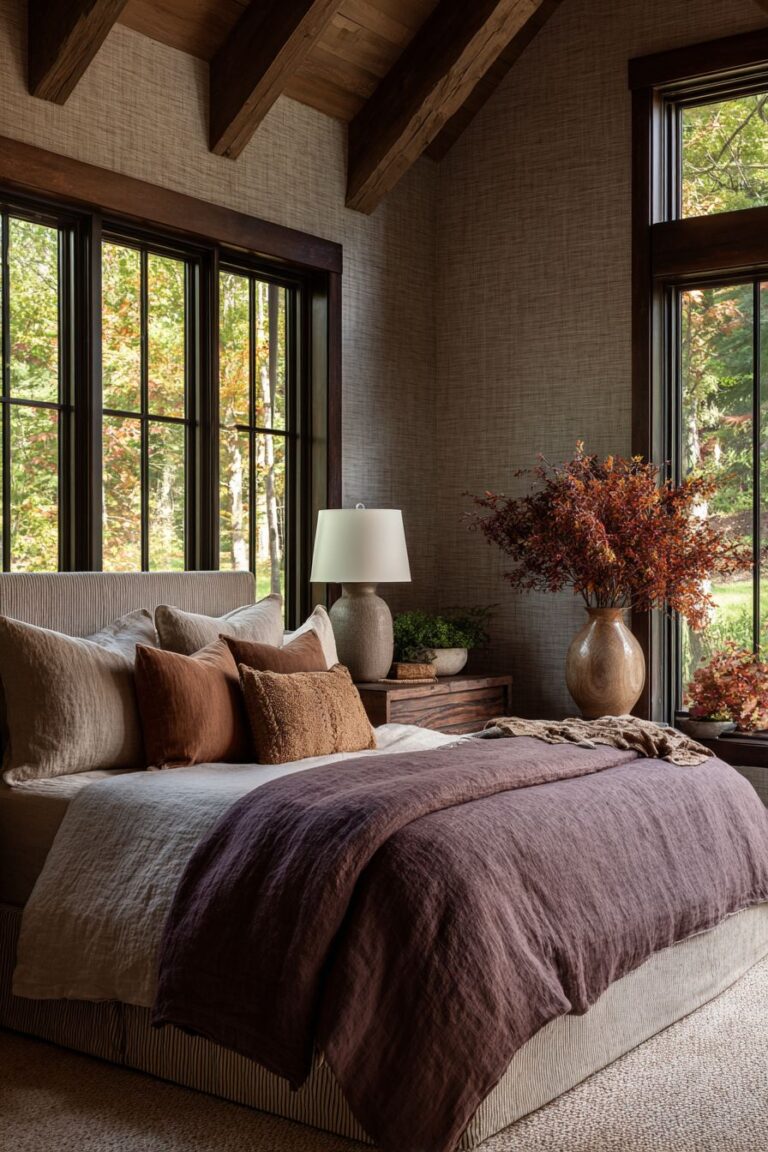2 Single Bed Bedroom Ideas: Transform Your Space With These 20 Inspiring Dual Bed Designs
Creating a bedroom that accommodates two single beds requires thoughtful planning, creative vision, and a keen understanding of spatial dynamics. Whether you’re designing a guest room, a children’s shared space, or a vacation home bedroom, the challenge lies in crafting an environment that feels both cohesive and personal. The beauty of dual single bed arrangements is their remarkable versatility—they offer flexibility for hosting guests, provide children with their own defined spaces, and can be adapted to suit virtually any design aesthetic from minimalist Scandinavian to richly layered bohemian styles.
In today’s world of diverse living arrangements and multigenerational households, the two single bed bedroom has evolved from a purely functional necessity into an opportunity for creative expression. Modern interior design embraces this configuration as a canvas for exploring symmetry, balance, and individual identity within shared spaces. From the clean lines of contemporary minimalism to the warm embrace of rustic farmhouse charm, each approach offers unique solutions to the timeless challenge of creating harmony between two separate sleeping areas while maintaining visual interest and practical functionality.
This comprehensive guide explores twenty distinctive approaches to designing bedrooms with two single beds, each offering its own unique character and charm. From bright Scandinavian simplicity to sophisticated French country elegance, from budget-conscious solutions to luxuriously appointed guest quarters, these ideas demonstrate how thoughtful design can transform any dual-bed bedroom into a space that’s both beautiful and remarkably functional.
1. Bright Scandinavian-Inspired Twin Bed Sanctuary
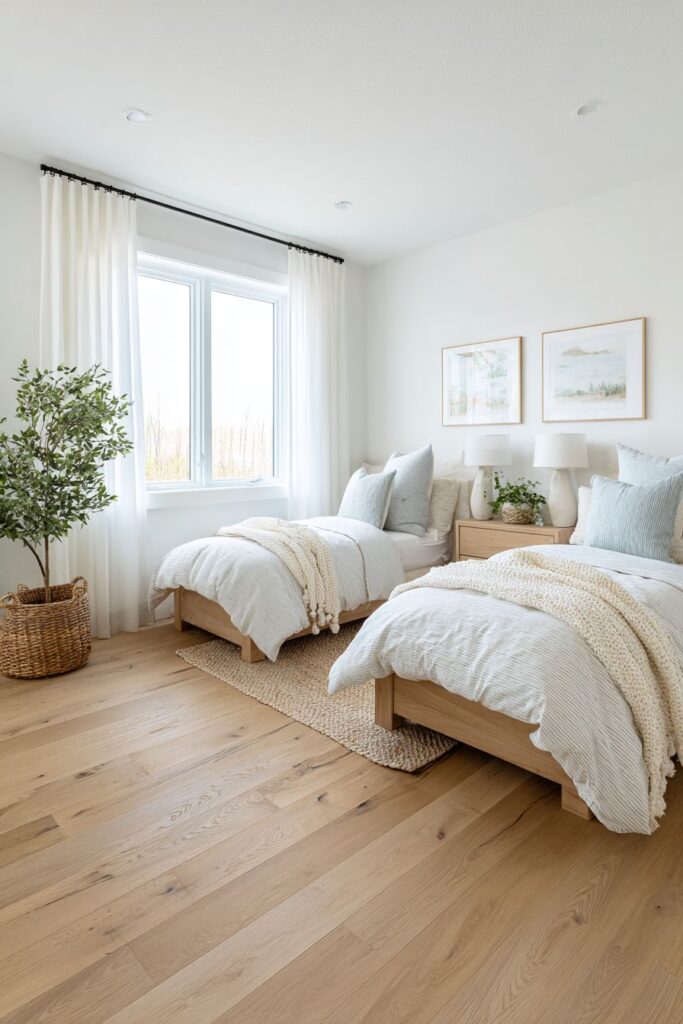
Step into a world of Nordic serenity where two white-painted wooden twin beds create perfect symmetry against opposite walls. The Scandinavian design philosophy shines through in every carefully considered detail, from the natural oak nightstands that gracefully separate the sleeping areas to the simple table lamps that provide gentle illumination. This approach to dual bed design celebrates the principle of “lagom”—the Swedish concept of balance and moderation—creating a space that feels neither sparse nor cluttered, but perfectly harmonious.
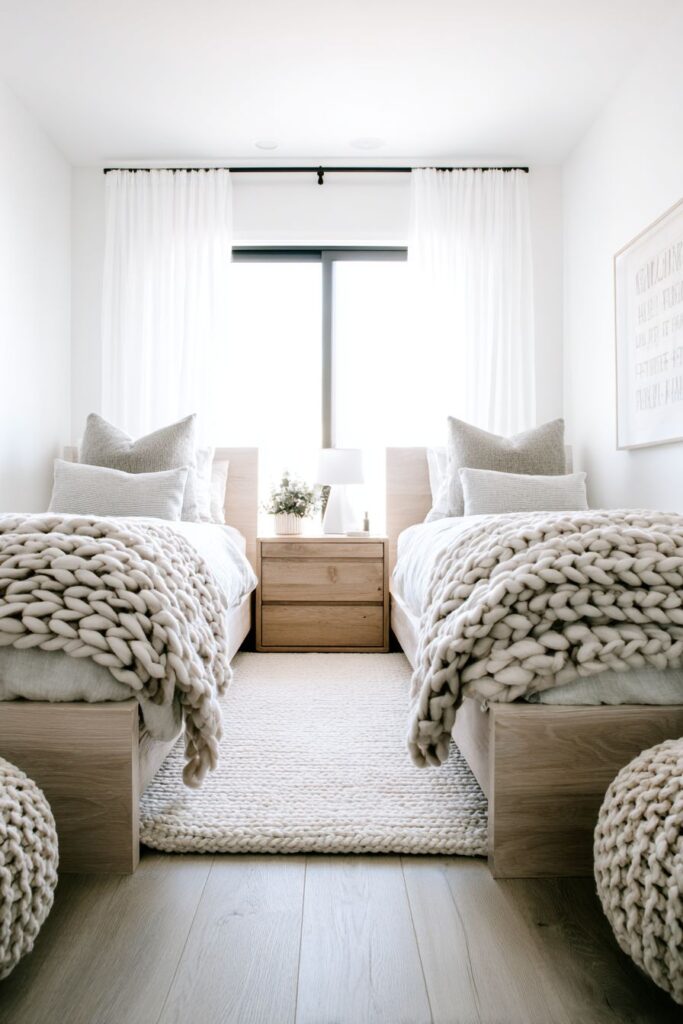
The light grey linen bedding becomes the foundation of comfort in this Nordic retreat, while textured knit throws add dimensional warmth without overwhelming the minimalist aesthetic. The whitewashed wooden flooring extends the bright, airy feeling throughout the room, reflecting natural daylight that filters through sheer white curtains. These translucent window treatments are essential to the Scandinavian approach, allowing soft natural light to fill every corner while maintaining privacy and creating an ethereal quality that changes throughout the day.
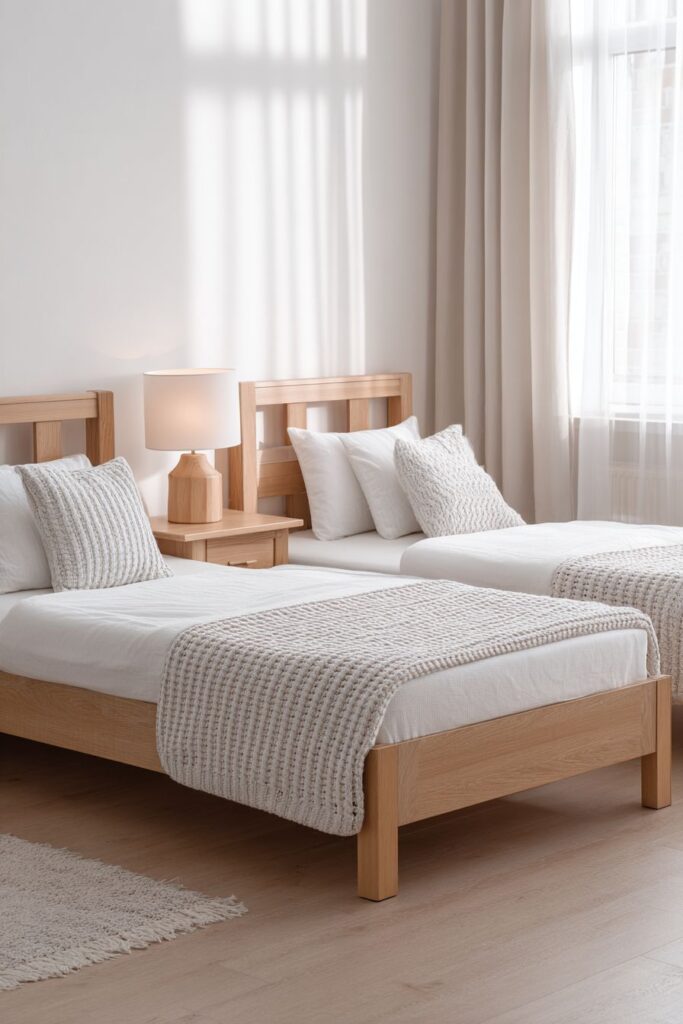
The symmetrical layout of this design serves both aesthetic and practical purposes. By positioning the beds parallel to each other, the room achieves visual balance while maximizing floor space in the center—perfect for movement and additional furnishings if needed. The clean, minimalist aesthetic isn’t just about visual appeal; it creates a sense of calm and order that promotes restful sleep and peaceful mornings. This is particularly valuable in shared bedrooms where visual clutter can feel overwhelming to multiple occupants.
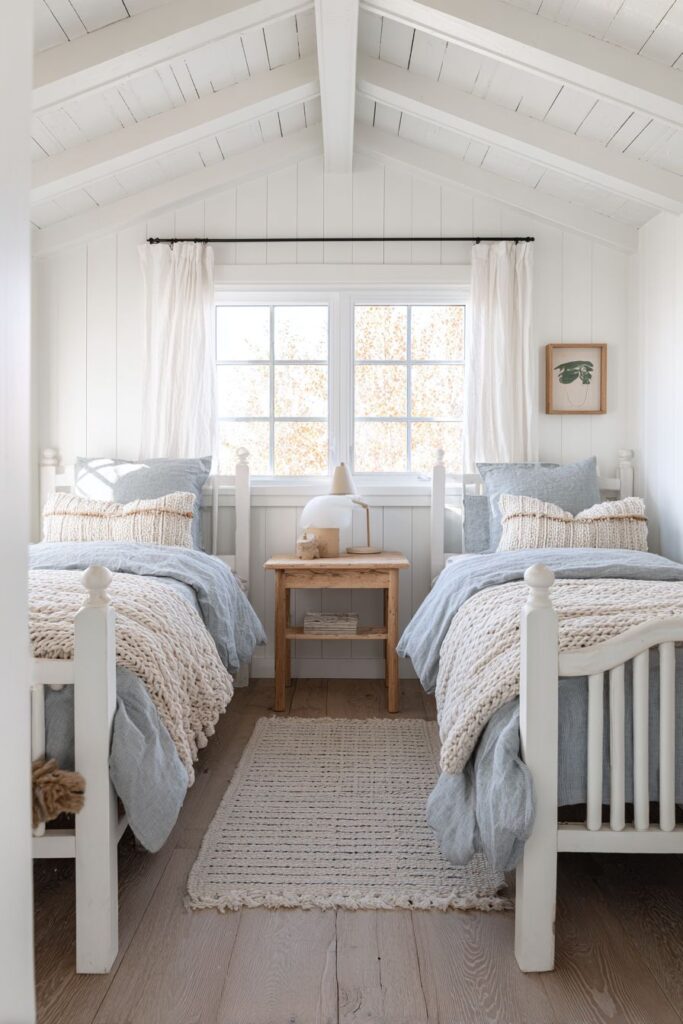
Key Design Tips:
- Choose white-painted wood furniture to maximize light reflection and create an airy atmosphere
- Layer different textures in similar neutral tones to add depth without introducing color chaos
- Position beds symmetrically to create visual harmony and equal personal space for each occupant
- Use sheer curtains to maximize natural light while maintaining privacy
- Select simple, functional lighting that serves purpose without dominating the design
- Incorporate natural oak or light wood accents to warm the predominantly white palette
2. Coastal-Themed Nautical Twin Bedroom
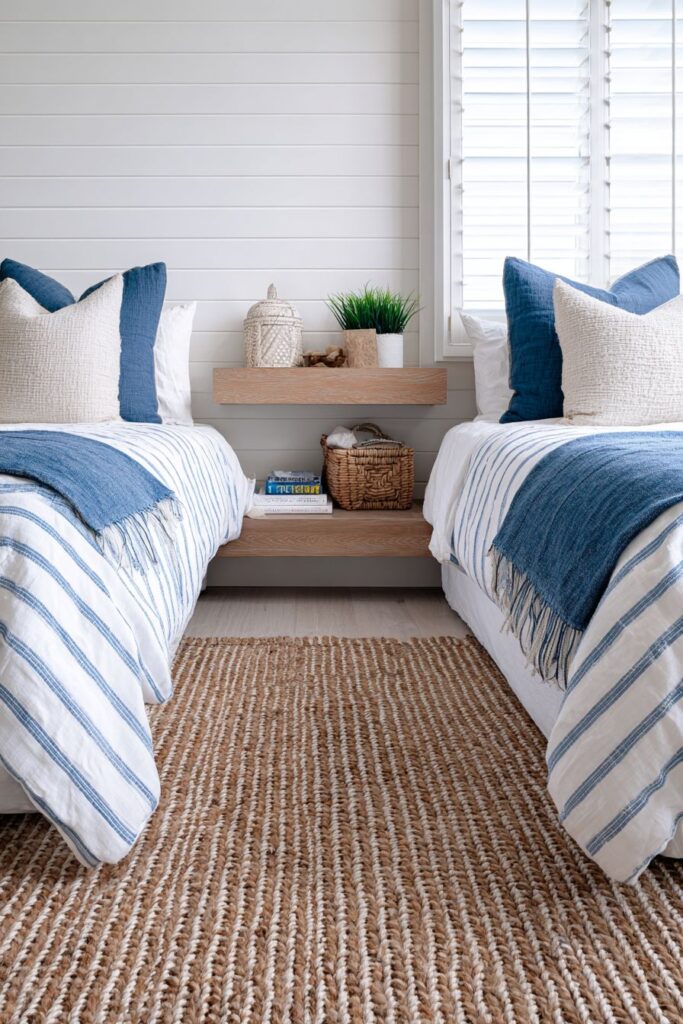
Imagine waking to the essence of seaside living, where two twin beds dressed in navy blue and white striped bedding evoke the timeless charm of maritime tradition. This coastal-themed approach to dual bed design captures the relaxed sophistication of beachside cottages and yacht club elegance. The crisp contrast between deep navy and pristine white creates visual interest while maintaining the calm, soothing atmosphere associated with oceanside living.
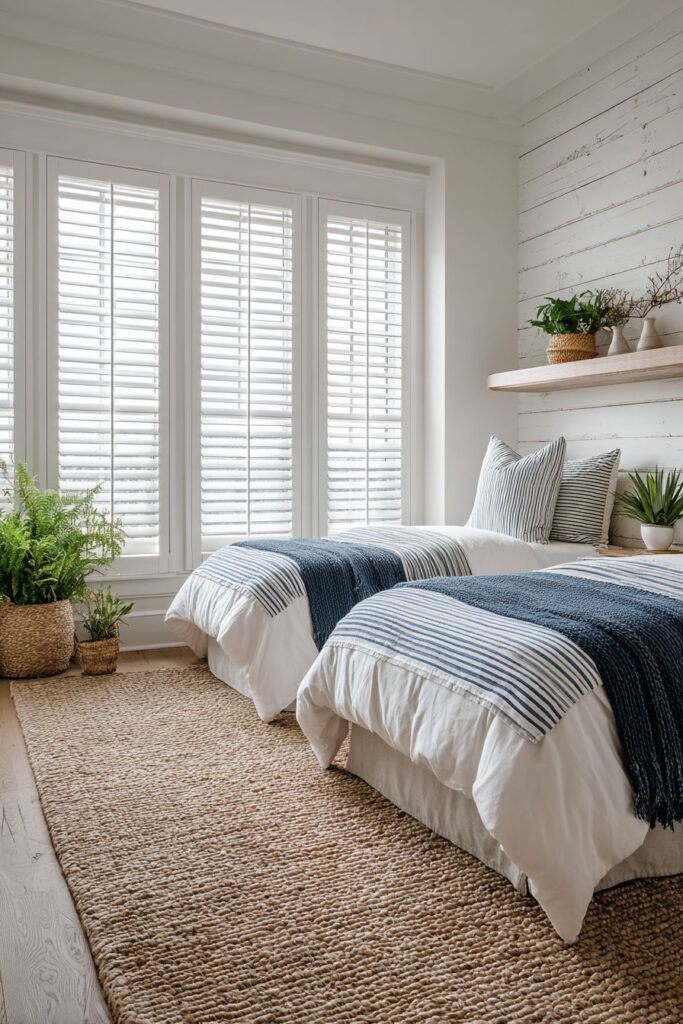
The whitewashed shiplap accent wall behind the beds serves as the design’s anchor, adding architectural interest and authentic nautical character. This horizontal planking creates subtle texture and depth, transforming a simple wall into a focal point that tells a story of coastal living. Between the beds, a shared floating shelf serves the dual purpose of nightstand for both occupants, demonstrating how smart design can maximize functionality in limited space while maintaining the clean lines essential to coastal aesthetics.
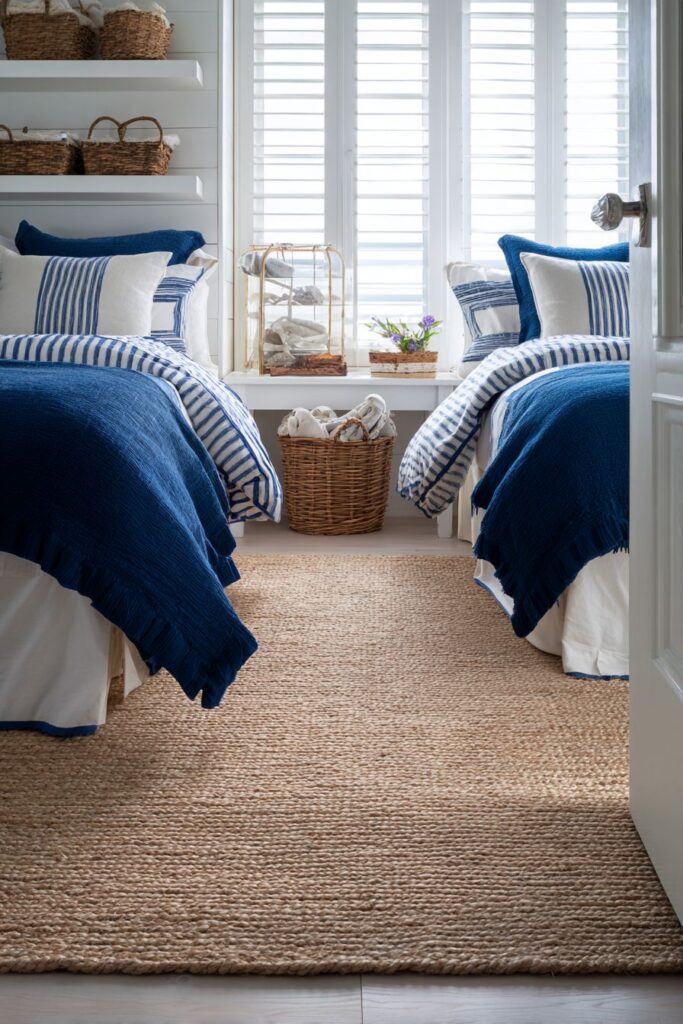
Natural jute rugs ground the space with organic texture, their sandy tones echoing beach dunes and creating warmth underfoot. The plantation shutters controlling natural light are both practical and stylistically appropriate, allowing precise adjustment of morning sunlight while reinforcing the coastal cottage atmosphere. The overall palette—dominated by whites, navy blues, and natural materials—creates a space that feels perpetually fresh, like a sea breeze flowing through open windows.
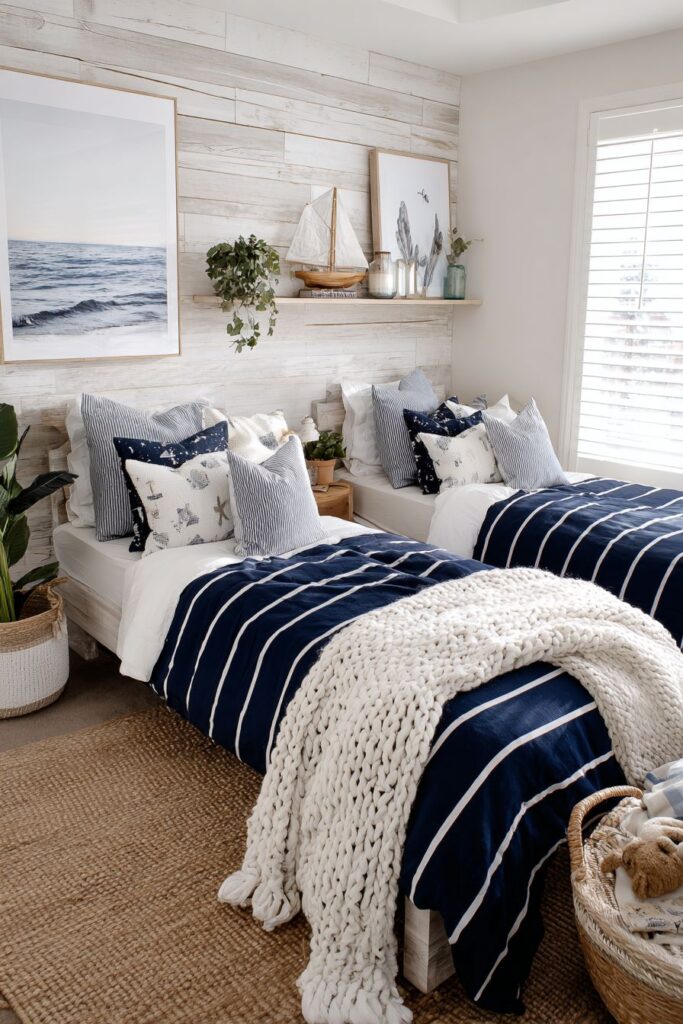
Key Design Tips:
- Use striped bedding in classic navy and white to establish immediate coastal identity
- Install whitewashed shiplap or beadboard for authentic nautical architectural detail
- Incorporate natural fiber rugs like jute or sisal for organic texture and coastal warmth
- Choose plantation shutters for light control that complements the beach house aesthetic
- Select a shared floating shelf between beds to maximize space efficiency
- Add subtle nautical accents like rope details or anchor motifs without overwhelming the design
- Keep the color palette limited to blues, whites, and natural tones for cohesive coastal appeal
3. Modern Farmhouse Rustic Twin Bedroom

The modern farmhouse aesthetic brings together the best of both worlds—the warmth and character of rural tradition with the clean functionality of contemporary design. In this dual bed configuration, two metal-framed twin beds with distressed white finishes create the perfect foundation for a style that’s both approachable and refined. The deliberately weathered appearance of the frames tells a story of heritage and authenticity while maintaining the simplicity that defines modern design.
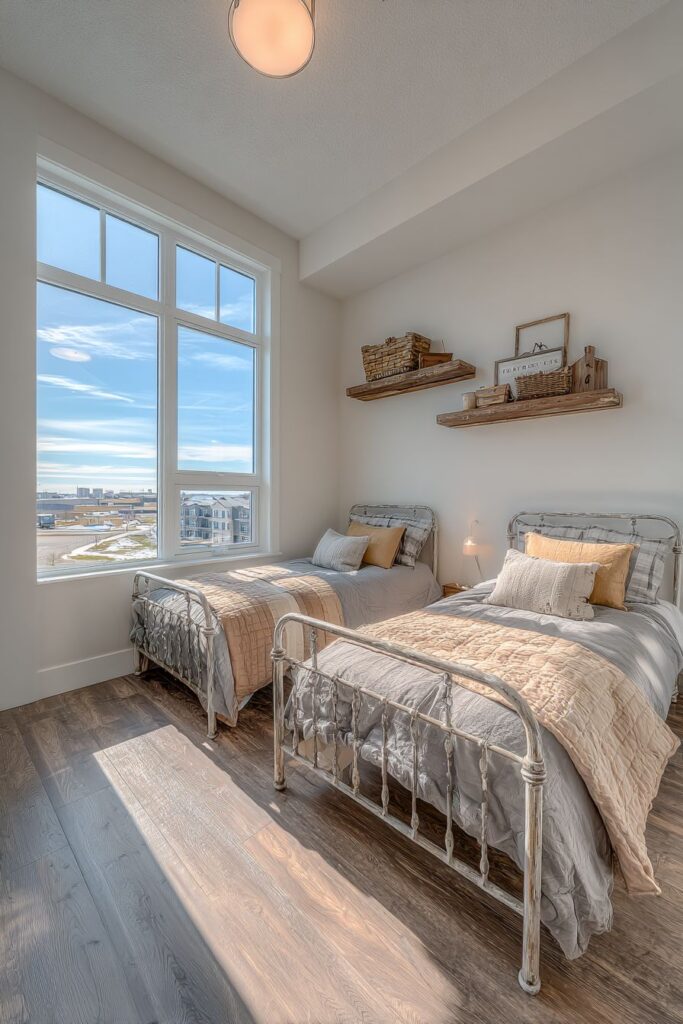
Layered bedding in soft greys and creams with quilted coverlets adds sophisticated comfort to each sleeping area. This neutral palette is fundamental to the modern farmhouse approach, creating calm and cohesion while allowing architectural and textural elements to shine. The quilted coverlets introduce traditional craftsmanship and tactile interest, their subtle patterns and stitching adding depth without visual noise. Above each bed, reclaimed wood floating shelves provide personalized storage while introducing the raw, organic materials that give farmhouse design its distinctive character.
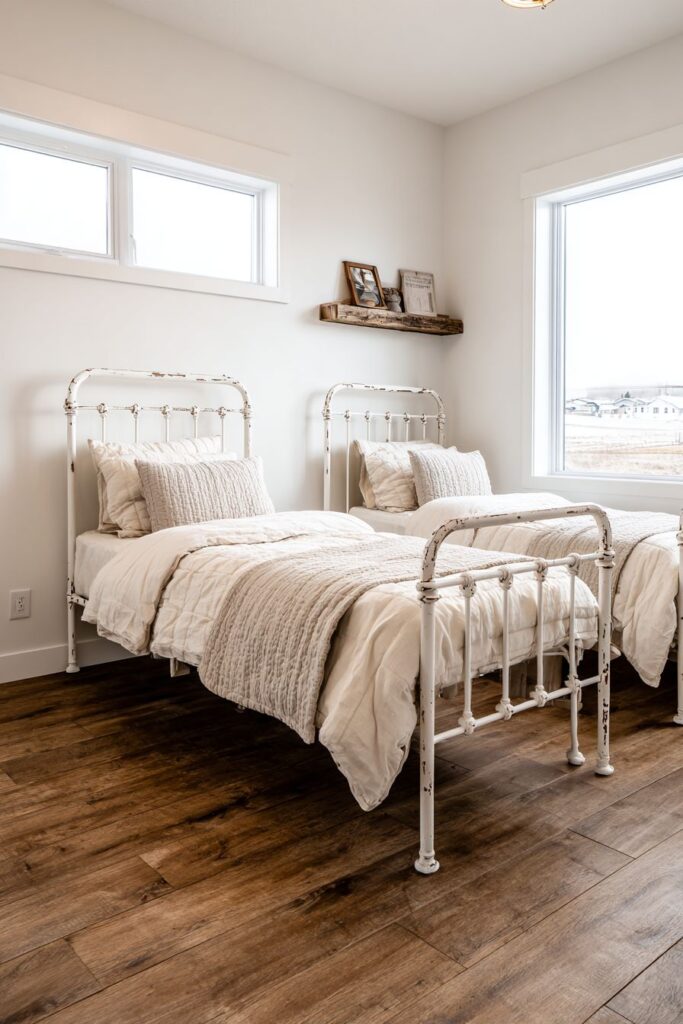
The warm wood plank flooring creates beautiful contrast against crisp white walls, establishing a foundation that feels both grounded and fresh. This juxtaposition of warm and cool tones, rough and smooth textures, traditional and modern elements defines the modern farmhouse aesthetic. Natural lighting from large windows creates gentle shadows that shift throughout the day, highlighting the room’s textural variety and creating an ever-changing interplay of light and shadow that brings the space to life.
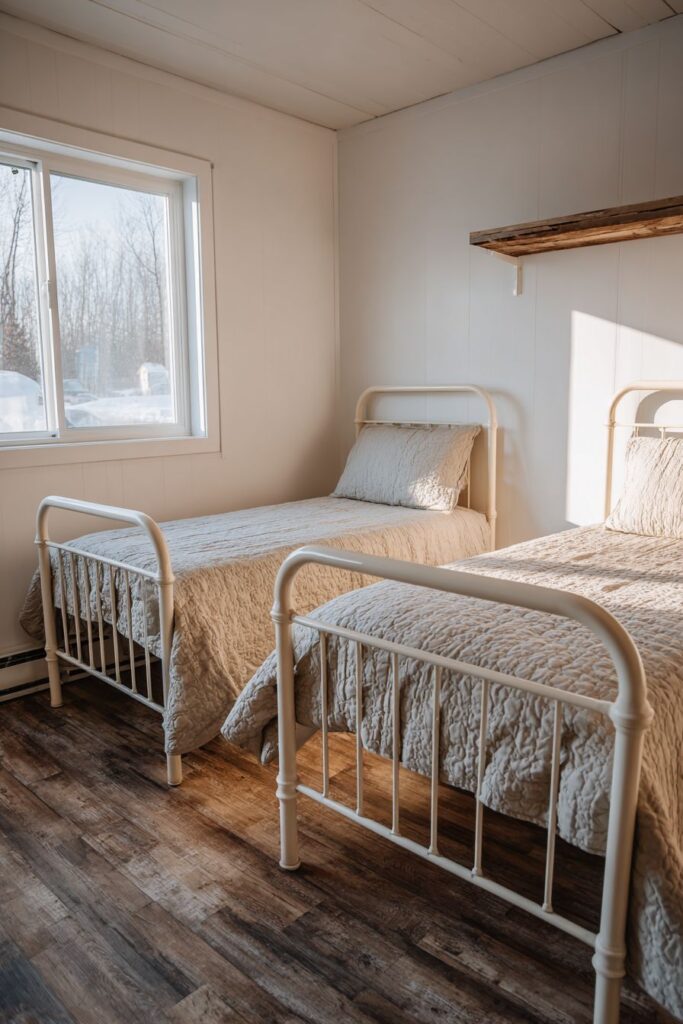
Key Design Tips:
- Select metal bed frames with distressed finishes for authentic farmhouse character with modern edge
- Layer bedding in neutral tones using different textures like quilted fabrics and linen
- Install reclaimed wood floating shelves for storage that doubles as decorative architectural detail
- Choose warm-toned wood flooring to contrast with white or light-colored walls
- Incorporate both vintage-inspired and contemporary elements for balanced modern farmhouse style
- Use large windows to maximize natural light and connect the interior with outdoor views
- Keep color palette neutral but vary textures extensively for visual interest
4. Space-Saving L-Shaped Twin Bed Configuration
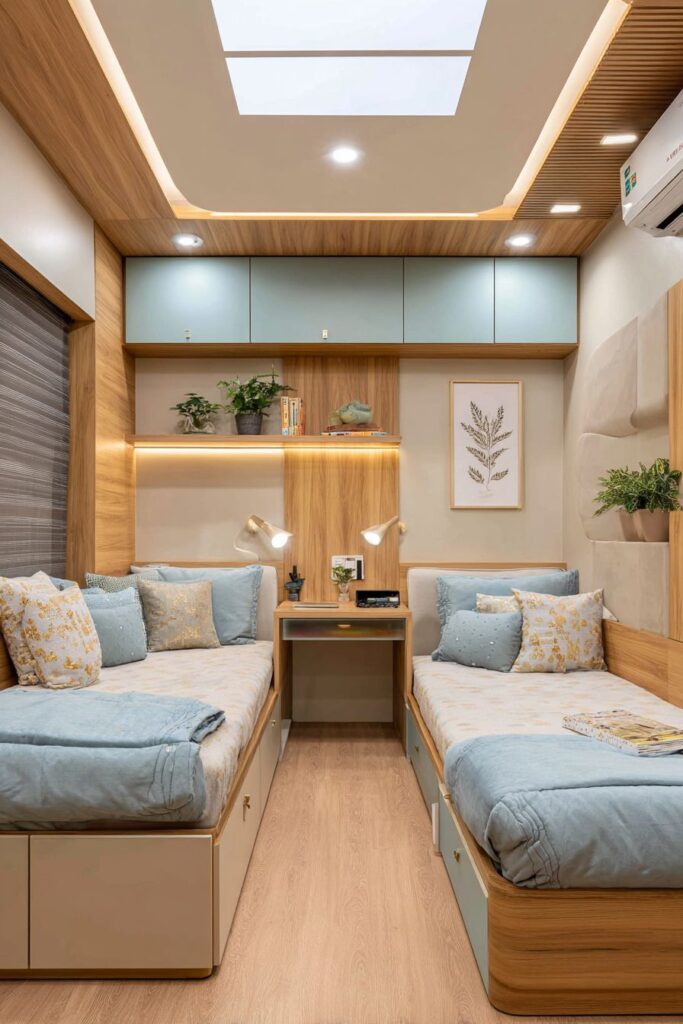
In smaller bedrooms where square footage is precious, creativity becomes essential. This innovative L-shaped configuration demonstrates how thoughtful spatial planning can transform limitations into opportunities. By arranging twin beds perpendicular to each other rather than parallel, this design maximizes floor space while creating distinct zones within a compact room. The built-in storage drawers underneath each bed represent the kind of multi-functional thinking that’s crucial in small-space design, eliminating the need for separate dressers and keeping the room uncluttered.

The neutral beige and soft blue bedding palette contributes to the room’s sense of spaciousness. These calming colors recede visually, making the room feel larger than its actual dimensions. The psychological impact of color in small spaces cannot be overstated—warm neutrals create comfort while cool blues introduce serenity and visual expansion. Together, they establish an environment that feels neither cramped nor stark, but perfectly balanced for rest and relaxation.

The compact shared desk fitting neatly into the corner exemplifies intelligent space utilization. This piece serves both occupants without dominating the room, providing necessary workspace for homework, reading, or personal projects. Task lighting at the desk ensures functionality without requiring additional floor space for lamps. Natural daylight filtering through a skylight adds vertical dimension to the room, drawing the eye upward and creating an unexpected sense of openness in a space that might otherwise feel confined.
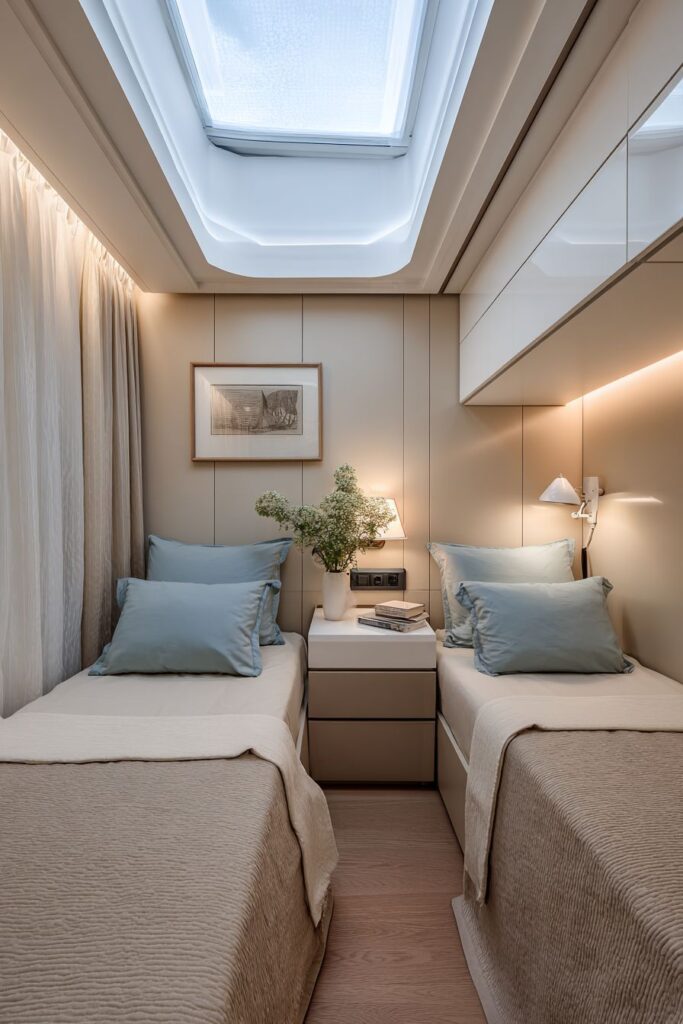
Key Design Tips:
- Arrange beds in an L-shape to maximize usable floor space in small rooms
- Choose beds with built-in storage drawers to eliminate need for additional furniture
- Use a calming neutral and blue color palette to create visual spaciousness
- Install a compact corner desk that serves both occupants efficiently
- Incorporate skylight or high windows to add vertical dimension and natural light
- Select multi-functional furniture pieces that serve multiple purposes
- Keep walls light and bright to maximize the sense of openness
- Use task lighting strategically to provide illumination without consuming floor space
5. Vibrant Kids’ Personalized Twin Bedroom
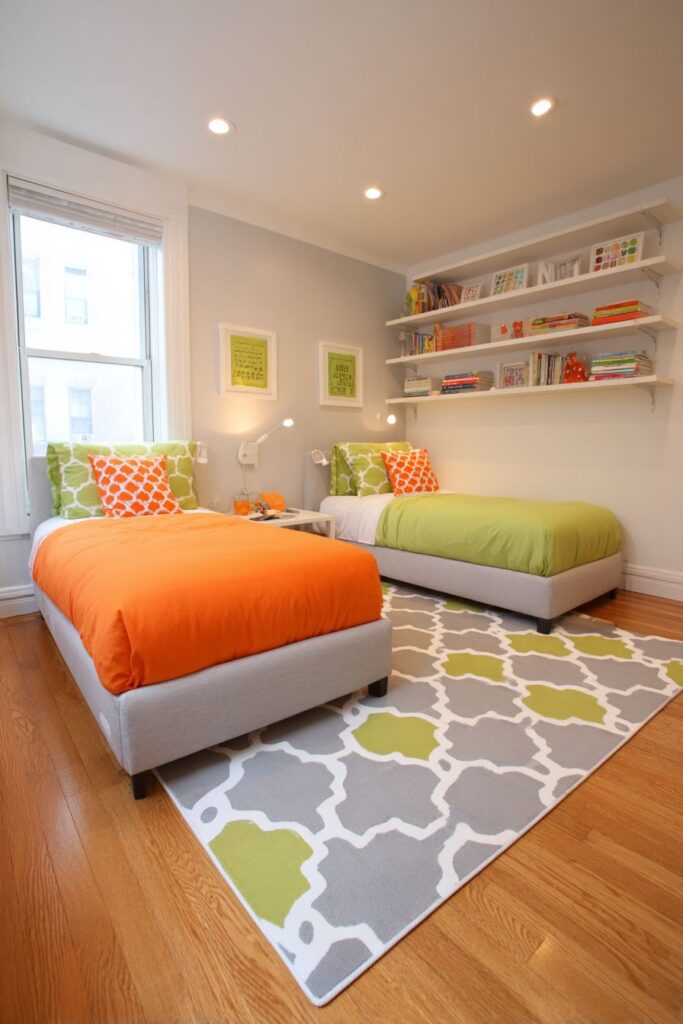
Children’s shared bedrooms present unique design challenges, requiring spaces that feel both unified and individual. This vibrant approach features two upholstered twin beds in soft grey fabric, providing a neutral foundation that allows personality to flourish through personalized bedding choices. One bed showcases warm terracotta tones while the other embraces sage green, demonstrating how coordinating yet distinct color schemes can coexist harmoniously. This strategy gives each child ownership of their space while maintaining visual cohesion.
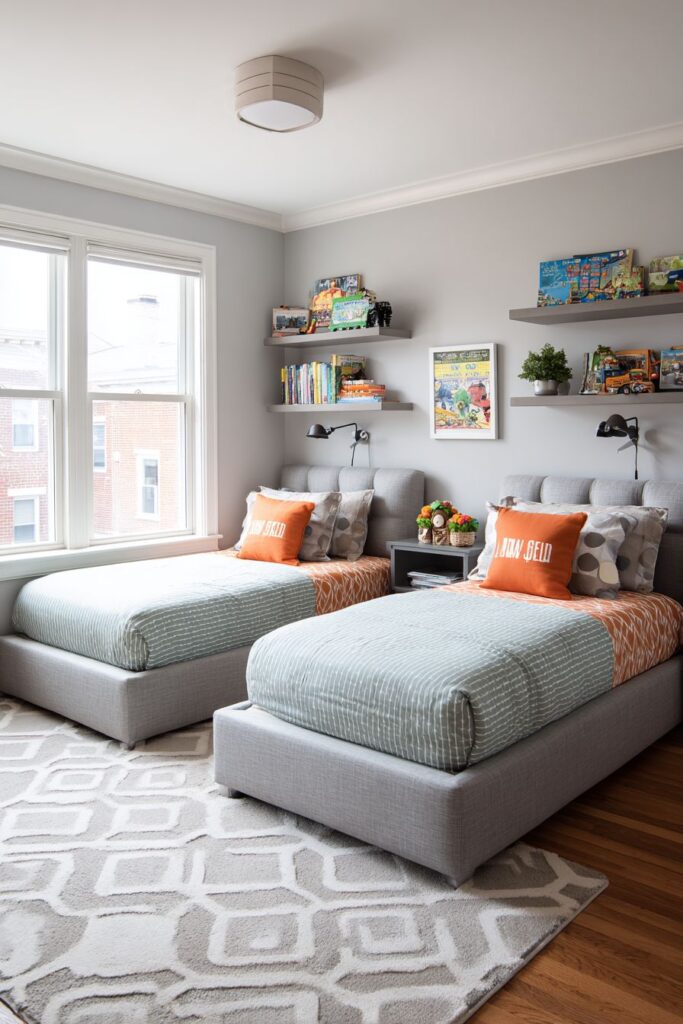
Individual wall-mounted reading lights above each bed acknowledge the practical needs of children with different schedules and preferences. These personal lighting solutions mean one child can read without disturbing the other—a small detail that significantly improves the functionality of shared spaces. Floating shelves provide personal display and storage areas where each child can showcase treasured items, creating miniature galleries that reflect individual interests and personalities.
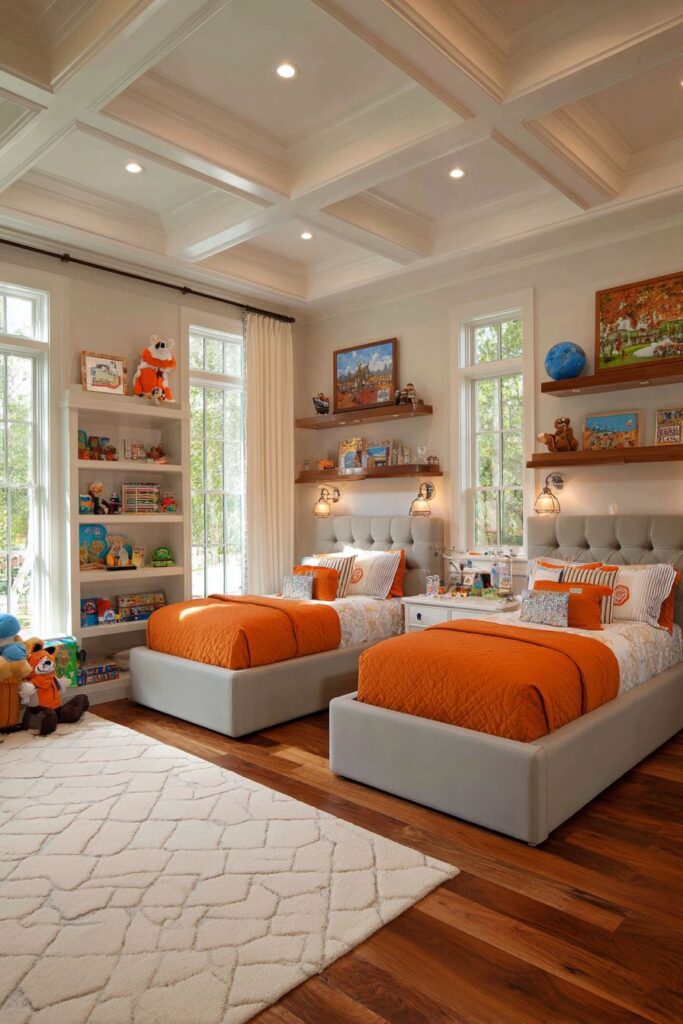
The hardwood flooring provides durability essential in active children’s spaces, while the geometric patterned area rug introduces playful visual interest and helps define the shared central area between beds. This rug serves multiple functions: it protects the flooring, reduces noise, adds warmth, and creates a designated play or interaction zone. The balanced natural lighting ensures the room feels bright and cheerful without harsh glare, supporting both energetic play during the day and calm bedtime routines in the evening.
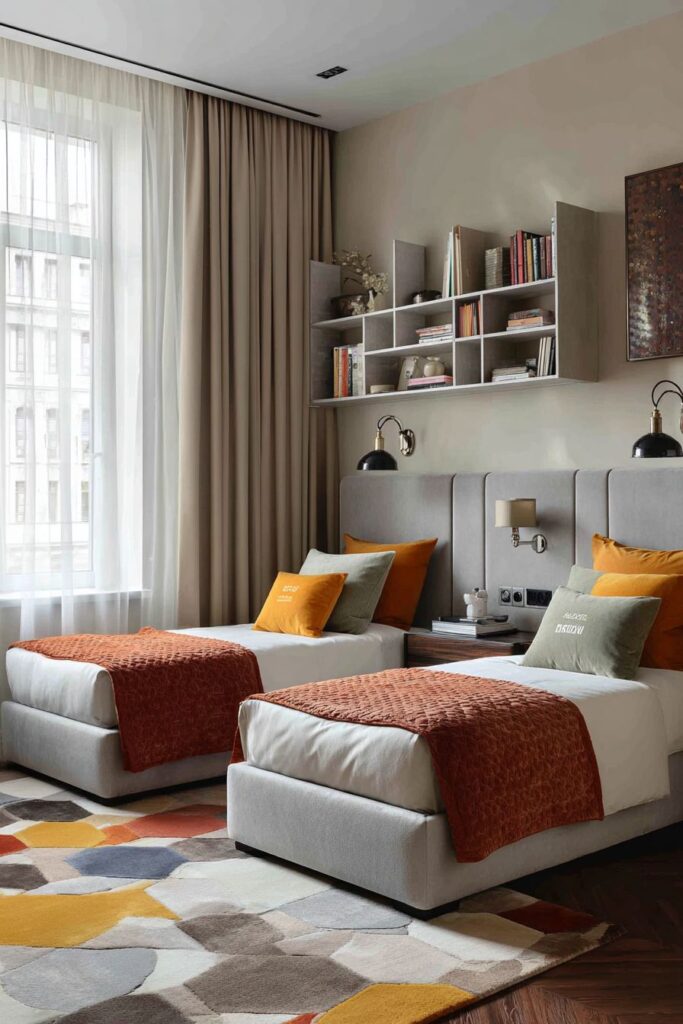
Key Design Tips:
- Choose neutral upholstered bed frames that provide comfort and versatility
- Allow each child to select personalized bedding in coordinating colors
- Install individual reading lights to accommodate different schedules and preferences
- Provide personal floating shelves for each child to display treasured items
- Use durable hardwood flooring that withstands active use
- Add a geometric patterned rug to define shared space and inject playful energy
- Ensure adequate natural lighting for various activities throughout the day
- Create distinct personal zones while maintaining overall design cohesion
6. Minimalist Guest Bedroom Retreat
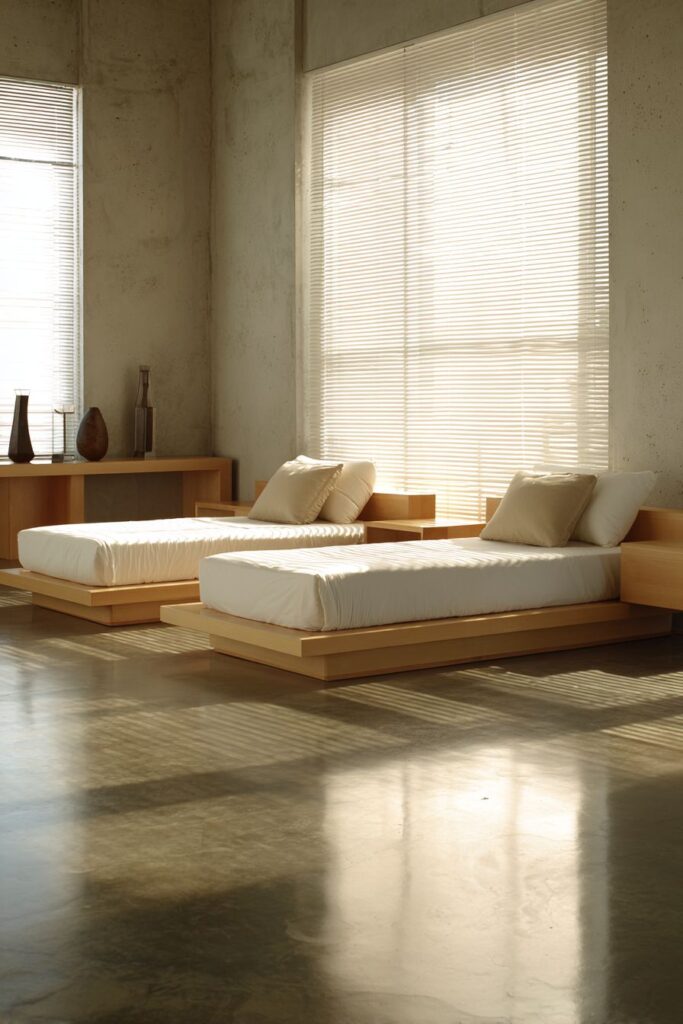
The minimalist approach to guest bedroom design prioritizes tranquility and simplicity, creating spaces that feel like peaceful sanctuaries. Two low-profile platform beds with crisp white linens establish immediate visual calm, their horizontal lines promoting restfulness and serenity. Single accent pillows provide just enough color or texture to prevent sterility without introducing visual complexity. This restraint is the essence of minimalist design—every element serves a purpose, and nothing extraneous clutters the space.
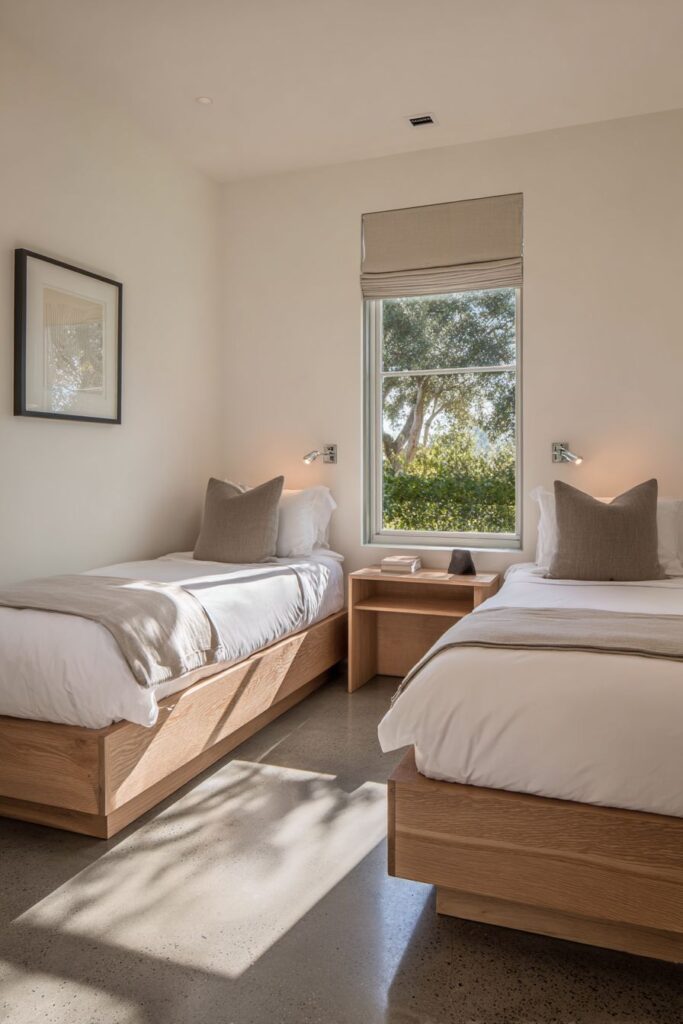
The beds flanking a central window create natural symmetry while maximizing the room’s connection to the outdoors. Simple roller shades provide light control without the visual weight of heavy drapery, maintaining the clean aesthetic even when addressing practical needs. The matching slim profile nightstands in light oak offer essential surface space without dominating the room, their minimalist design reflecting the overall philosophy of form following function.
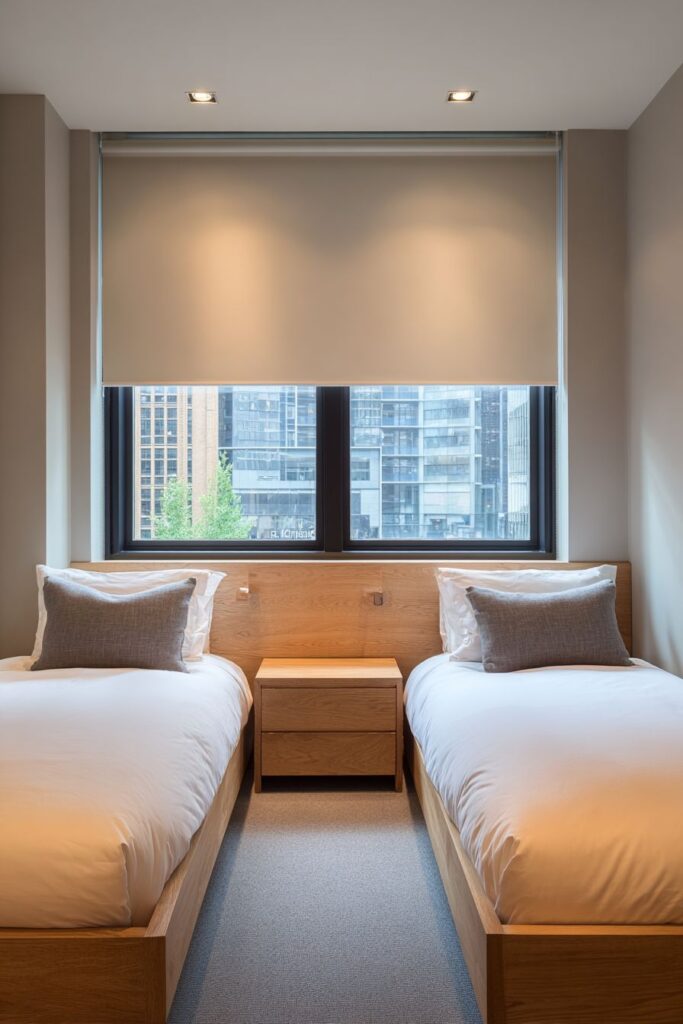
Polished concrete flooring introduces an unexpected modern edge while maintaining surprising warmth through its smooth, monolithic surface. This material choice eliminates visual breaks and transitions, creating continuity that makes the room feel larger and more cohesive. The soft diffused natural light creates clean shadows that enhance architectural elements without creating harsh contrasts, supporting the serene atmosphere that makes this space perfect for guests seeking restful retreat from busy lives.
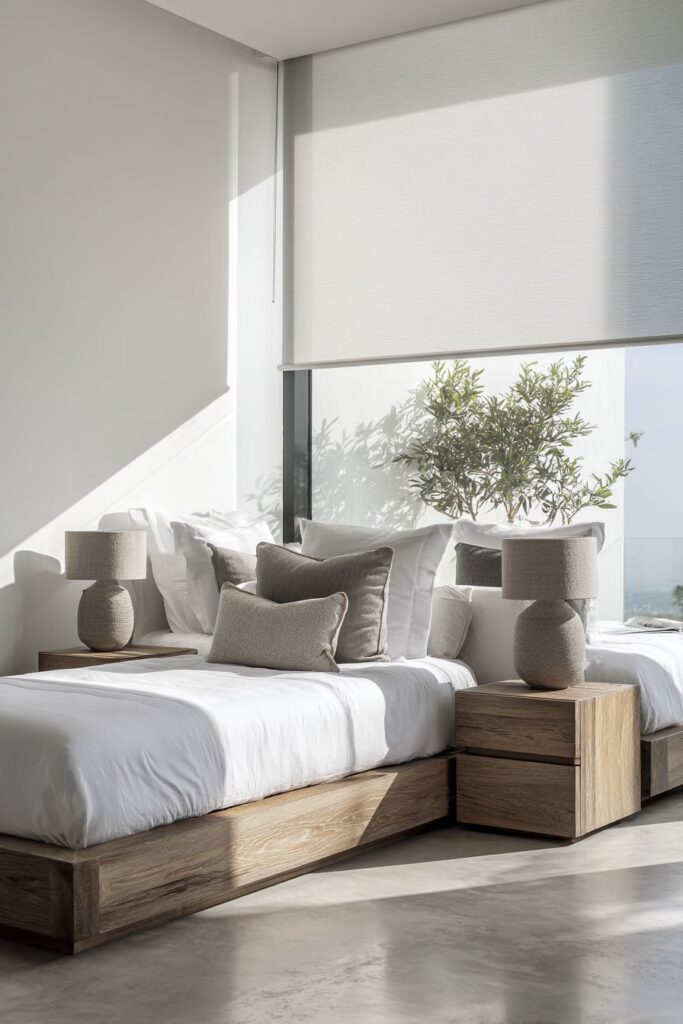
Key Design Tips:
- Select low-profile platform beds to maintain horizontal calm and visual simplicity
- Use crisp white linens with minimal accent pillows for clean, uncluttered sleeping areas
- Position beds to flank a central window for symmetry and natural light access
- Choose roller shades for practical light control without visual heaviness
- Install slim nightstands that provide function without bulk
- Consider polished concrete or similarly monolithic flooring for seamless modern appeal
- Embrace negative space as a design element rather than something to fill
- Maintain strict color discipline in limited palette of whites, greys, and natural wood tones
7. Traditional Elegance Twin Bedroom
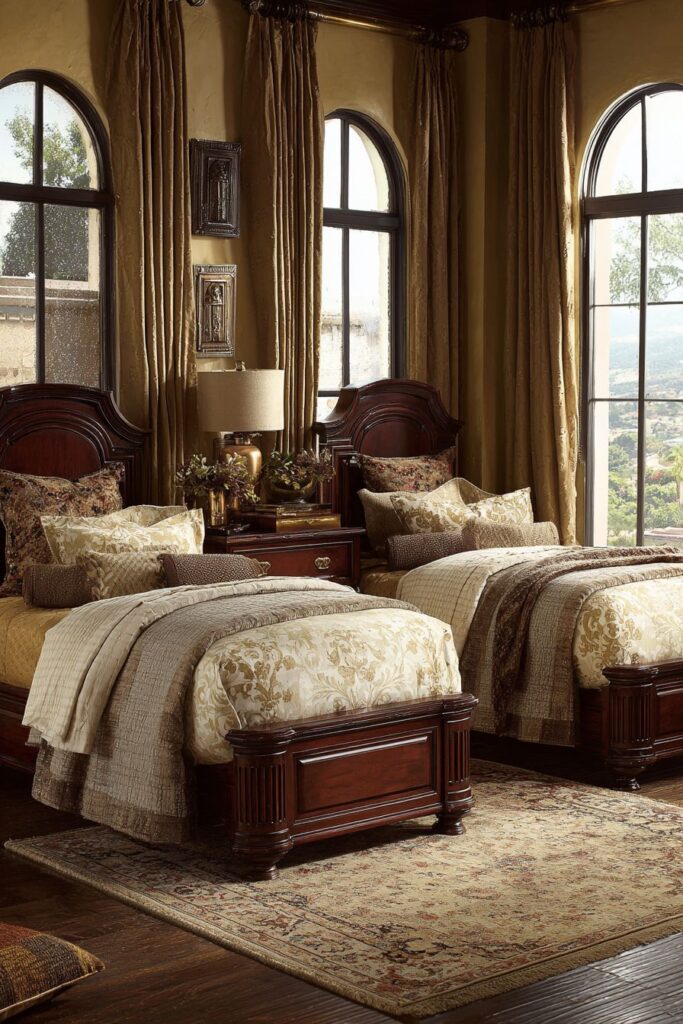
Traditional design celebrates timeless beauty and classical proportions, creating spaces that feel established and refined. Two classic wooden sleigh beds in rich mahogany finish anchor this elegant twin bedroom with their gracefully curved headboards and footboards. The deep, lustrous wood finish adds warmth and gravitas, while the distinctive sleigh silhouette provides architectural interest that elevates simple twin beds into statement pieces worthy of sophisticated interiors.

The elegant matching bedding features subtle damask patterns in ivory and taupe, introducing traditional motifs without overwhelming the space with pattern. These muted, tone-on-tone designs add textural richness and visual interest while maintaining the calm sophistication essential to restful bedrooms. The damask pattern itself carries historical significance, its origins in medieval silk weaving traditions adding layers of cultural depth to the design narrative.
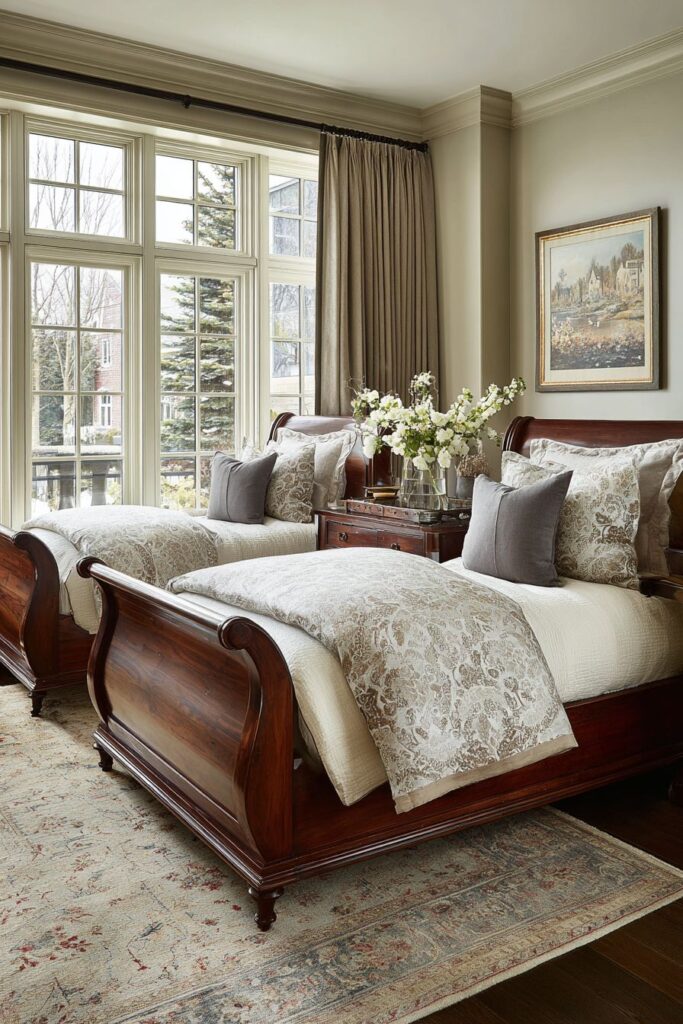
Antique-style bedside tables with drawer storage separate the beds while providing essential functionality. Their turned legs and traditional hardware complement the sleigh beds perfectly, creating cohesive furniture groupings on each side of the room. The Persian-style area rug in muted tones anchors the sleeping area with its intricate patterns and rich history, while natural light from tall windows with layered curtains creates warm ambiance. These multi-layer window treatments—combining sheers and heavier drapes—allow for flexible light control while adding softness and luxury.
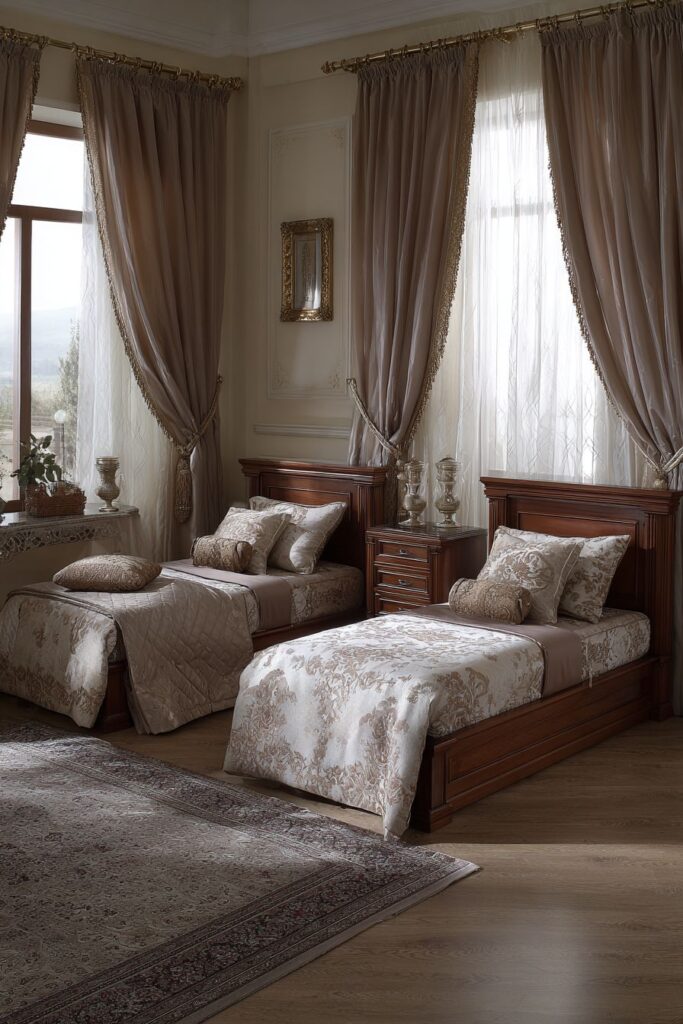
Key Design Tips:
- Choose classic sleigh beds in rich wood finishes for timeless architectural beauty
- Select bedding with subtle traditional patterns like damask in neutral colorways
- Use antique or antique-style nightstands with turned legs and traditional hardware
- Anchor the space with a Persian or Oriental-style rug in muted, sophisticated tones
- Install tall windows with layered curtain treatments for flexible light control and luxury
- Maintain symmetry in furniture placement and accessory choices
- Incorporate classical proportions and traditional craftsmanship details
- Layer textures within a refined color palette for depth without chaos
8. Bohemian Eclectic Twin Bedroom
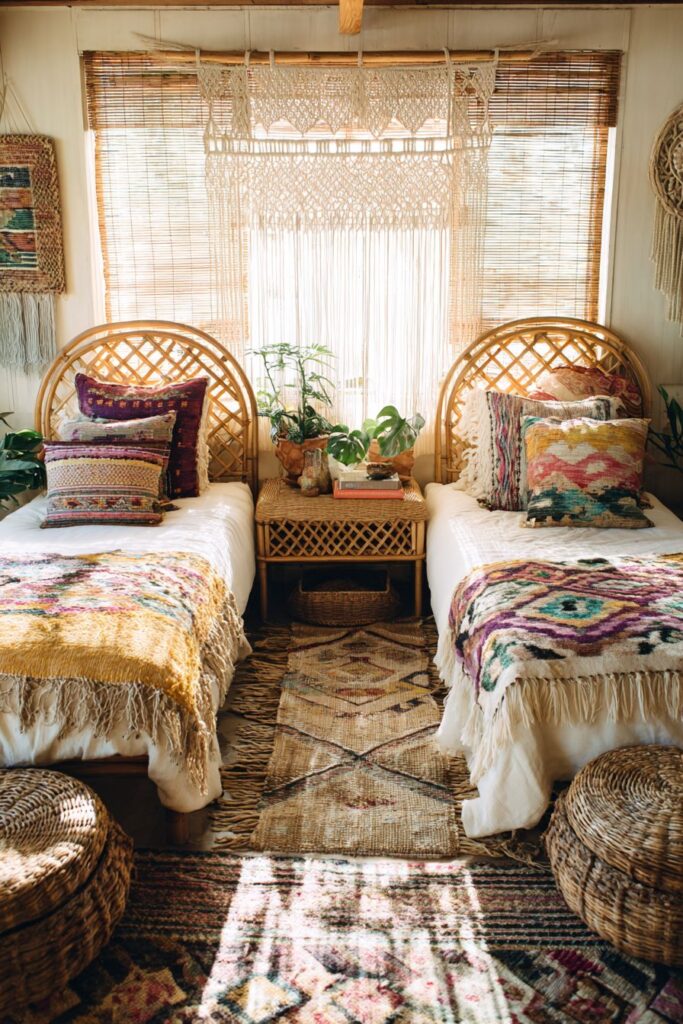
The bohemian aesthetic embraces artistic freedom, global influences, and joyful layering of patterns and textures. Two rattan twin beds with woven headboards establish the natural, artisanal foundation of this eclectic space. The visible craftsmanship in the woven details celebrates handmade beauty and connects the room to global traditions of fiber arts and sustainable materials. Rattan’s organic texture and warm honey tones create immediate visual interest while maintaining surprising versatility in styling.
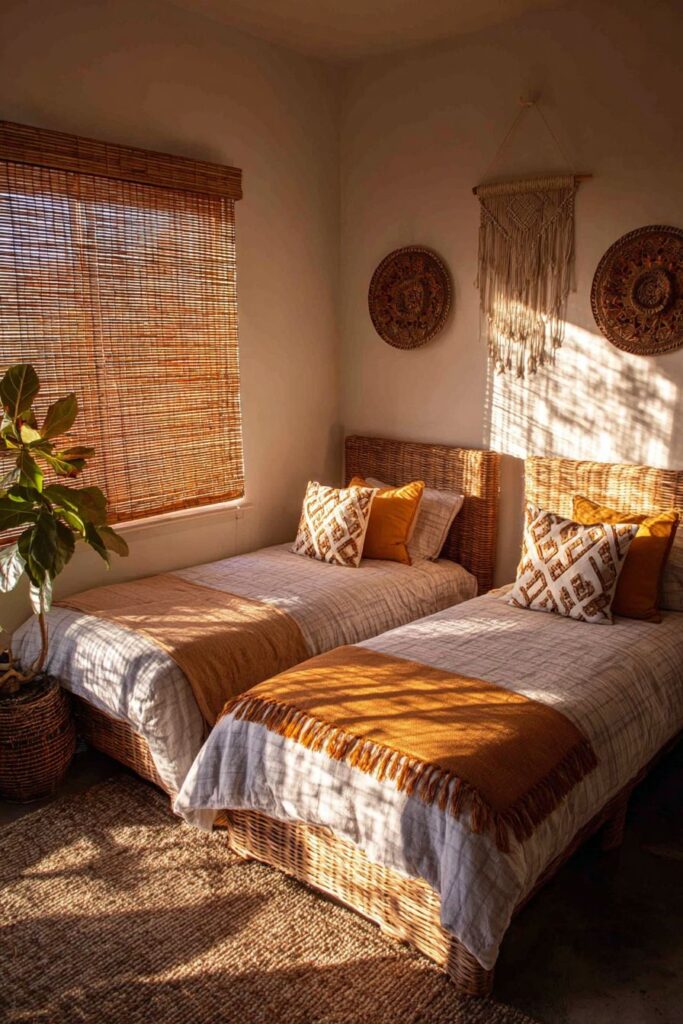
Colorful layered bedding represents the heart of bohemian design—geometric prints mix with tasseled throws and diverse patterned pillows in a celebration of texture and color. This fearless approach to mixing patterns requires confidence and careful attention to color relationships, ensuring the variety feels intentional rather than chaotic. The key lies in finding common color threads that weave through different patterns, creating visual coherence despite the eclectic mix.
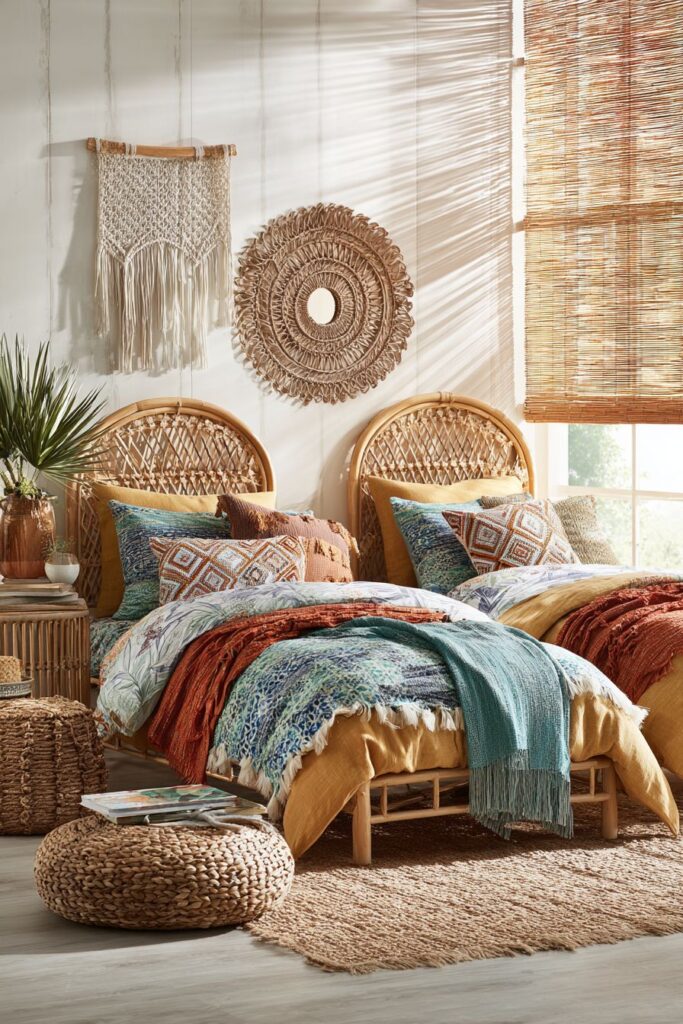
Macramé wall hangings above each bed add artisanal texture while personalizing each sleeping area. These handcrafted textile pieces introduce verticality and softness, their intricate knotwork casting beautiful shadows and adding dimensional interest to the walls. Natural fiber rugs overlap between the beds, creating visual interest through their layered placement and varied textures. Golden hour sunlight streaming through bamboo blinds bathes the room in warm, filtered light that enhances the natural materials and creates an inviting, globally-inspired atmosphere.
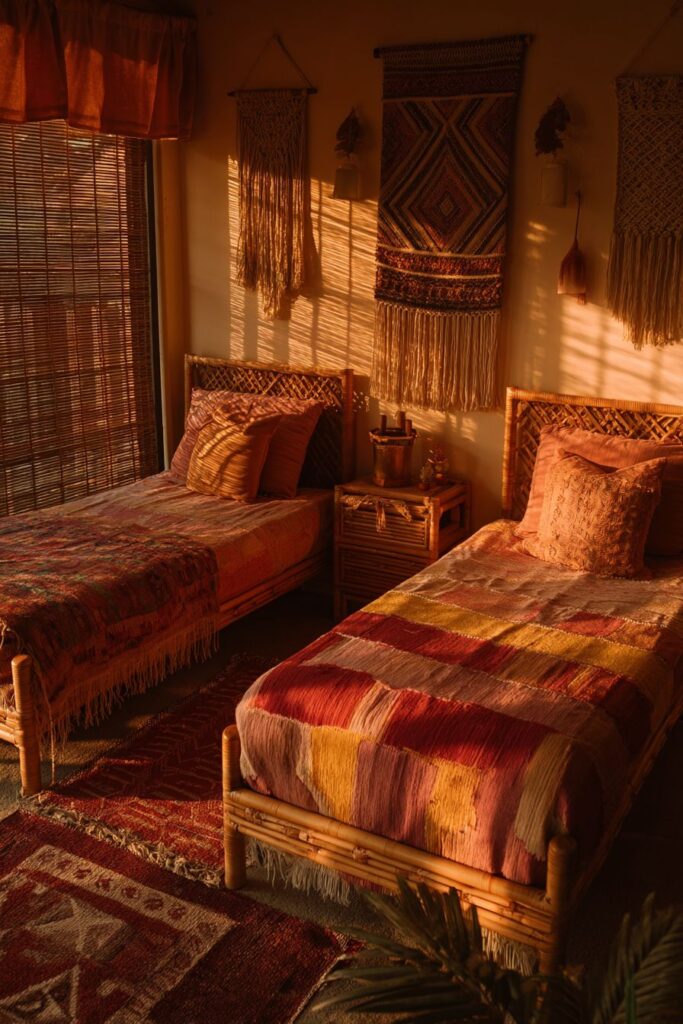
Key Design Tips:
- Select rattan or woven furniture for natural texture and artisanal appeal
- Layer bedding fearlessly with multiple patterns, ensuring color cohesion
- Hang macramé or textile wall art for handcrafted bohemian character
- Overlap multiple natural fiber rugs for rich textural layering
- Use bamboo or natural woven blinds to filter light warmly
- Incorporate global textiles and handmade elements from various cultures
- Embrace color and pattern mixing with intentional color coordination
- Display artisanal crafts and natural materials prominently
9. Industrial-Modern Urban Twin Bedroom
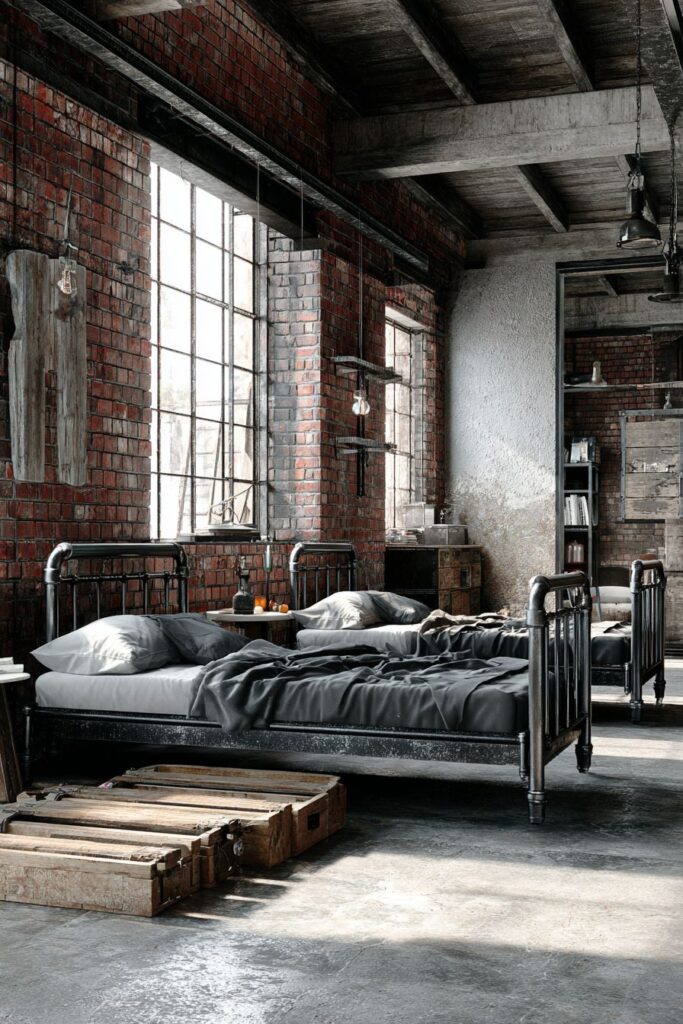
Industrial design draws inspiration from converted warehouses and urban lofts, celebrating raw materials and honest construction. Two metal pipe-frame twin beds with exposed rivets embody this aesthetic perfectly, their utilitarian beauty transforming functional hardware into design features. The visible construction details—welded joints, exposed bolts, raw metal finishes—tell a story of authenticity and craftsmanship that appeals to those who appreciate unrefined beauty and architectural honesty.

Bedding in charcoal grey and white creates masculine appeal while maintaining the monochromatic sophistication characteristic of industrial interiors. These neutral tones allow the architectural elements and material textures to command attention without competing with colorful patterns. The simplicity of the bedding also reinforces the industrial philosophy of function over decoration, creating spaces that feel purposeful and intentionally understated.
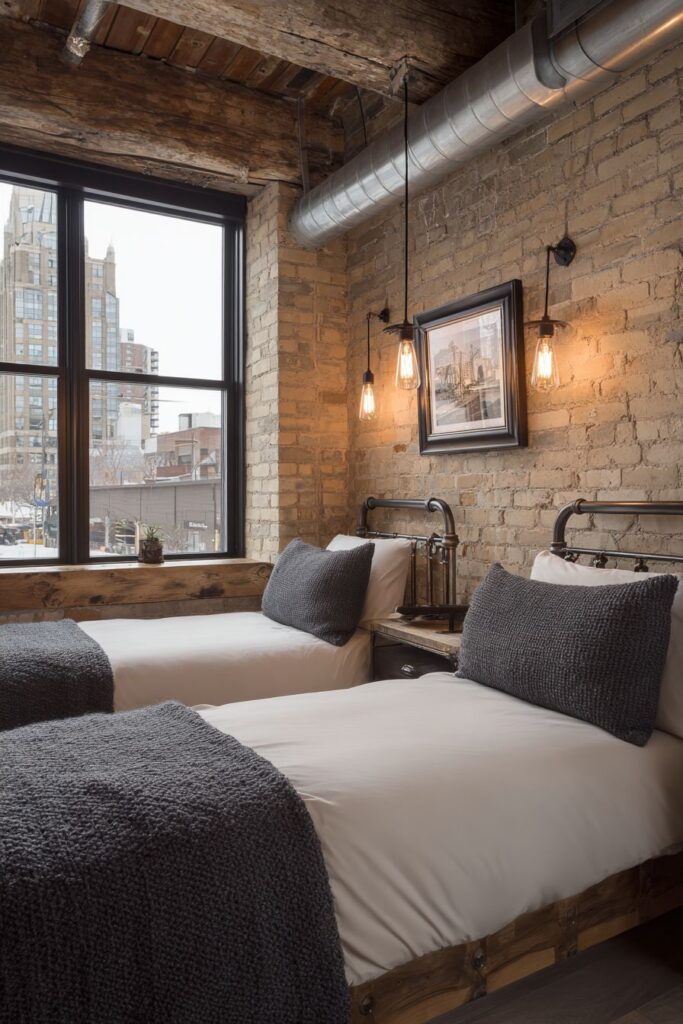
Floating metal shelves with reclaimed wood tops serve as nightstands, perfectly exemplifying industrial design’s marriage of different materials. The contrast between cool metal brackets and warm salvaged wood creates visual interest while providing practical storage. An exposed brick accent wall adds urban character and textural depth, its rough surface and earthy tones warming the predominantly cool palette. Edison bulb pendant lights provide ambient lighting with vintage-industrial flair, while natural light from factory-style windows—large, simple, often with metal frames—illuminates the space with honest, unfiltered daylight.
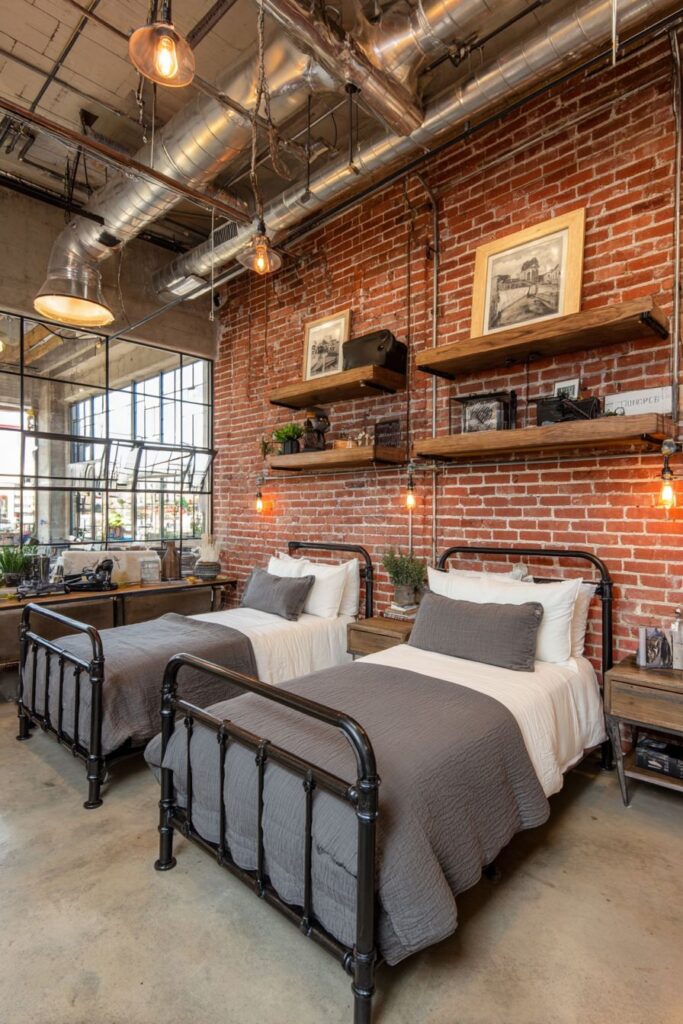
Key Design Tips:
- Choose metal pipe or framework beds that celebrate industrial construction
- Use monochromatic bedding in greys, whites, and blacks for urban sophistication
- Install floating shelves combining metal and reclaimed wood for material contrast
- Expose or add brick walls for authentic industrial texture and warmth
- Select Edison bulb or cage-style lighting for vintage industrial character
- Maximize natural light through large, minimally-treated windows
- Embrace raw, unfinished materials and visible construction details
- Keep color palette neutral to highlight architectural and material elements
10. Symmetrical Sophisticated Velvet Twin Bedroom
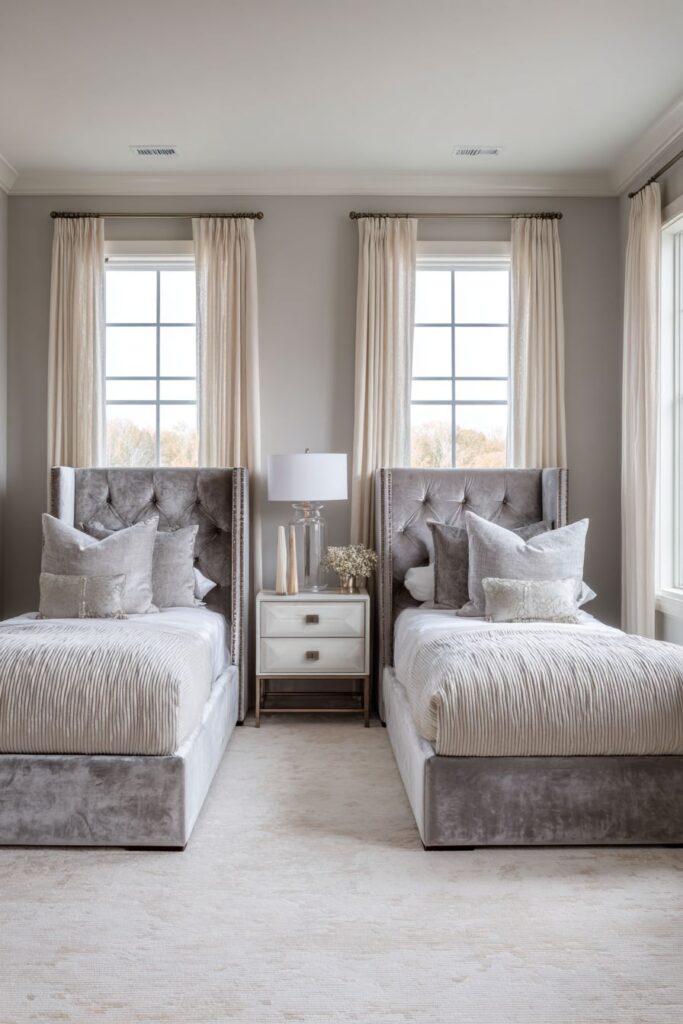
Symmetry creates powerful visual impact in interior design, and this sophisticated approach demonstrates its effectiveness in dual bed configurations. Two identical twin beds upholstered in soft dove grey velvet establish immediate luxury through material choice and perfect mirroring. The channel-tufted headboards create elegant focal points with their linear vertical detailing, adding architectural interest while maintaining the refined simplicity that defines sophisticated interiors.
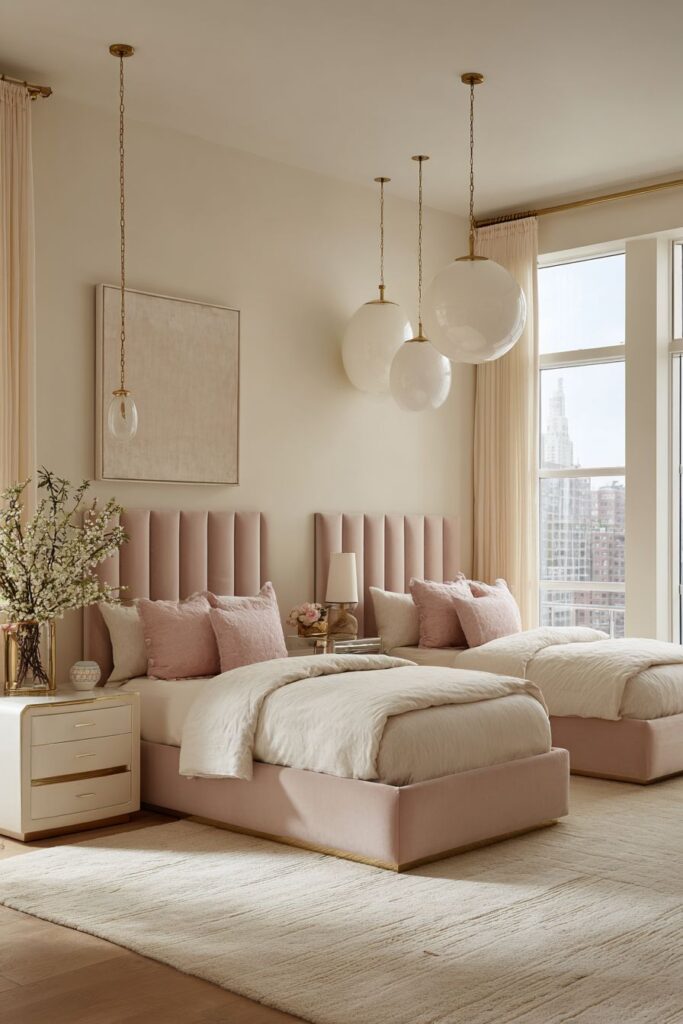
The coordinating nightstands in white lacquer with brass hardware provide storage while contributing to the room’s polished aesthetic. The glossy white finish reflects light beautifully, enhancing brightness while the warm brass hardware introduces subtle metallic accent that prevents the space from feeling too cool or stark. These carefully selected pieces demonstrate how hardware choices significantly impact overall design—the brass adds warmth and traditional elegance that complements the contemporary velvet upholstery.
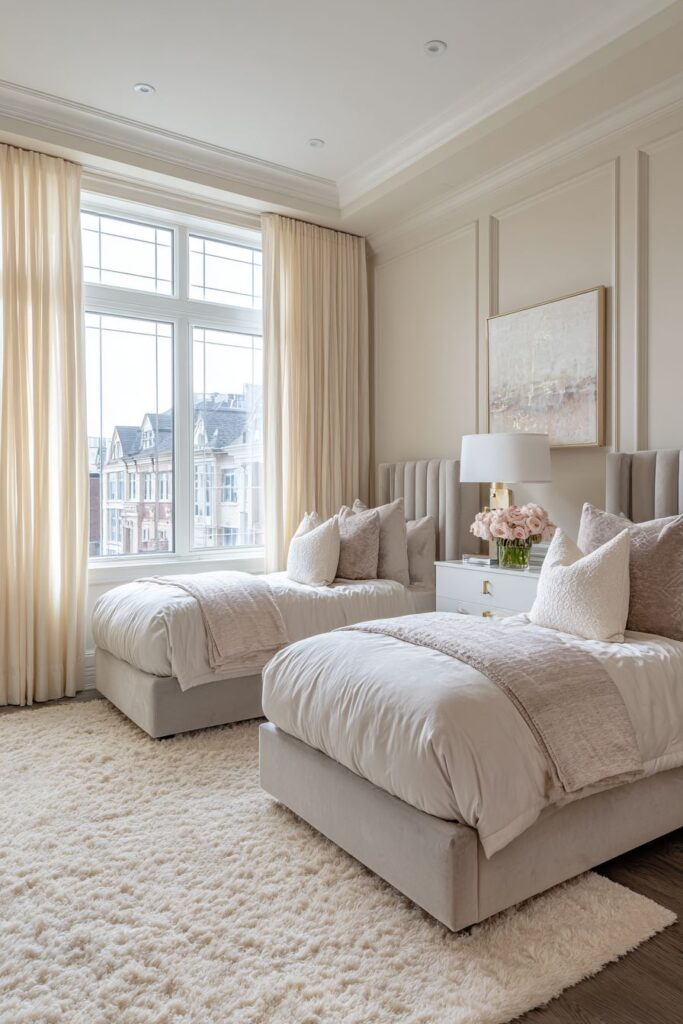
A plush area rug in cream grounds the space with softness underfoot and visual warmth. The rug’s solid color and luxurious texture allow the upholstered beds to remain the focal point while adding essential comfort and acoustic softening. Sheer drapes filter natural daylight, creating soft, even illumination that flatters the velvet upholstery and enhances the room’s serene atmosphere. The wide-angle view of this space reveals how perfect symmetry, luxurious materials, and sophisticated neutral palette combine to create a bedroom that feels both elegant and inviting.
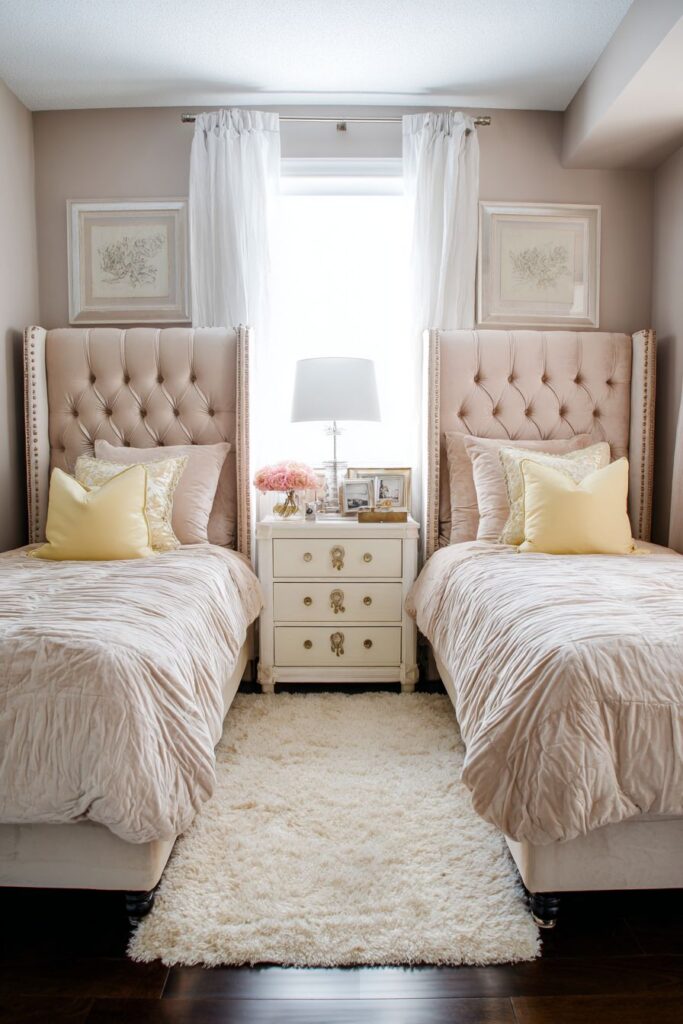
Key Design Tips:
- Choose matching upholstered beds in quality fabrics like velvet for luxury appeal
- Select channel-tufted or detailed headboards for architectural interest
- Use high-gloss lacquer nightstands to reflect light and add contemporary polish
- Incorporate brass or gold-tone hardware for warm metallic accents
- Ground the space with plush, solid-color area rugs in neutral tones
- Hang sheer curtains to create soft, flattering natural light
- Maintain perfect symmetry in furniture placement and styling
- Layer luxurious textures within a sophisticated neutral palette
11. Compact Urban Smart Storage Twin Bedroom
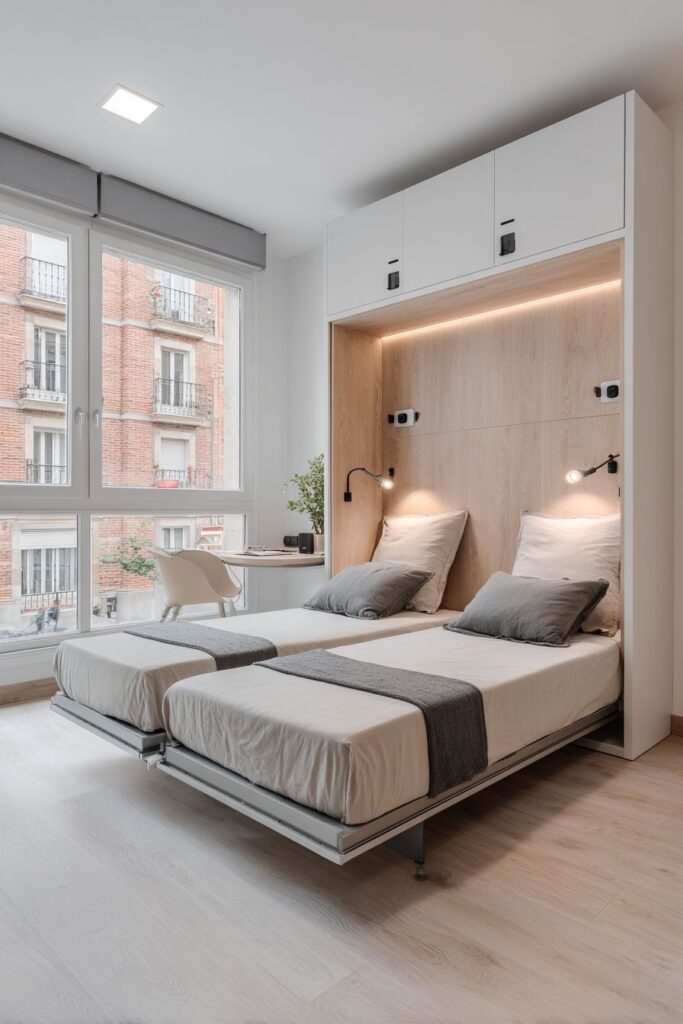
Urban living often demands ingenious space solutions, and this compact twin bedroom rises to the challenge with intelligent built-in features. Twin beds featuring storage headboards with cubbies and USB charging ports represent the evolution of bedroom furniture for modern needs. These multifunctional headboards eliminate the need for separate nightstands while providing charging capabilities for the devices that have become essential to contemporary life—a perfect example of furniture adapting to how we actually live today.
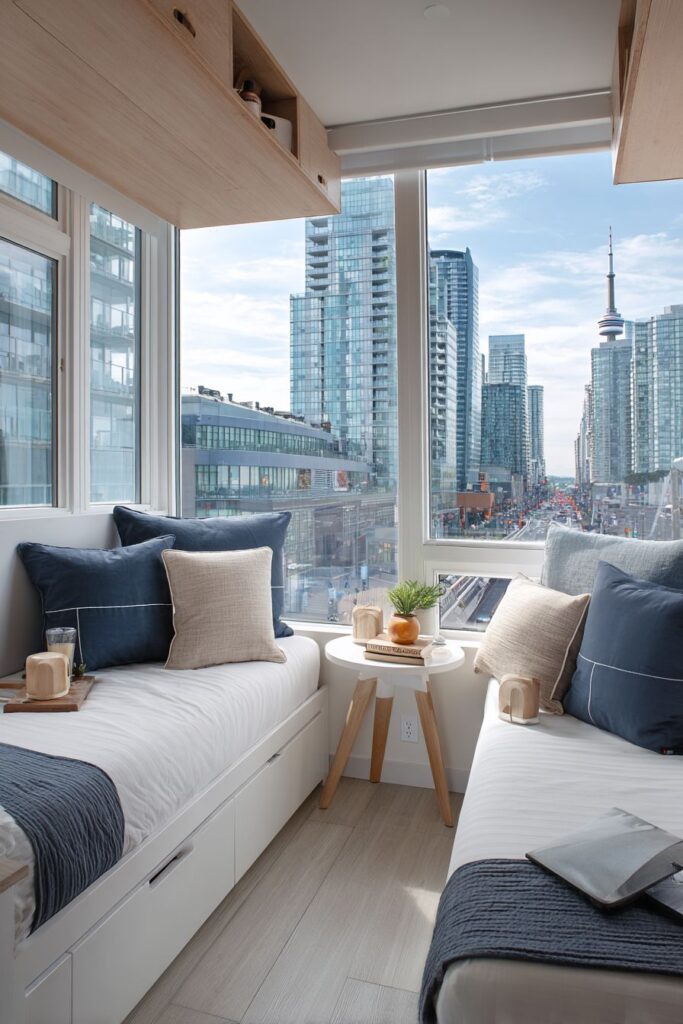
Modern bedding in navy and grey creates a contemporary look while maintaining the sophisticated restraint appropriate for small spaces. In compact rooms, simple color palettes and uncluttered surfaces become even more critical, preventing visual overwhelm that can make small spaces feel claustrophobic. The navy adds depth and masculinity without the heaviness of black, while grey provides neutral balance and versatility.
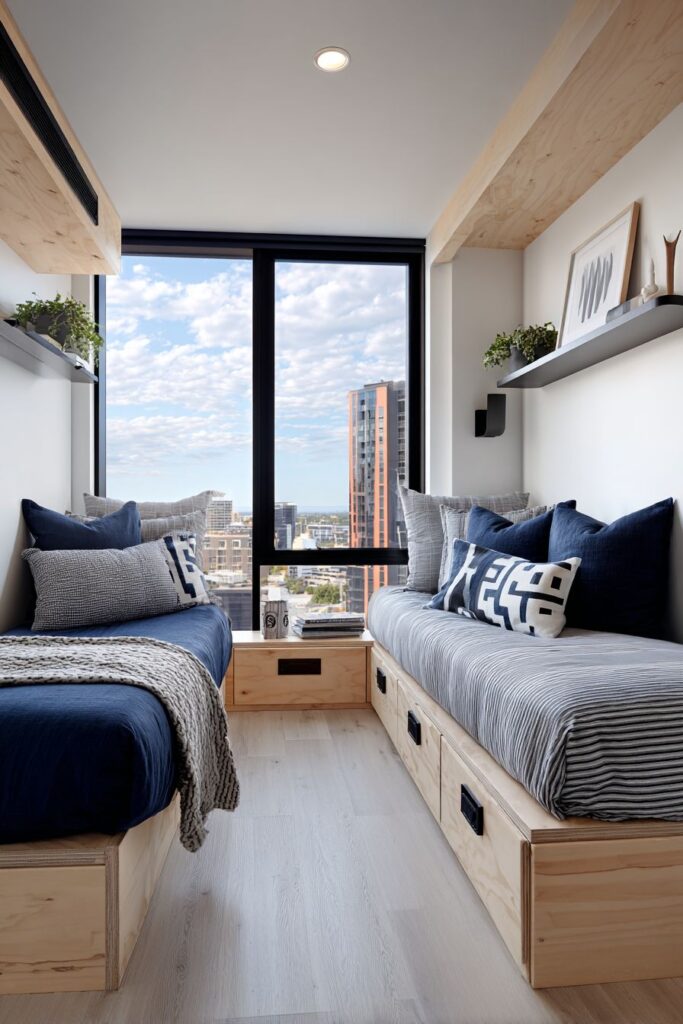
Wall-mounted folding desks between the beds maximize functionality in limited square footage. These innovative pieces provide work surfaces when needed but fold away completely when not in use, demonstrating the kind of adaptable thinking essential in compact urban spaces. Light wood laminate flooring keeps the space bright and visually expands the room through its light reflectivity. Natural window light supplemented by recessed ceiling lights ensures adequate illumination without consuming precious floor or table space, proving that smart small-space solutions need not sacrifice style or functionality.
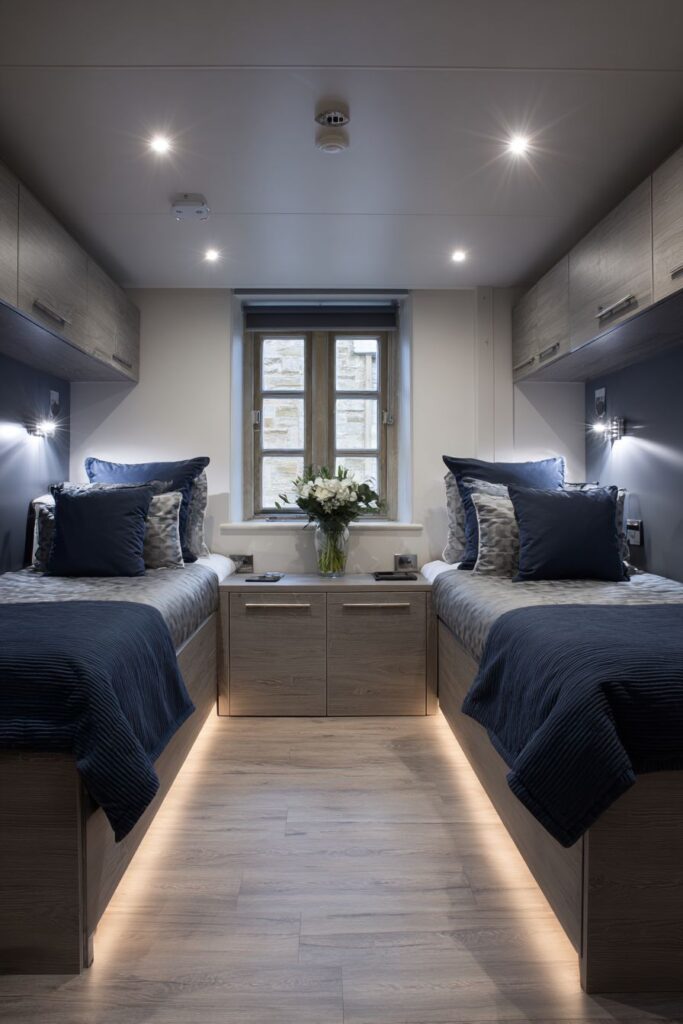
Key Design Tips:
- Select beds with built-in storage headboards featuring modern amenities like USB ports
- Use contemporary bedding in clean, simple color combinations
- Install wall-mounted folding desks for flexible workspace that disappears when not needed
- Choose light-colored flooring to maximize brightness and visual space
- Incorporate recessed ceiling lighting to illuminate without using surface space
- Prioritize multi-functional furniture that serves multiple purposes
- Keep surfaces uncluttered and maintain simple color palettes
- Design for how you actually live with technology integration and practical storage
12. Rustic Cabin Mountain Retreat Twin Bedroom
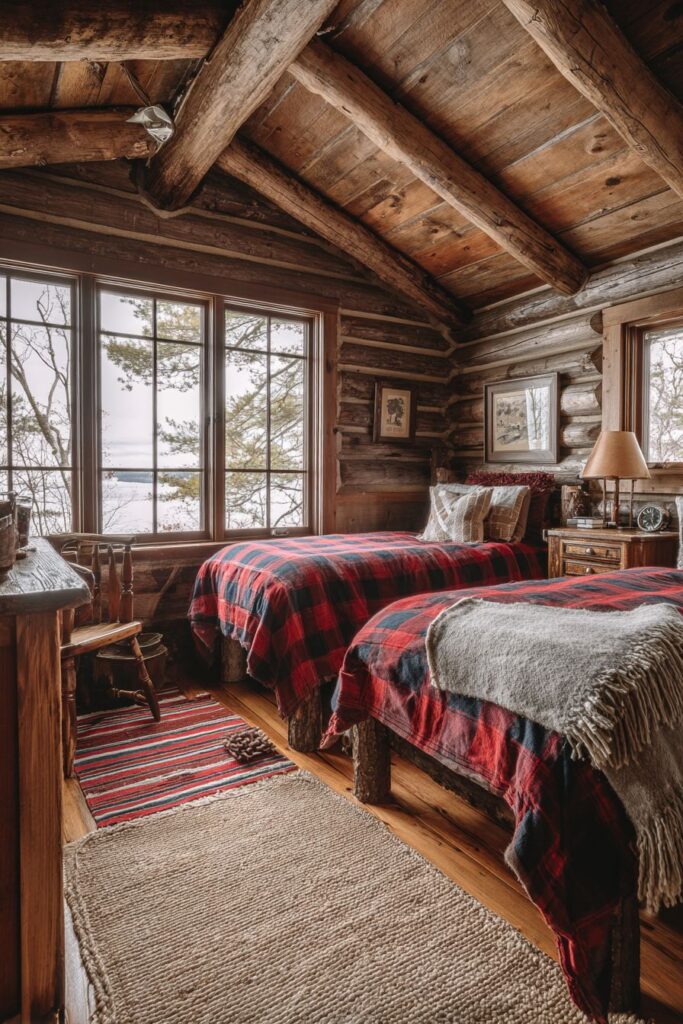
The rustic cabin aesthetic transports occupants to mountain retreats and lakeside lodges, creating spaces that celebrate natural materials and traditional craftsmanship. Two log-style twin bed frames anchor this design with their authentic woodsy character, their visible grain patterns and natural imperfections telling stories of forest origins. These substantial frames create immediate visual impact while establishing the room’s connection to wilderness traditions and outdoor living.
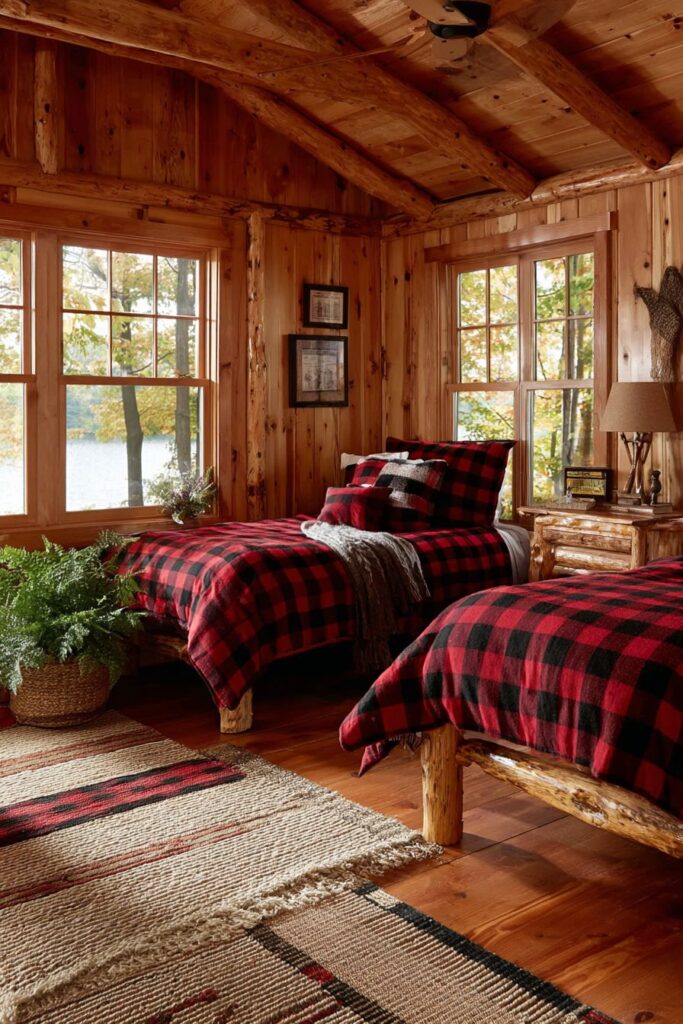
Plaid flannel bedding in classic red and black creates cozy warmth that’s synonymous with cabin living. This iconic pattern evokes images of campfires, winter evenings, and outdoor adventures, bringing emotional warmth to complement the physical comfort of soft flannel. The traditional color combination has deep roots in outdoor heritage, maintaining authenticity while providing bold visual contrast against natural wood tones.
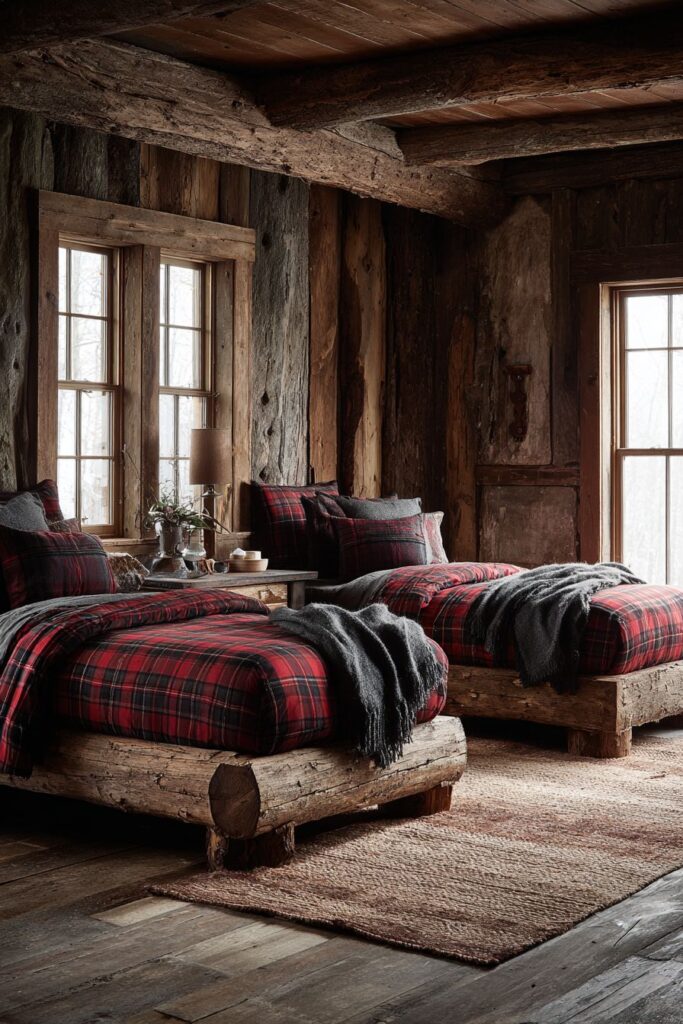
Knotty pine paneling on walls adds authentic lodge character with its distinctive knots and grain variations. This traditional wall treatment creates warmth and textural interest while connecting the space to historical cabin construction techniques. Braided wool rugs in earth tones protect wooden plank flooring while introducing traditional handicraft and additional warmth underfoot. Soft natural light from pine-framed windows completes the authentic mountain retreat atmosphere, filtering through trees (real or implied) to create the dappled illumination characteristic of forest settings.
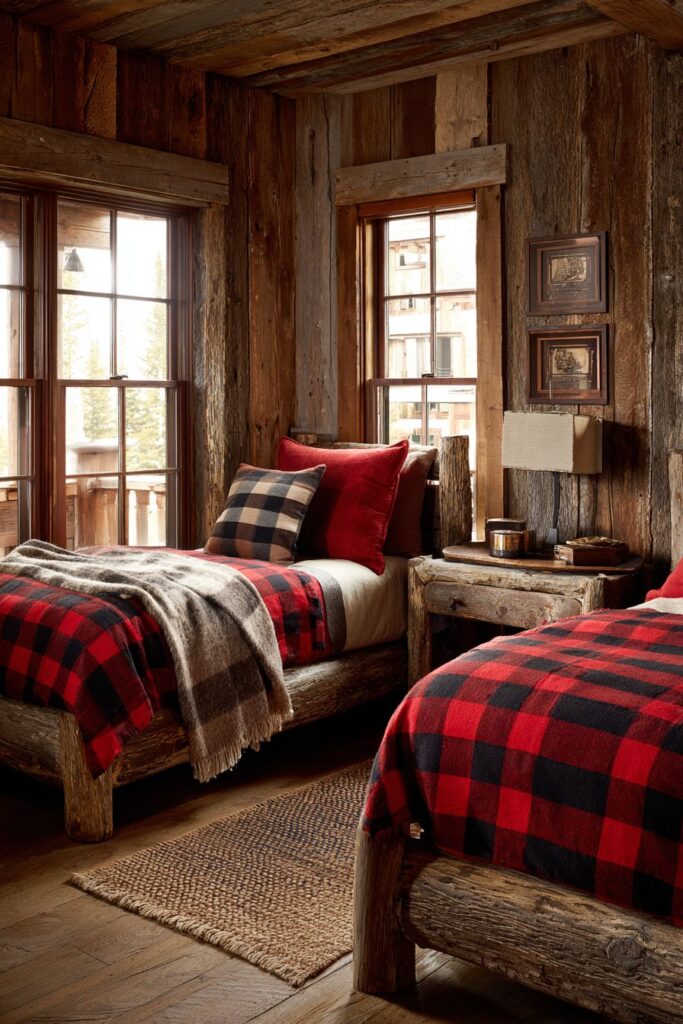
Key Design Tips:
- Choose log or heavily-grained wood bed frames for authentic cabin character
- Use plaid flannel bedding in traditional red and black or earth tone combinations
- Install knotty pine or rough-hewn wood paneling for rustic wall treatment
- Add braided wool rugs for traditional craftsmanship and warmth
- Frame windows with natural wood to maintain consistent material palette
- Embrace wood grain variations and natural imperfections as design features
- Layer warm textiles for physical and visual comfort
- Create connections to outdoor settings through material choices and color palette
13. Contemporary Tech-Forward Twin Bedroom
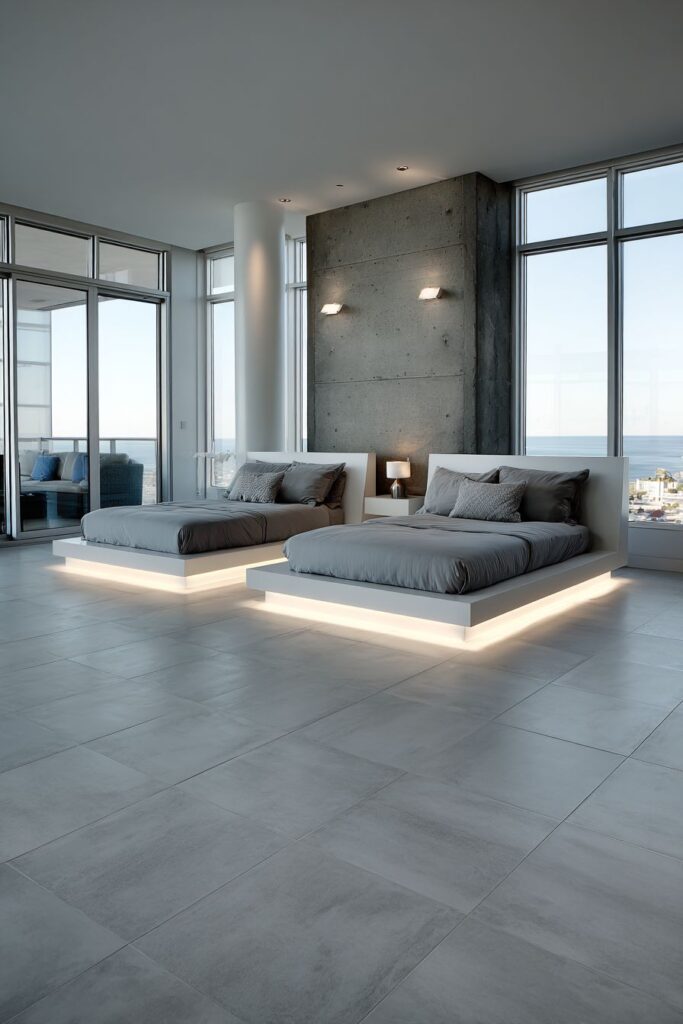
Contemporary design embraces technological innovation and sleek minimalism, creating spaces that feel current and forward-thinking. Two sleek platform beds with integrated LED strip lighting in the base represent this fusion of style and technology. The subtle glow from beneath the beds creates dramatic visual impact while providing practical nighttime illumination—a sophisticated detail that exemplifies how modern design integrates functionality seamlessly into aesthetic elements.
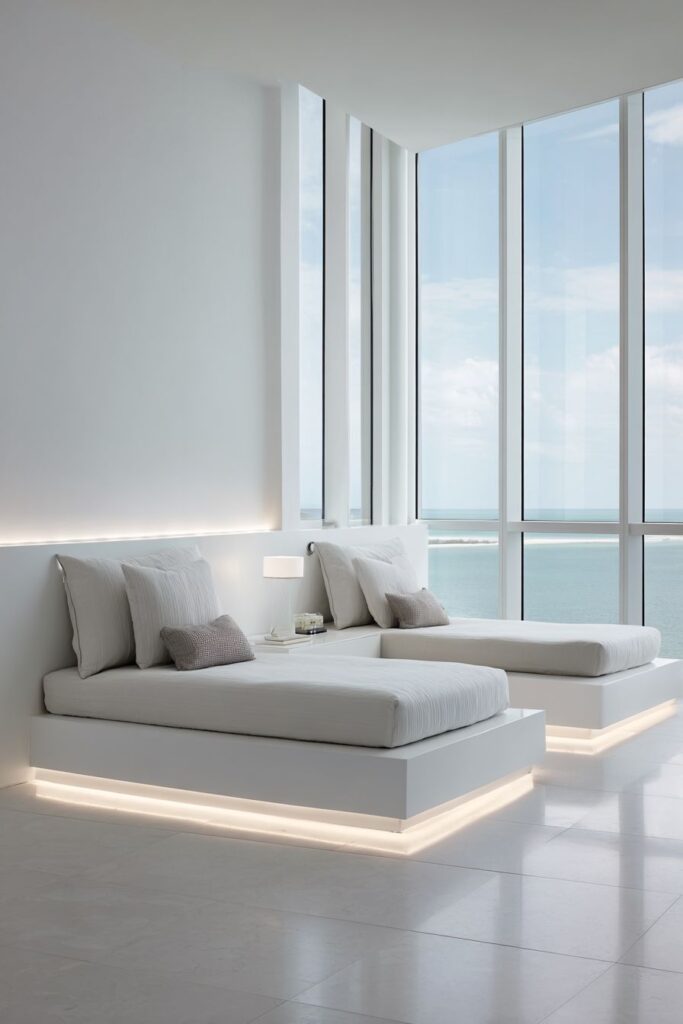
Monochromatic bedding in varying shades of grey creates modern sophistication through tonal layering. This approach to color—using multiple values of a single hue—adds depth and interest without introducing pattern or contrasting colors. The result is calming yet visually engaging, allowing the room’s architectural features and technological elements to shine without competition from busy bedding.
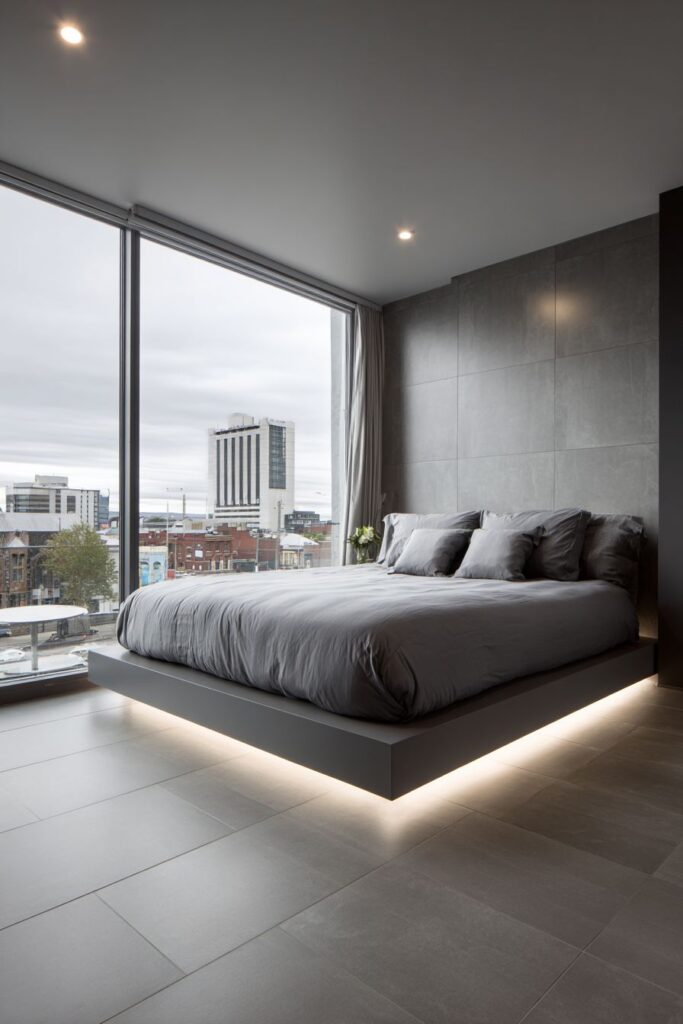
Floating nightstands with hidden drawers maintain clean lines essential to contemporary aesthetics. By concealing storage behind seamless facades, these pieces provide functionality without visual clutter. The floating installation creates negative space beneath, enhancing the room’s sense of lightness and spatial flow. Large format porcelain tile flooring in light grey continues the minimal palette while introducing the cool, sophisticated surface appropriate for contemporary interiors. Floor-to-ceiling windows provide abundant natural light and create dramatic architectural impact, blurring boundaries between interior and exterior in the manner characteristic of contemporary design.
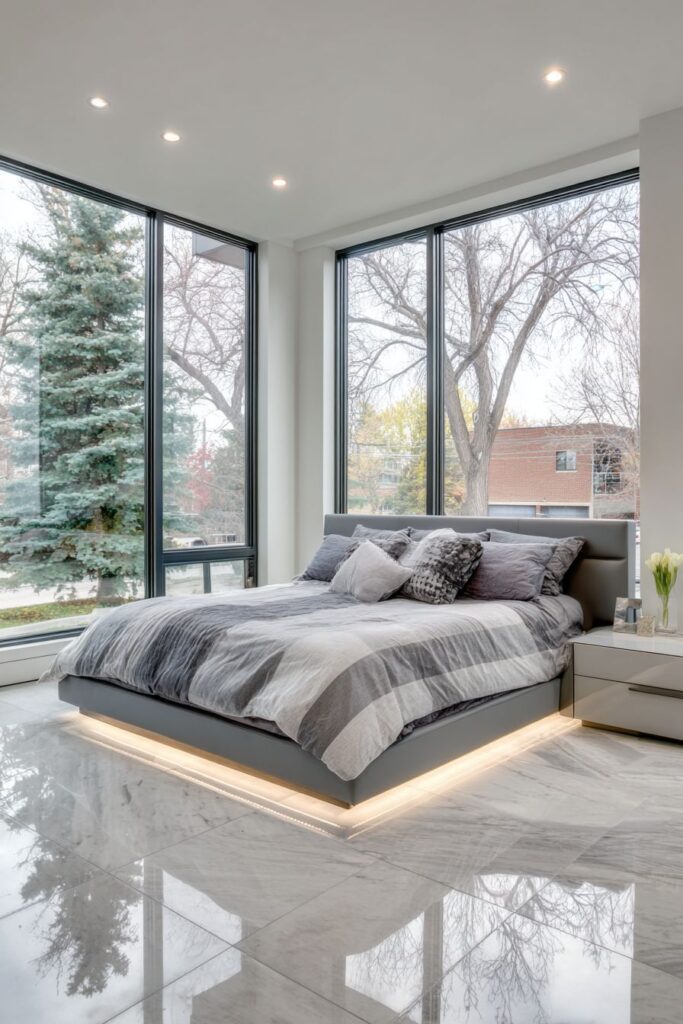
Key Design Tips:
- Select platform beds with integrated LED lighting for tech-forward ambiance
- Use monochromatic bedding in tonal variations for sophisticated depth
- Install floating nightstands with concealed storage for seamless modern look
- Choose large-format tile flooring for contemporary, continuous surfaces
- Maximize natural light with floor-to-ceiling windows
- Integrate technology thoughtfully into design elements
- Maintain strict adherence to minimal color palette
- Emphasize horizontal lines and streamlined silhouettes
14. French Country Romantic Twin Bedroom
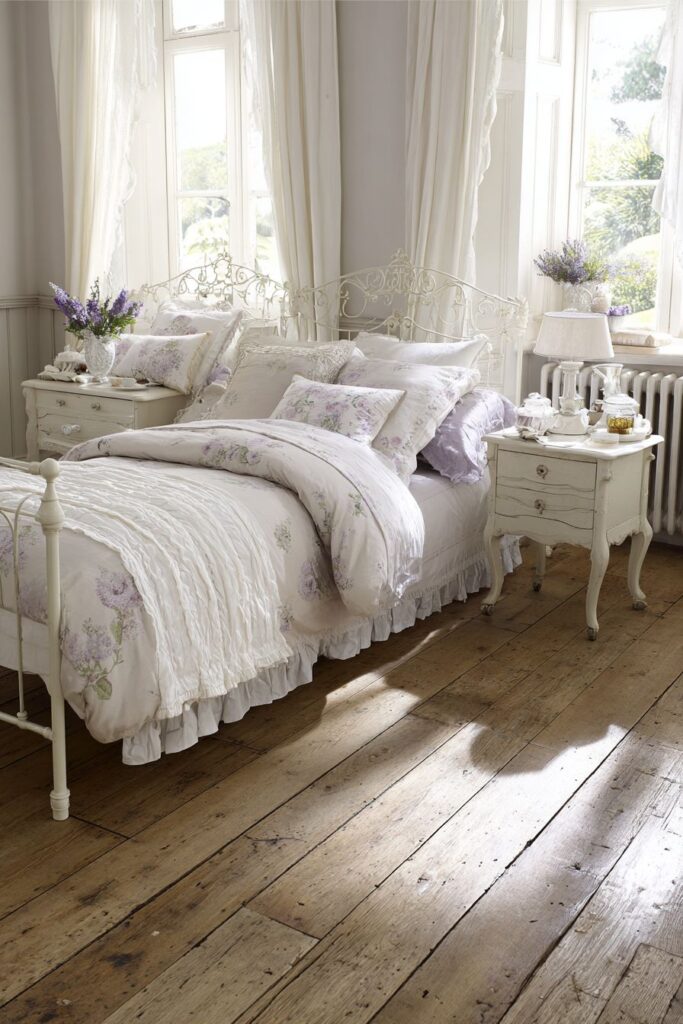
French country design captures the romantic charm of provincial France, blending rustic elements with refined details. Two ornate wrought-iron twin beds painted in distressed white establish the room’s romantic character with their delicate scrollwork and deliberate aging. The wrought-iron construction provides visual lightness despite substantial presence, its curves and flourishes adding feminine grace without overwhelming the space. The distressed white finish suggests age and history while maintaining the bright, airy quality essential to country aesthetics.

Romantic bedding features soft florals in lavender and cream with ruffled details, introducing pattern and texture that reinforces the room’s gentle, pastoral character. The lavender brings subtle color while maintaining the soft, dreamy quality of classic French country design. Ruffles and gathered fabrics add dimension and traditional craftsmanship details that modern manufacturing often overlooks, creating bedding that feels lovingly made rather than mass-produced.
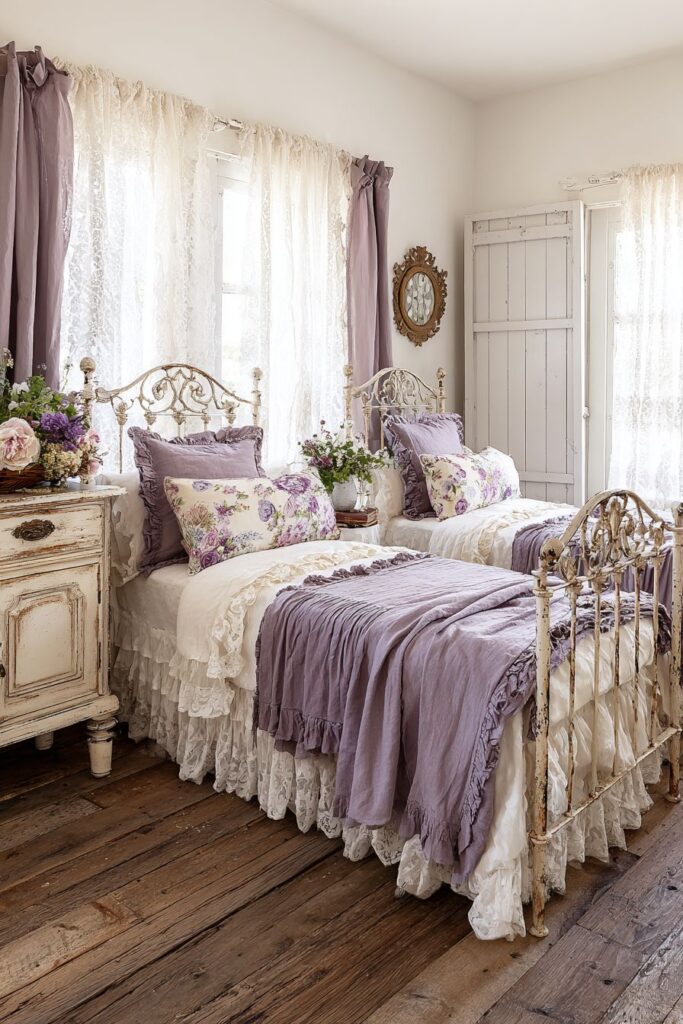
Vintage-style nightstands with turned legs add charm while providing practical storage. These pieces, whether genuinely antique or crafted in traditional styles, contribute to the room’s sense of history and established beauty. Wide-plank oak flooring with natural aging creates authentic character underfoot, its warm tones and honest imperfections grounding the romantic details with rustic authenticity. Soft natural light through lace curtains casts delicate shadows, the intricate patterns of the lace creating ever-changing light shows on walls and floors that enhance the room’s dreamy, provincial atmosphere.
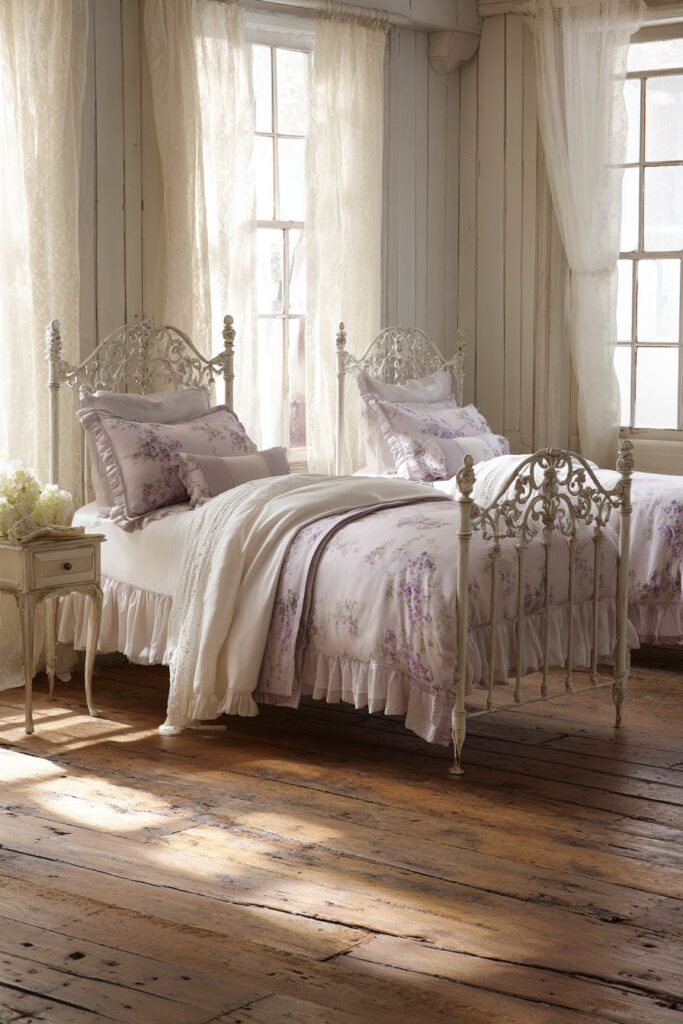
Key Design Tips:
- Choose ornate wrought-iron beds with distressed white or cream finishes
- Select bedding with soft floral patterns and romantic details like ruffles
- Use vintage or vintage-style furniture with turned legs and traditional details
- Install wide-plank wood flooring with natural aging and warm tones
- Hang lace curtains to create delicate filtered light and shadow patterns
- Incorporate lavender, cream, and soft pastels for gentle color palette
- Layer romantic textiles and traditionally-crafted elements
- Balance ornate details with rustic authenticity
15. Neutral Nature-Inspired Twin Bedroom
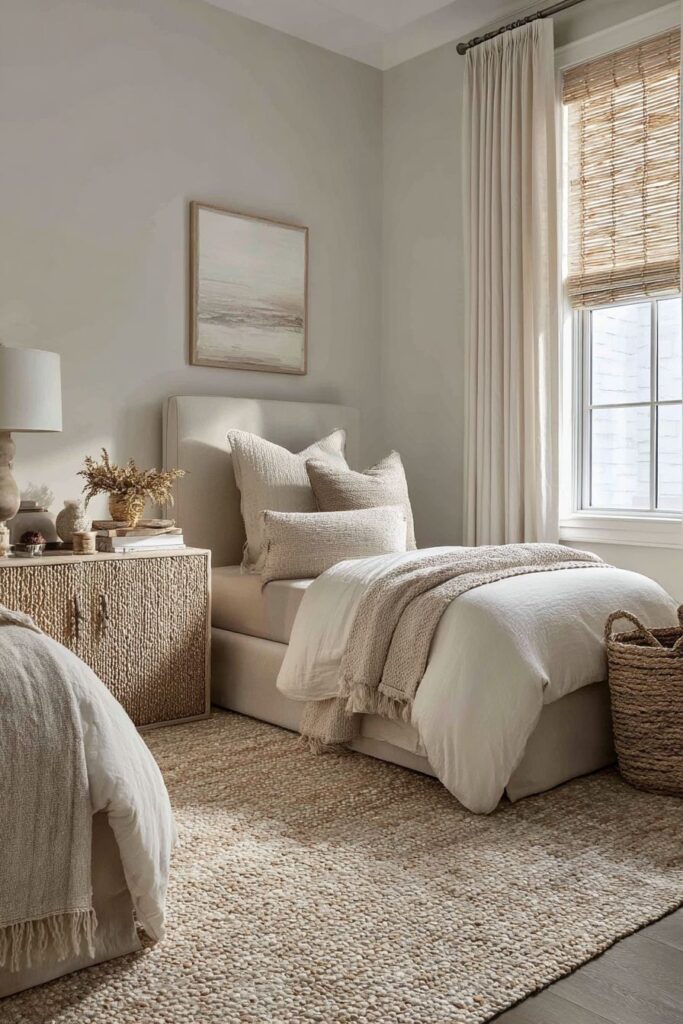
Nature-inspired design creates serenity through organic materials and earth-toned palettes. Two upholstered twin beds in natural linen fabric establish the foundation of this calming approach, their neutral tone and organic textile providing visual rest while offering textural interest through linen’s characteristic slubs and variations. The natural fiber choice connects the room to sustainable, environmentally-conscious design while providing breathable, comfortable sleeping surfaces.
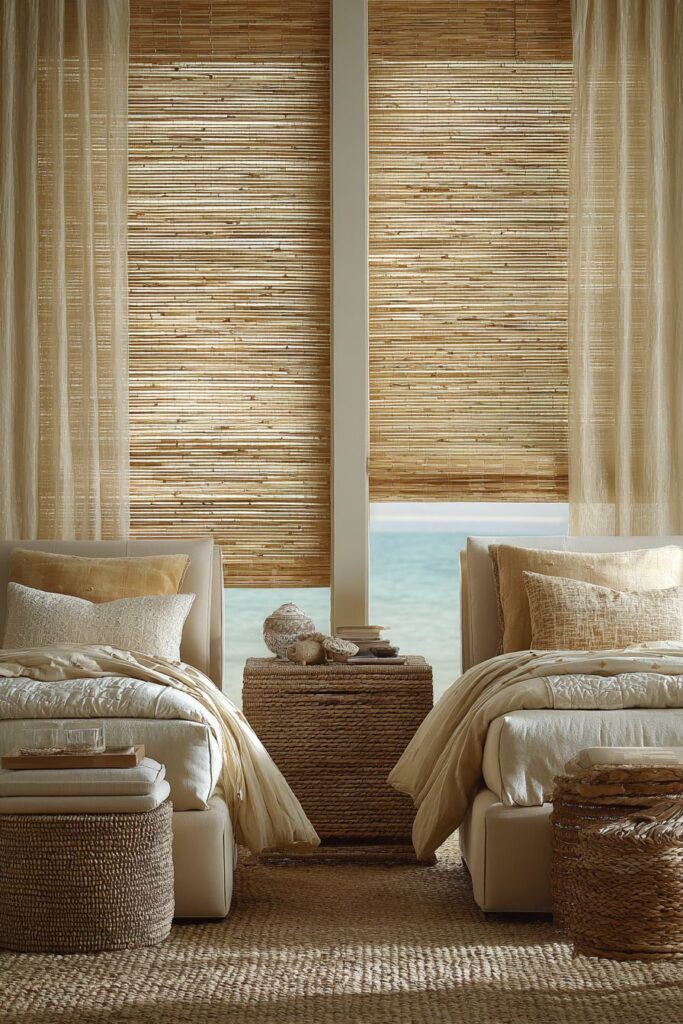
Layered bedding in cream, beige, and soft taupe creates serene comfort through subtle tonal variations. This approach to layering—using multiple shades within a narrow range—adds visual depth without introducing the stimulation of contrasting colors. Each layer contributes to the overall sense of calm, creating a cocoon-like environment perfect for rest and relaxation. The natural color progression from cream through beige to taupe mirrors the gentle gradations found in natural materials like sand, stone, and wood.

Matching grasscloth nightstands with woven texture add organic elements while providing functional storage. Grasscloth introduces subtle pattern through its natural fiber variations, adding visual interest that remains calm and understated. The woven texture catches light differently throughout the day, creating ever-changing surface appearance that keeps the space dynamic despite its neutral palette. A jute area rug provides natural foundation with its nubby texture and earthy tone, while bamboo Roman shades filter gentle daylight in a manner that enhances the room’s connection to natural materials and sustainable design.
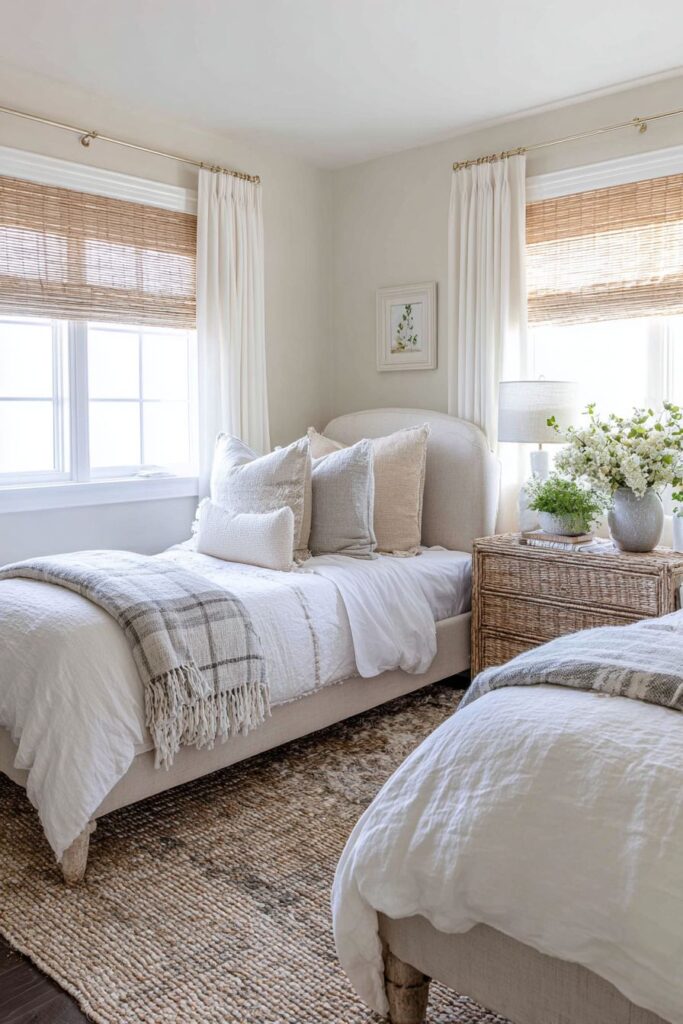
Key Design Tips:
- Select linen-upholstered beds for natural texture and breathable comfort
- Layer bedding in multiple neutral tones for depth within calm palette
- Choose grasscloth or natural fiber nightstands for organic texture
- Add jute or sisal area rugs for earthy, sustainable grounding
- Install bamboo or natural woven window treatments
- Embrace natural color variations and material imperfections
- Create tonal layering within neutral earth-tone palette
- Prioritize sustainable, natural materials throughout the space
16. Mid-Century Modern Retro Twin Bedroom
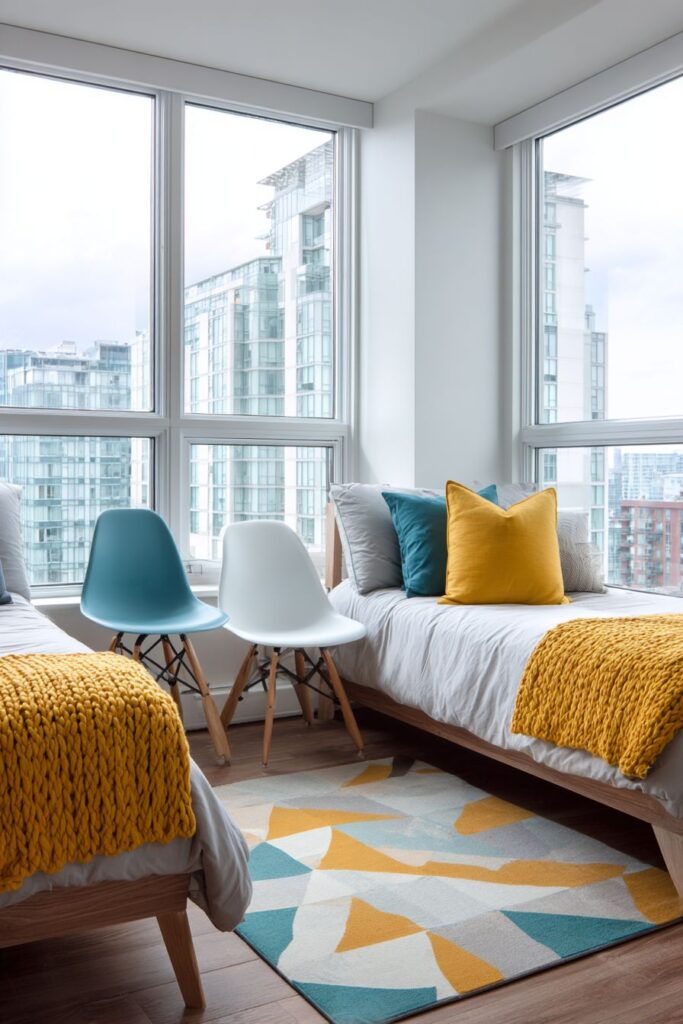
Mid-century modern design celebrates the optimistic aesthetics of the 1950s and 1960s, characterized by clean lines, organic curves, and distinctive color palettes. Two walnut platform beds with tapered legs and clean lines embody this iconic style perfectly. The rich walnut wood provides warmth and sophistication while the tapered legs—thicker at the top, narrowing toward the floor—create the distinctive silhouette that defines mid-century furniture. These beds demonstrate how the period’s designers elevated simple forms into timeless design classics.
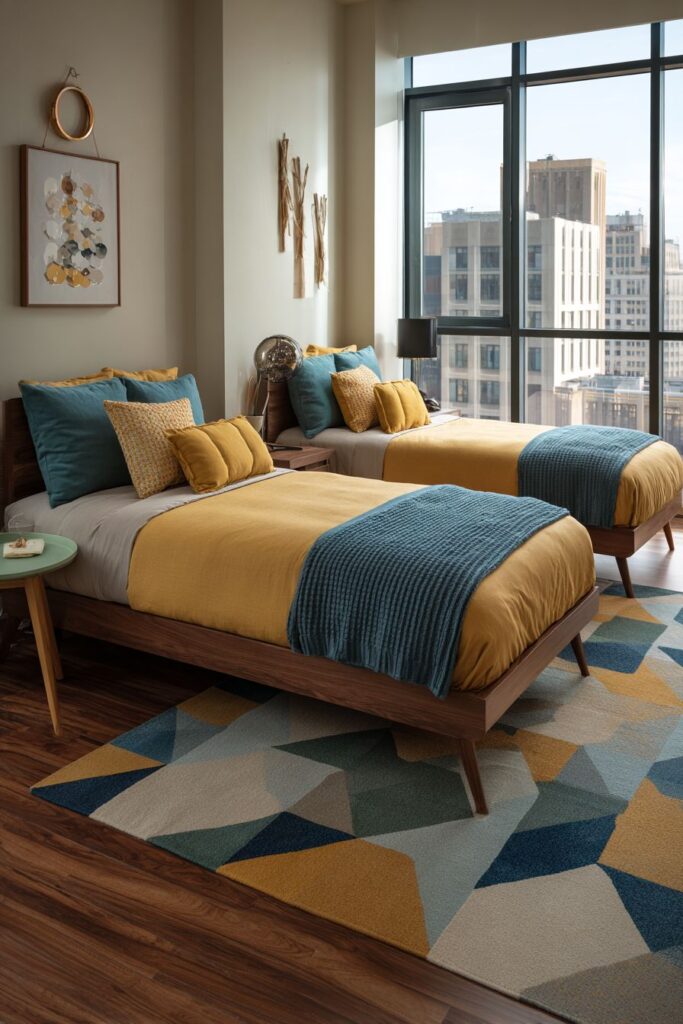
Bedding in mustard yellow and teal creates retro color blocking that’s unmistakably mid-century. These saturated, slightly muted tones were period favorites, bringing optimism and energy without the harshness of primary colors. The color blocking approach—large fields of single colors rather than patterns—reflects the era’s embrace of bold simplicity and graphic impact. These choices create visual excitement while maintaining the clean aesthetic essential to the style.
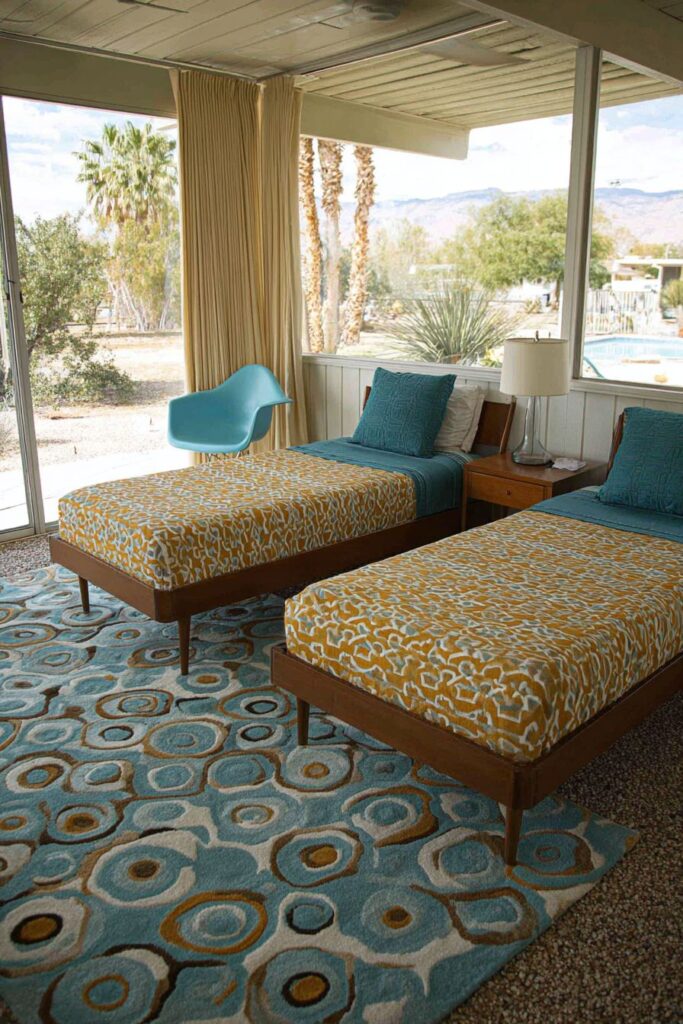
Iconic molded plastic chairs serve as bedside surfaces, demonstrating mid-century design’s innovative use of new materials and manufacturing techniques. These sculptural pieces function as both furniture and art objects, their organic curves and space-age materials representing the period’s forward-thinking optimism. A geometric area rug in complementary colors anchors the design with its abstract patterns typical of mid-century textile design. Large windows with minimal treatments flood the space with natural light, reflecting the era’s embrace of indoor-outdoor living and rejection of heavy, light-blocking window dressings.
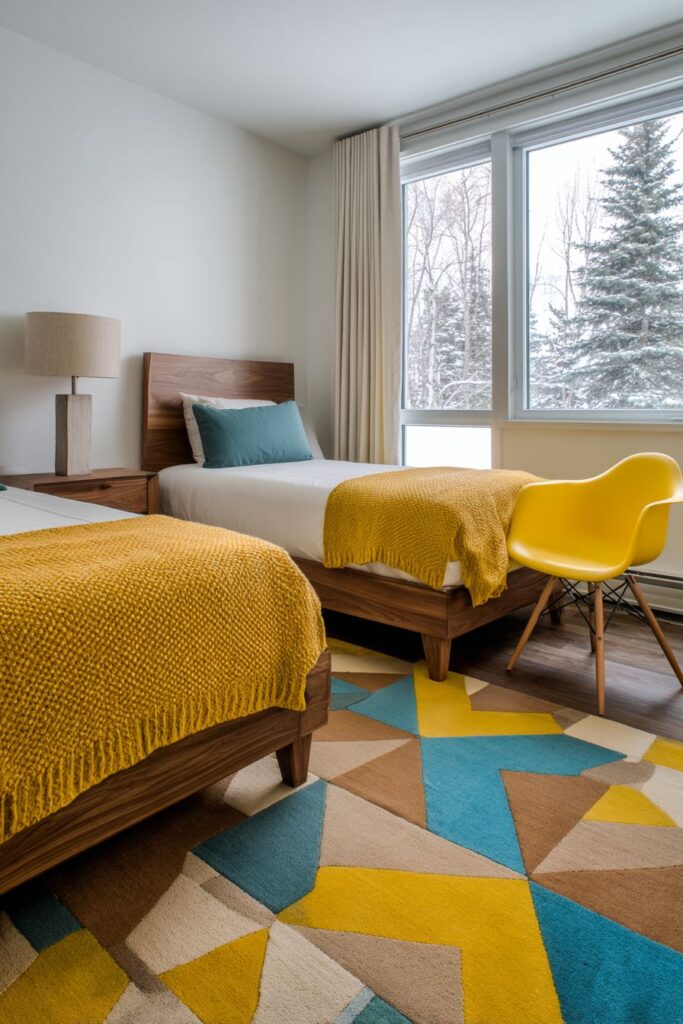
Key Design Tips:
- Choose walnut furniture with tapered legs for authentic mid-century silhouettes
- Use bold retro colors like mustard yellow, teal, and orange in color-blocked patterns
- Incorporate iconic mid-century pieces like molded plastic chairs
- Select geometric rugs with abstract patterns in period-appropriate colors
- Maximize natural light with large windows and minimal treatments
- Embrace clean lines and organic curves simultaneously
- Mix warm wood tones with bold accent colors
- Celebrate innovative materials and manufacturing techniques of the era
17. Practical Family-Friendly Kids Twin Bedroom
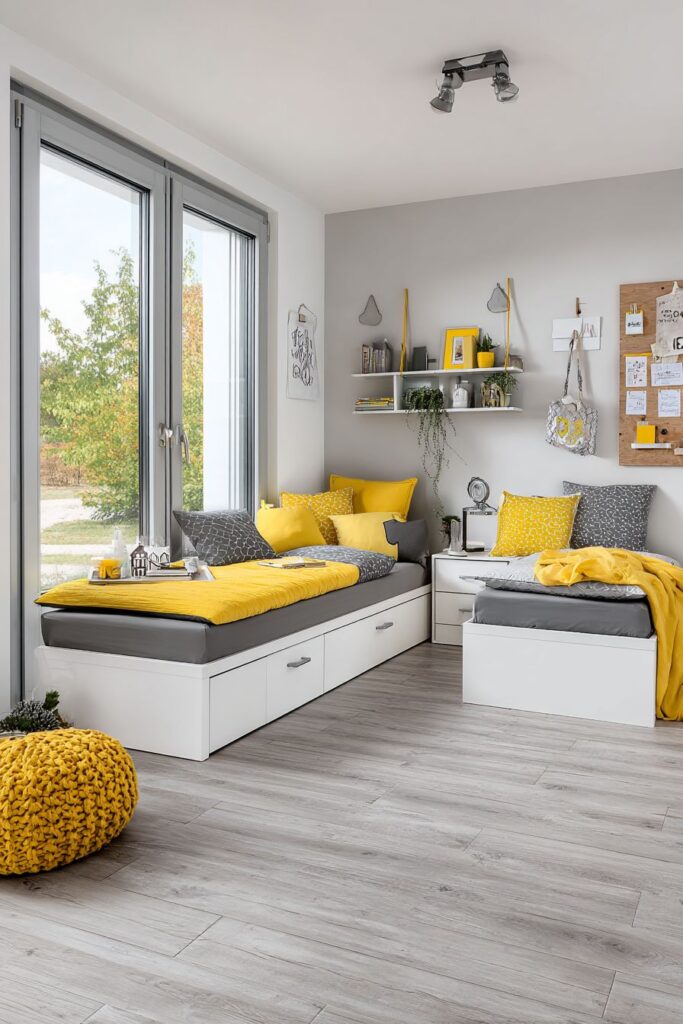
Designing shared children’s bedrooms requires balancing durability with age-appropriate appeal. Two twin beds featuring built-in trundle storage underneath demonstrate practical thinking for active households. These hidden storage compartments provide essential space for toys, extra bedding, or seasonal clothing while keeping the room organized and floor space clear for play. The trundle design also offers flexibility for sleepovers, accommodating additional guests when needed.
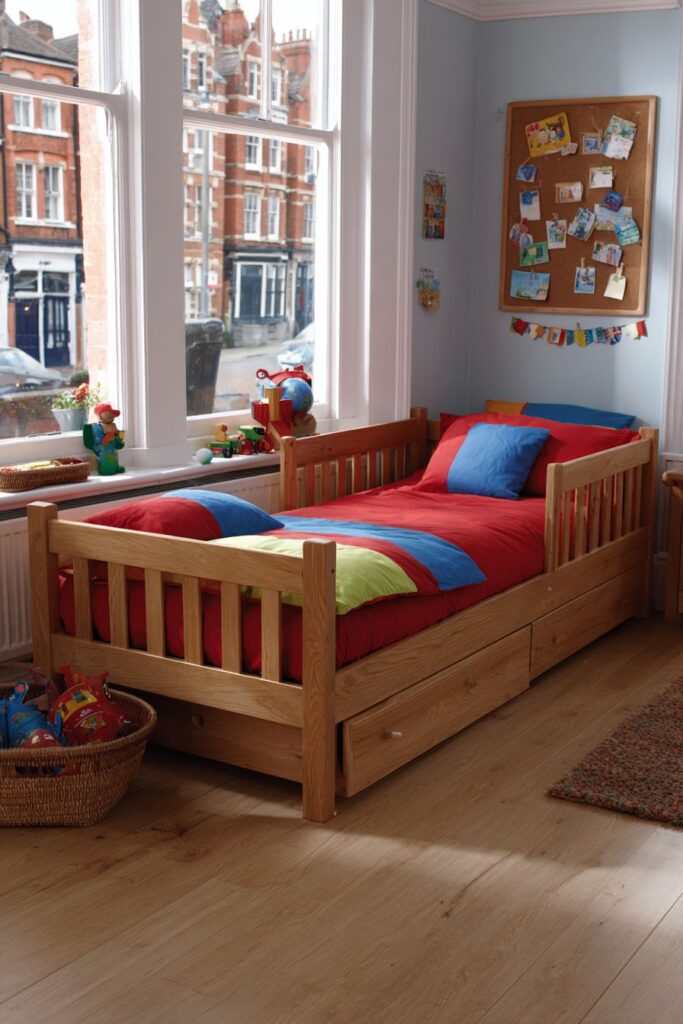
Durable bedding in wipeable fabrics shows coordinating primary colors that appeal to children while standing up to daily wear. The practical fabric choice acknowledges the reality of spills, accidents, and frequent washing that comes with children’s bedrooms. Primary colors provide visual stimulation and cheerful energy appropriate for young occupants while coordinating to create cohesive design rather than chaotic clutter.
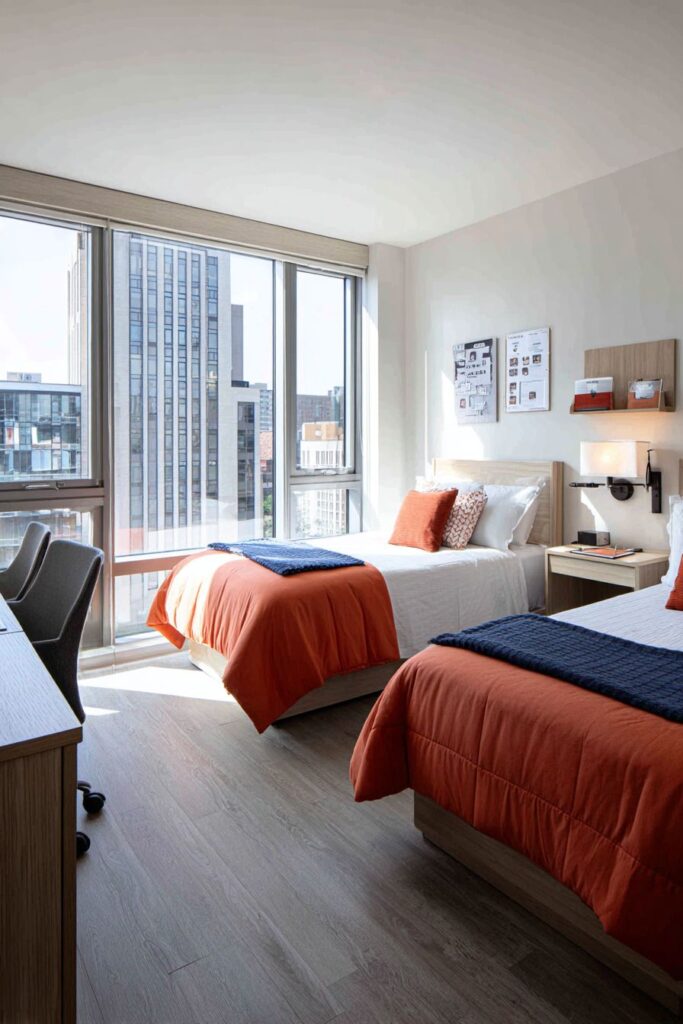
Individual clip-on reading lights and personal pinboards create defined zones within the shared space, giving each child a sense of ownership and personal territory. These simple additions acknowledge each child’s need for individual expression and privacy within the shared environment. Laminate flooring in light wood tone withstands active use while maintaining attractive appearance—a crucial consideration in spaces that serve as bedrooms, playrooms, and activity centers. Natural daylight from safety-glazed windows provides illumination while prioritizing child safety through impact-resistant glass.
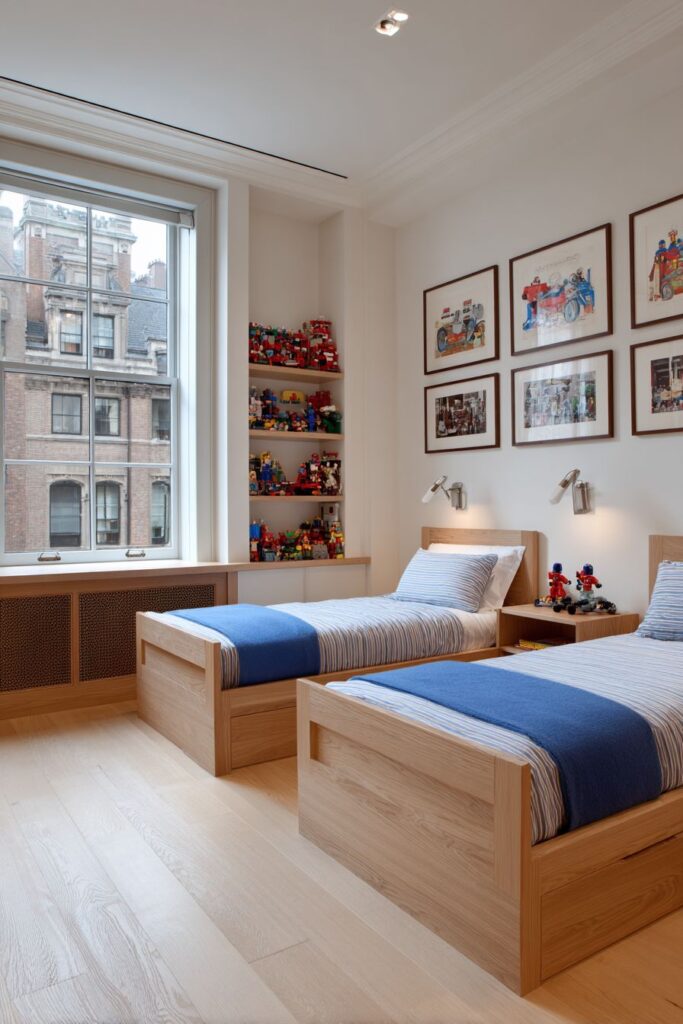
Key Design Tips:
- Select beds with built-in trundle storage for flexible sleeping and storage options
- Choose wipeable, durable fabrics that withstand frequent cleaning
- Use coordinating primary colors for cheerful, age-appropriate appeal
- Install personal lighting and display areas for individual expression
- Opt for laminate or other durable flooring that resists wear and cleaning
- Prioritize safety features like impact-resistant window glazing
- Design for multiple functions: sleeping, playing, studying
- Create distinct personal zones within the shared space
18. Serene Japanese-Inspired Zen Twin Bedroom
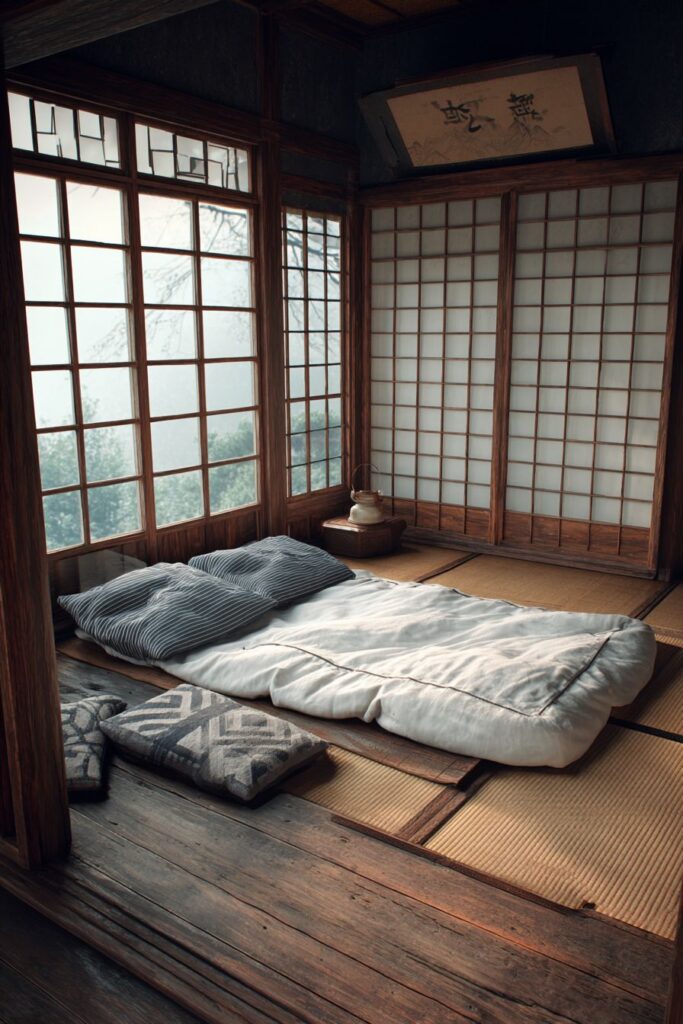
Japanese-inspired design emphasizes simplicity, natural materials, and thoughtful minimalism. Two low platform beds in dark stained oak establish the room’s zen aesthetic with their ground-hugging profiles and honest material beauty. The low height creates different spatial proportions, making the room feel larger and more peaceful while connecting occupants more closely to the earth—a principle valued in Japanese design philosophy. The dark oak provides rich, meditative color while showcasing the wood’s natural grain patterns.
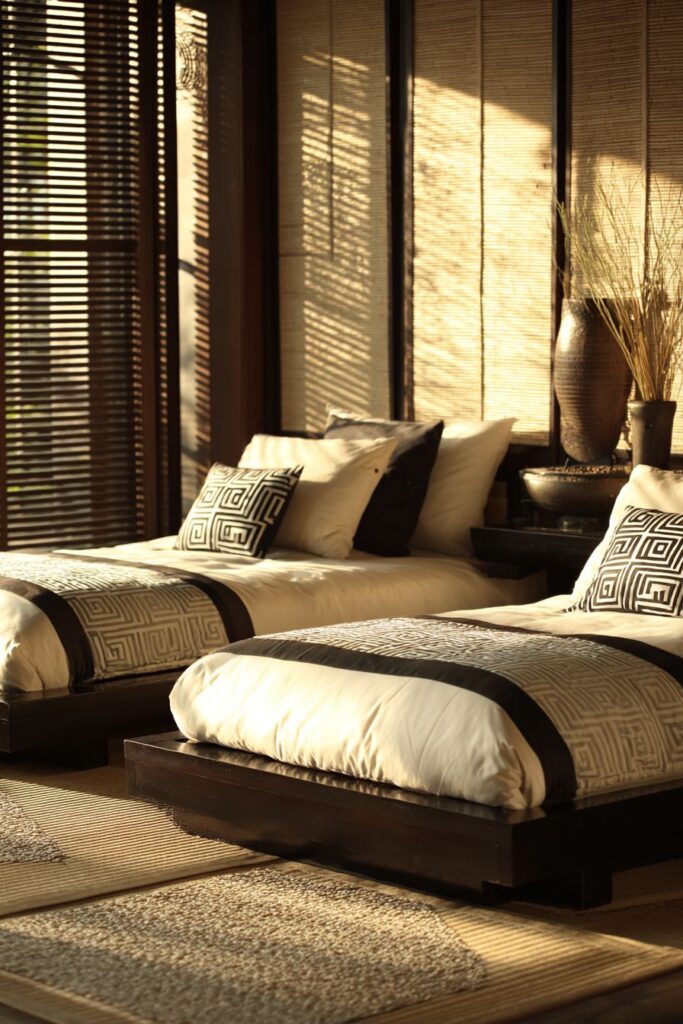
Minimal bedding in white and charcoal with simple geometric patterns maintains the zen aesthetic through restrained design choices. The limited palette and clean patterns reflect Japanese principles of simplicity and intentionality—every element serves purpose without excess. The geometric patterns, often inspired by traditional Japanese motifs, add subtle visual interest without disturbing the room’s essential calm.
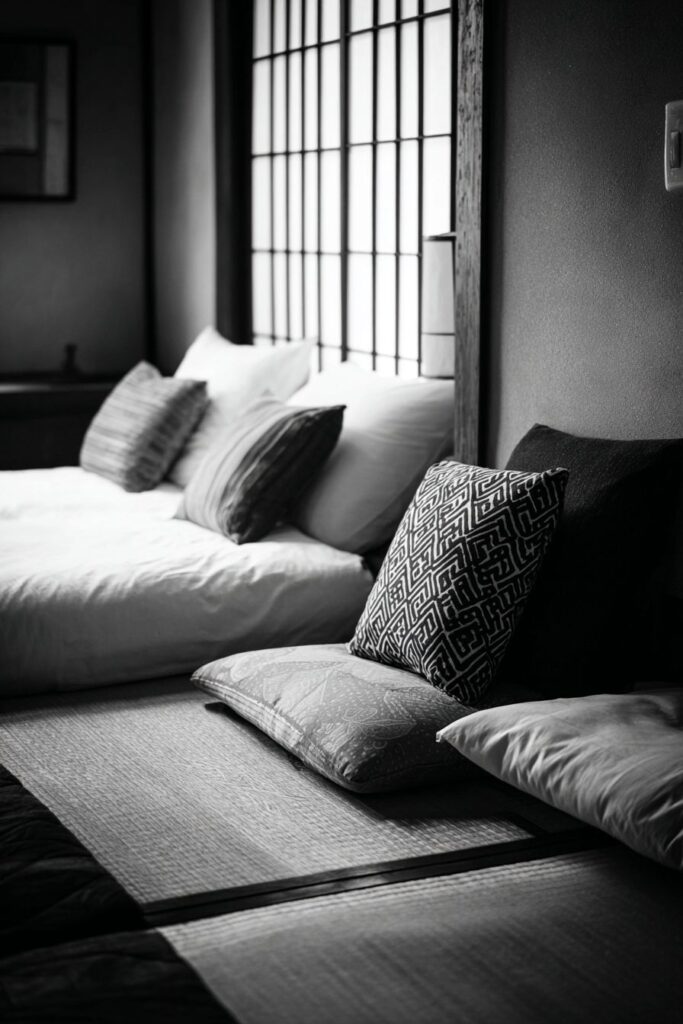
Shoji-style sliding panels separate sleeping areas when needed, providing flexible privacy without permanent walls. These translucent screens filter light beautifully while maintaining connection between spaces, embodying Japanese design’s preference for fluid, adaptable spaces over rigid room divisions. Tatami mat-style area rugs add authentic texture with their woven patterns and natural materials, while soft filtered light through rice paper window coverings creates tranquil ambiance. The diffused, even illumination eliminates harsh shadows and creates the peaceful atmosphere essential to zen-inspired spaces.
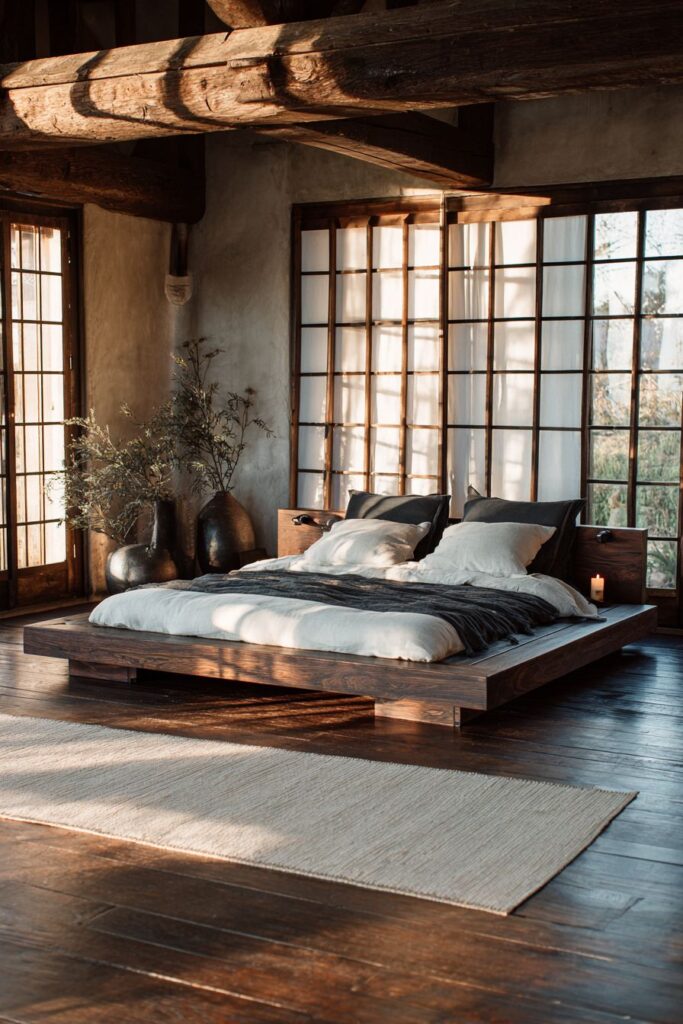
Key Design Tips:
- Choose low platform beds in dark wood for grounding zen aesthetic
- Use minimal bedding in neutral palette with simple geometric patterns
- Install shoji-style sliding panels for flexible, light-filtering room division
- Add tatami or tatami-inspired rugs for authentic texture and natural materials
- Use rice paper or similar translucent window coverings for soft, filtered light
- Embrace negative space as essential design element
- Maintain strict simplicity in all design choices
- Prioritize natural materials and honest construction
19. Bright White All-White Twin Bedroom
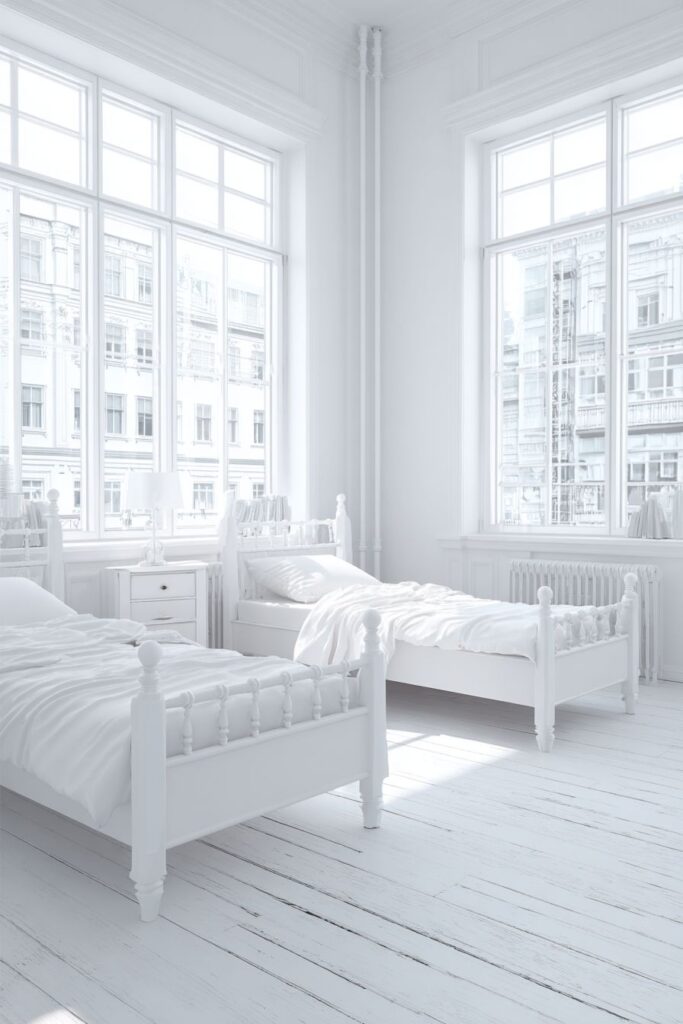
An all-white design approach creates rooms that feel fresh, clean, and infinitely peaceful. Two identical twin beds with white-painted wooden frames and spindle details establish cottage charm while maintaining the crisp monochromatic palette. The spindle details add visual interest and traditional craftsmanship without introducing color, demonstrating how texture and form can create variety within strict color limitations.
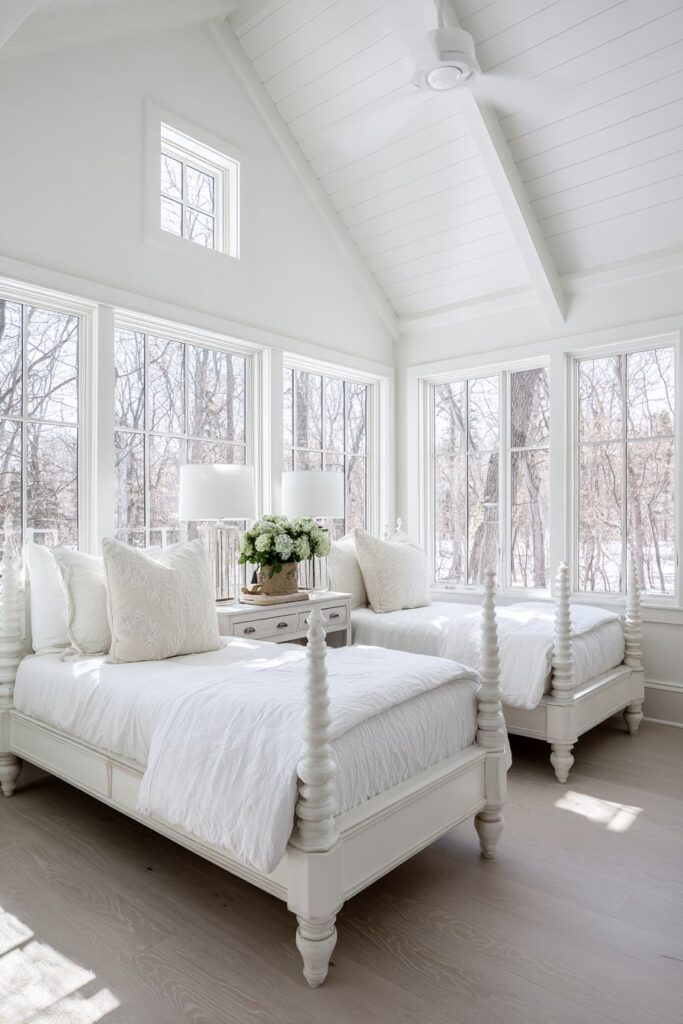
All-white bedding with subtle texture variations maintains the fresh, clean palette while preventing the room from feeling flat or sterile. Different white textiles—smooth cotton, nubby linen, soft fleece—create dimensional interest through their varied surfaces and the way they interact with light. This layering of whites proves that monochromatic design need not be boring when texture receives proper attention.
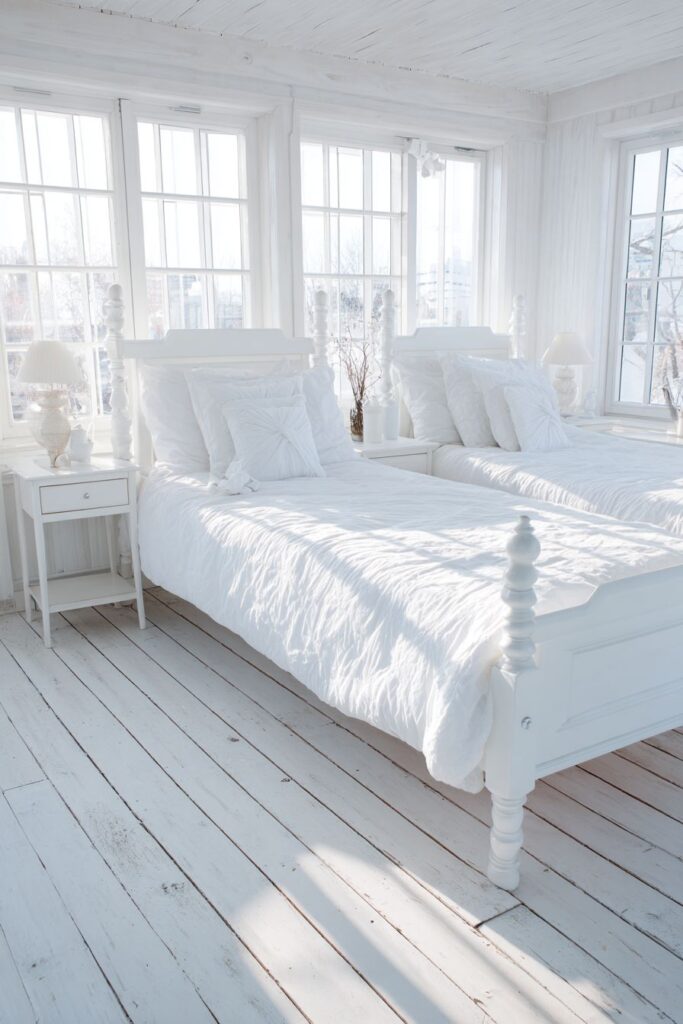
Small white nightstands with single drawers provide essential storage without visual weight. In all-white rooms, every piece becomes part of the unified whole rather than individual objects, creating seamless visual flow that makes spaces feel larger and more serene. Whitewashed oak flooring adds warmth without color, its subtle grain patterns and honey undertones preventing the room from feeling too cool or clinical. Abundant natural light from multiple windows creates an airy feel, the white surfaces reflecting and multiplying the light to create bright, uplifting atmosphere perfect for starting and ending each day.
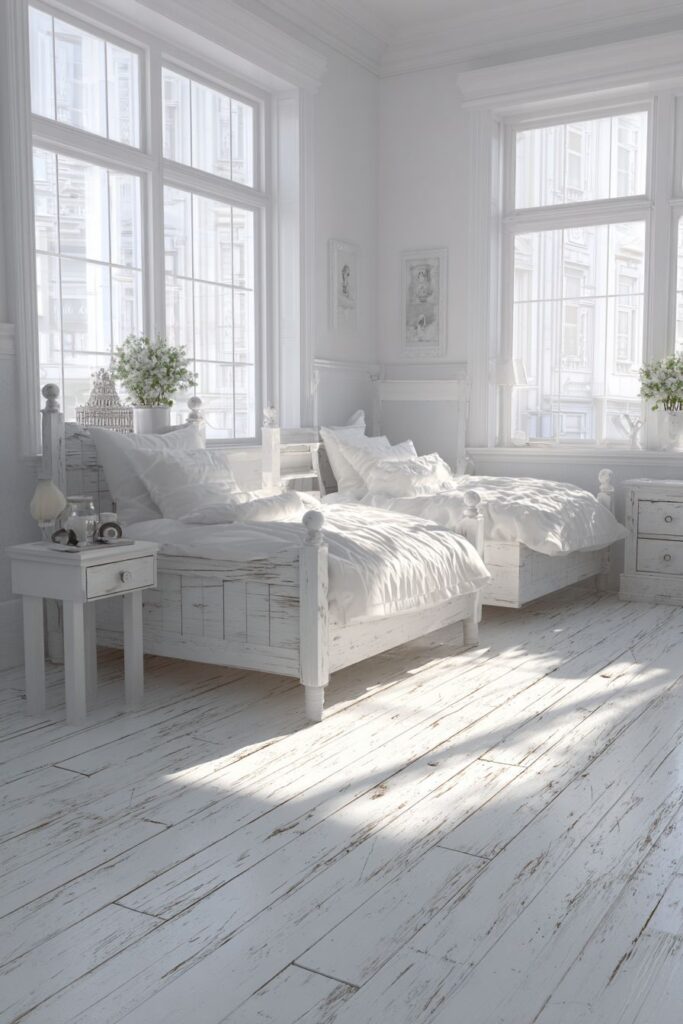
Key Design Tips:
- Use white-painted wood furniture with subtle details for interest without color
- Layer different white textiles for dimensional interest through varied textures
- Choose whitewashed or light natural wood flooring for warmth within white palette
- Maximize natural light through multiple windows with minimal treatments
- Vary textures extensively to prevent monotony in monochromatic scheme
- Keep surfaces clean and uncluttered to maintain crisp, fresh aesthetic
- Use subtle architectural details for visual interest
- Embrace the psychological benefits of bright, clean white environments
20. Budget-Friendly Creative Twin Bedroom
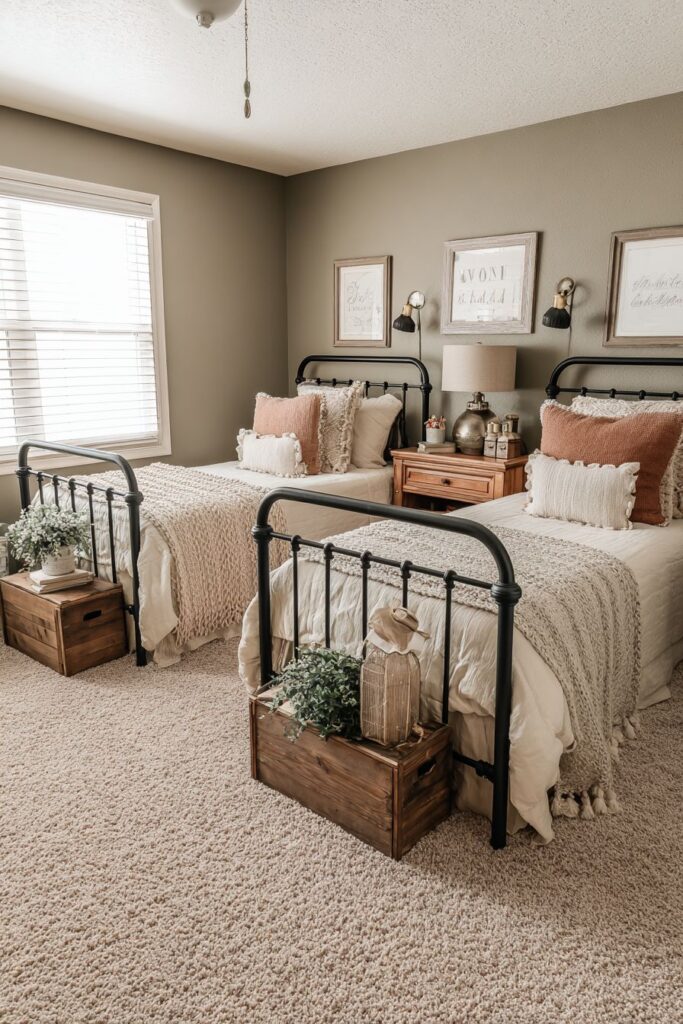
Great design doesn’t require unlimited budgets—creativity and resourcefulness can achieve beautiful results economically. Two simple metal twin bed frames in matte black provide strong visual presence at minimal cost. The basic frames’ straightforward construction keeps prices low while the matte black finish adds contemporary sophistication that belies the modest investment. This demonstrates how smart material and finish choices can elevate even the most basic furniture pieces.
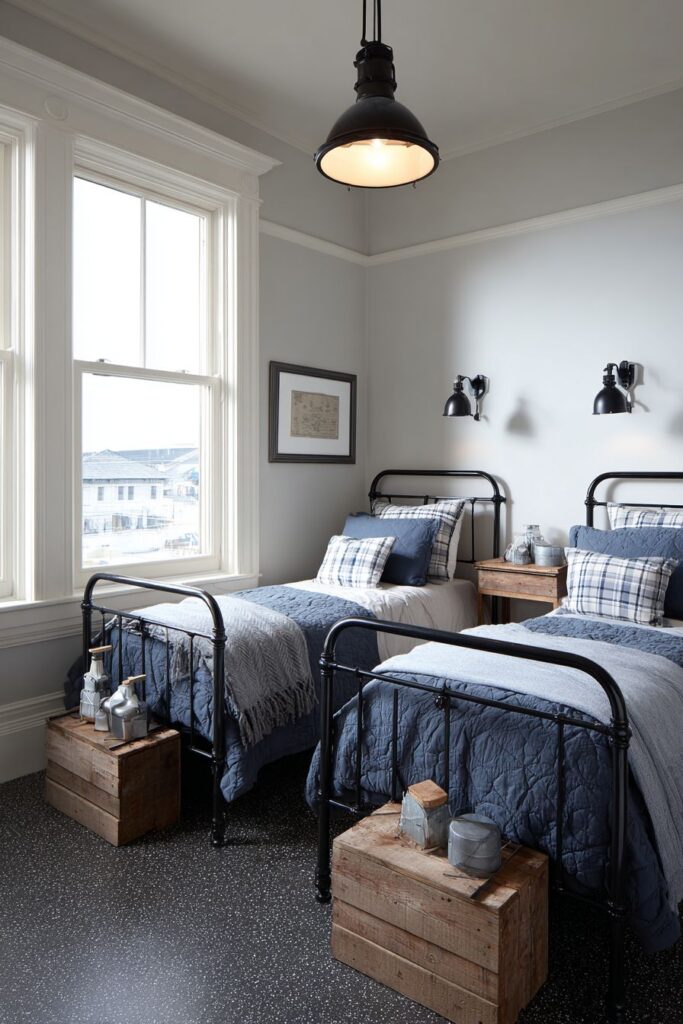
Mix-and-match bedding in coordinating colors creates personalized spaces affordably, allowing each occupant to express individuality without purchasing complete matching sets. By coordinating colors rather than patterns, the room maintains cohesion while accommodating budget-friendly purchasing across different sales, stores, or even second-hand sources. This flexibility makes the room easy to update as tastes change or new bedding needs arise.
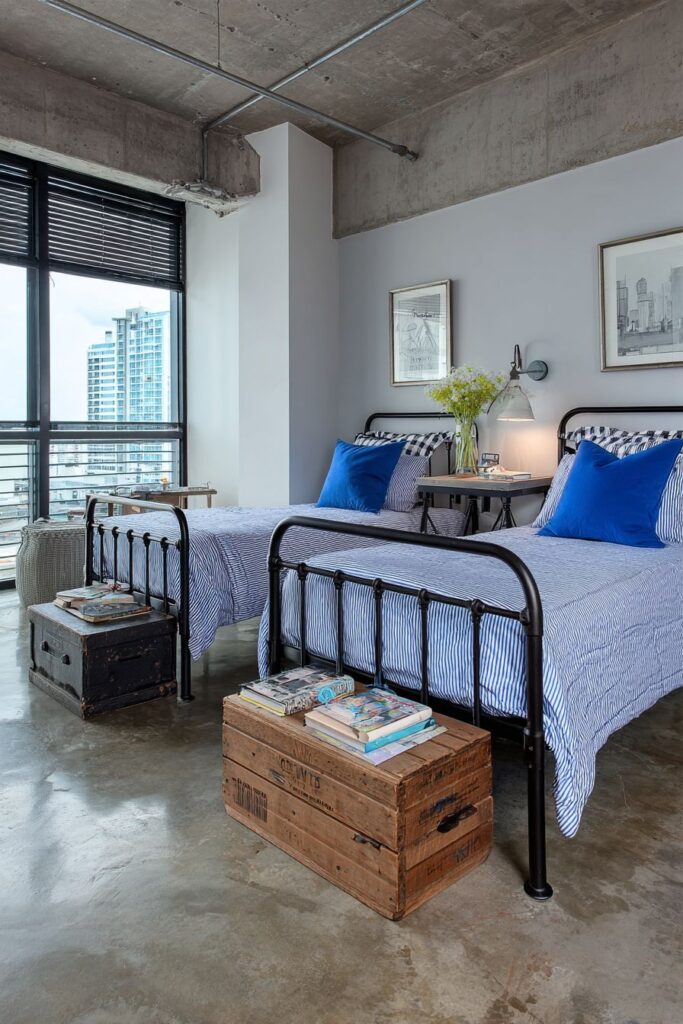
Repurposed wooden crates serve as creative nightstands, demonstrating how recycled materials can provide functional solutions with character. These industrial remnants bring texture, history, and vertical storage at fraction of traditional furniture costs. Painted concrete flooring keeps costs low while maintaining style—a practical choice that creates modern aesthetic without expensive tile or hardwood installation. Natural light from standard windows supplemented by affordable clip lamps proves that effective lighting doesn’t require custom fixtures or professional installation, making this approach accessible to anyone willing to think creatively about design challenges.
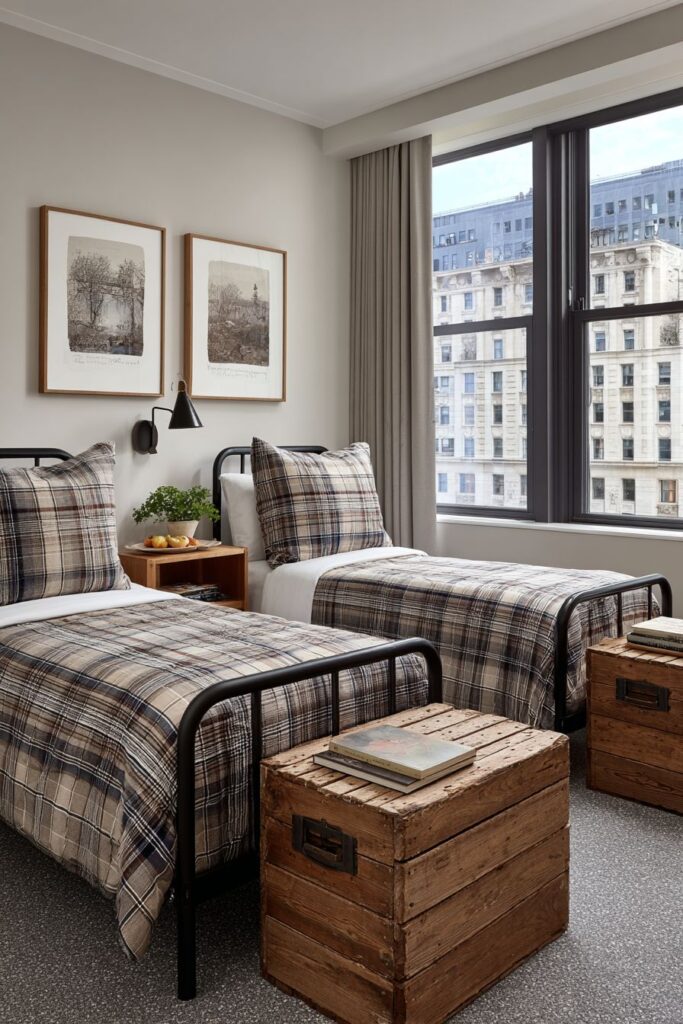
Key Design Tips:
- Select simple metal bed frames in contemporary finishes for affordable style
- Mix coordinating bedding from various sources rather than matching sets
- Repurpose wooden crates, vintage suitcases, or other found objects as nightstands
- Consider painted concrete or other economical flooring solutions
- Use clip lamps and other affordable lighting for flexible, budget-friendly illumination
- Shop sales, second-hand stores, and discount retailers strategically
- Embrace DIY projects and creative repurposing
- Prove that style and budget-consciousness can coexist successfully
Why These Are The Best 2 Single Bed Bedroom Ideas
These twenty carefully curated bedroom designs represent the finest approaches to dual single bed configurations because they address the complete spectrum of needs, styles, and practical considerations that homeowners face. From the space-maximizing genius of the L-shaped configuration to the symmetrical sophistication of matching velvet beds, each design solves specific challenges while maintaining aesthetic excellence. The collection proves that two single bed bedrooms can be just as stylish and intentional as any other room configuration.
The variety of interior design styles represented—from Scandinavian minimalism to bohemian eclecticism, from rustic cabin charm to contemporary sophistication—ensures that every personality and preference finds resonance in these ideas. Whether you’re drawn to the clean lines of mid-century modern design, the romantic details of French country aesthetics, or the raw authenticity of industrial spaces, these bedroom ideas demonstrate how personal style translates successfully into shared sleeping spaces. This diversity is essential because great bedroom design must reflect the occupants’ personalities while creating environments conducive to rest and rejuvenation.
The practical considerations addressed throughout these designs make them not just beautiful but genuinely livable. Smart storage solutions like built-in drawers, multifunctional headboards, and creative nightstand alternatives ensure that even compact bedrooms can accommodate all necessary belongings without sacrificing style. The attention to lighting—from natural daylight optimization to task lighting and ambient illumination—recognizes how crucial proper lighting is to bedroom functionality. These designs work in real homes for real people, not just in styled photographs.
Material selection across these bedroom ideas showcases the importance of texture, quality, and sustainability in creating spaces that stand the test of time. Natural materials like wood, linen, jute, and rattan bring organic warmth and environmental consciousness to bedrooms, while modern innovations like wipeable fabrics and integrated technology address contemporary needs. The careful consideration of durable flooring options, from hardwood to laminate to polished concrete, ensures these rooms remain beautiful through years of use.
Color psychology plays a significant role in bedroom design, and these ideas demonstrate sophisticated understanding of how hues affect mood and perception. The calming neutrals of nature-inspired designs promote relaxation, while the energizing primary colors of children’s rooms support active play. The coastal palette’s blues and whites evoke seaside serenity, while warm terracottas and sage greens create cozy personalized zones. Each color choice is intentional, supporting the room’s purpose and the occupants’ wellbeing.
The emphasis on creating individual identity within shared spaces makes these designs particularly valuable for children’s rooms and guest bedrooms. Personal lighting, distinct bedding choices, individual storage, and defined zones allow each occupant to feel ownership and express personality while the overall design maintains cohesion. This balance between unity and individuality is perhaps the greatest challenge in dual bed bedroom design, and these ideas provide proven solutions.
Budget accessibility is another crucial factor that elevates these designs. While some approaches like the sophisticated velvet bedroom represent luxury investments, others like the budget-friendly creative design prove that financial constraints need not limit aesthetic achievement. The range of price points ensures that beautiful, functional two single bed bedrooms are achievable regardless of budget, democratizing good design and making it accessible to all.
The architectural considerations—from window placement to room proportions to door locations—are thoughtfully addressed in each design. Beds positioned to flank windows, L-shaped configurations for challenging room shapes, and symmetrical layouts for balanced spaces demonstrate how great design works with existing architecture rather than fighting against it. These practical solutions help homeowners maximize their specific spaces, whatever the challenges.
Finally, these bedroom ideas succeed because they recognize that bedrooms serve multiple functions beyond just sleeping. They accommodate reading, working, playing, relaxing, and socializing while maintaining the peaceful atmosphere essential to rest. The inclusion of desk areas, reading lights, display space, and comfortable rugs creates true multi-functional environments that adapt to modern lifestyles. This holistic approach to bedroom design—considering all the ways we actually use these spaces—sets these ideas apart as genuinely comprehensive solutions.
Conclusion
Designing a bedroom with two single beds presents unique opportunities for creative expression and practical problem-solving. Whether you’re drawn to the bright simplicity of Scandinavian design, the romantic charm of French country aesthetics, the bold statements of industrial style, or the peaceful serenity of Japanese-inspired minimalism, the perfect dual bed configuration awaits your personal interpretation. The twenty ideas explored in this comprehensive guide demonstrate that shared bedrooms can be just as beautiful, thoughtful, and well-designed as any other space in your home.
The key to success lies in thoughtful consideration of your specific needs, available space, personal style preferences, and budget constraints. Don’t be afraid to mix elements from different designs—perhaps combining the storage solutions of the compact urban bedroom with the color palette of the coastal theme, or merging the material choices of the modern farmhouse with the symmetry of the sophisticated design. Great interior design is ultimately personal, reflecting the unique combination of practical needs and aesthetic desires that make your space truly yours.
Remember that bedroom design is not static—it evolves with changing needs, growing children, shifting tastes, and new inspirations. Start with the foundational elements like bed frames and major furniture pieces, then layer in textiles, lighting, and accessories that can be easily updated as your vision develops. The most successful bedrooms are those that grow and change with their occupants, remaining fresh and relevant through different life stages and style evolutions.
We encourage you to experiment with these ideas, adapting them to your specific circumstances and preferences. Take inspiration from the color palettes, furniture arrangements, material choices, and styling details that resonate with you, then make them your own through personal touches and unique interpretations. Your perfect two single bed bedroom is waiting to be created—let these ideas be the starting point for a space that’s beautiful, functional, and uniquely yours.
